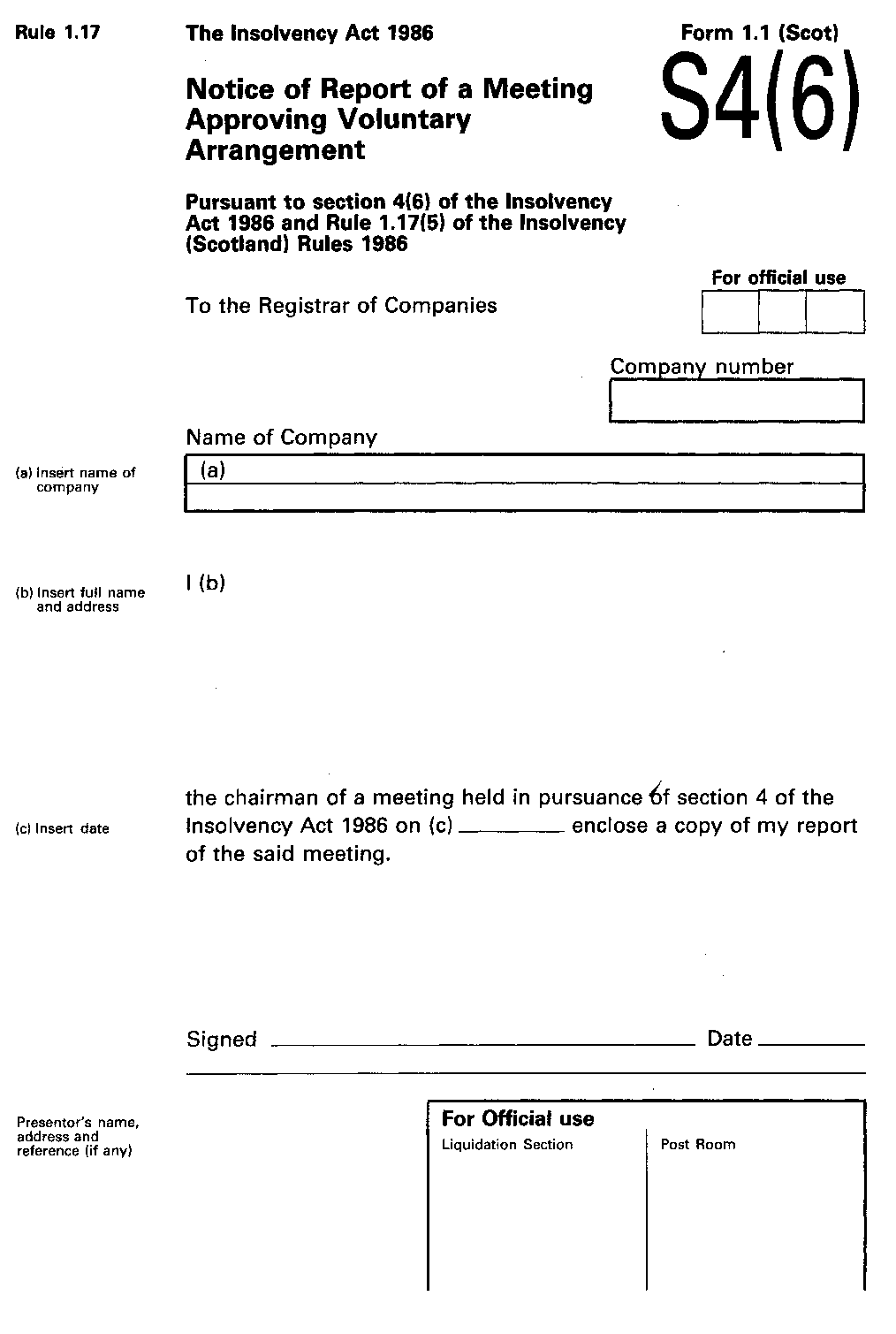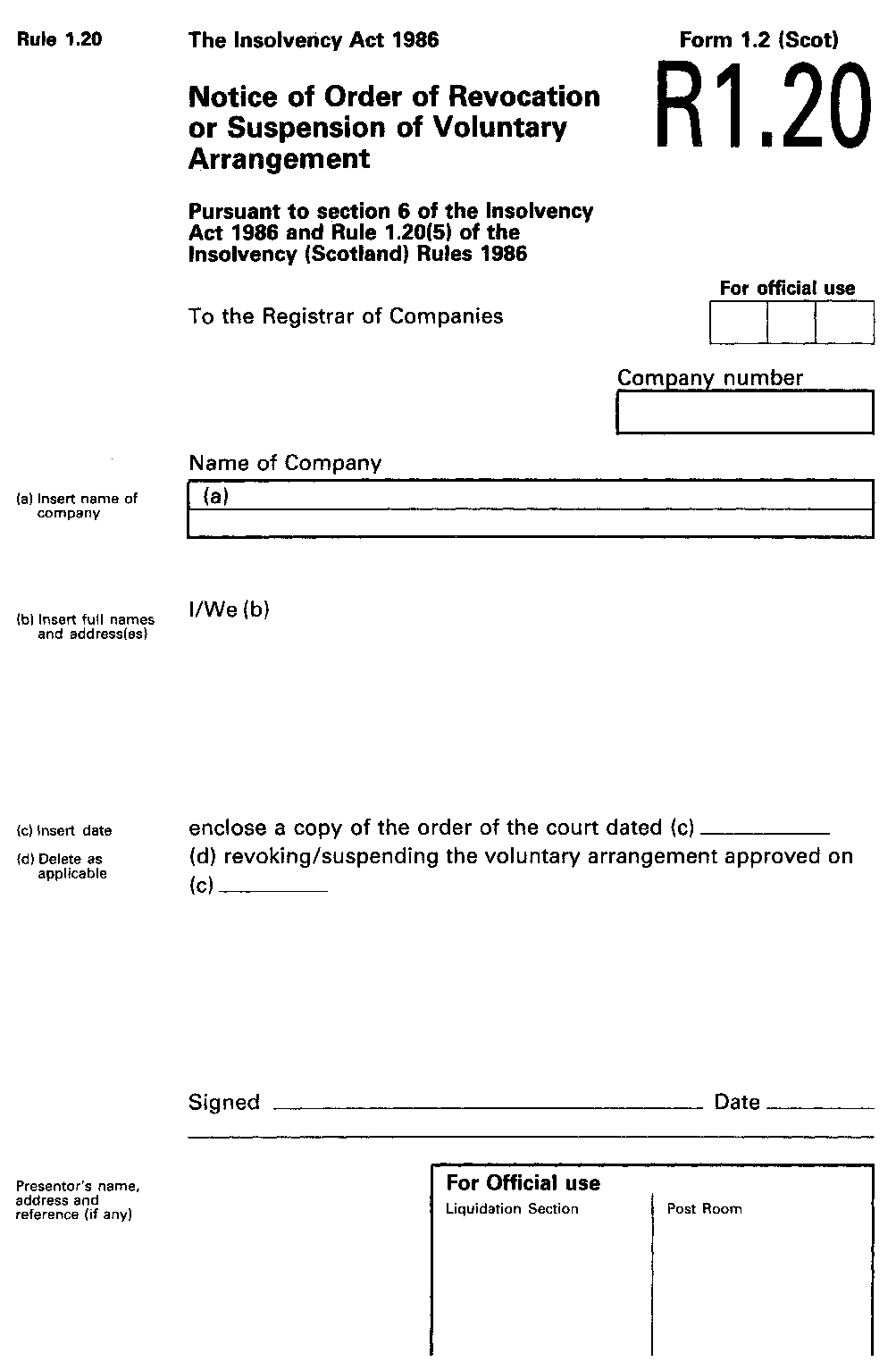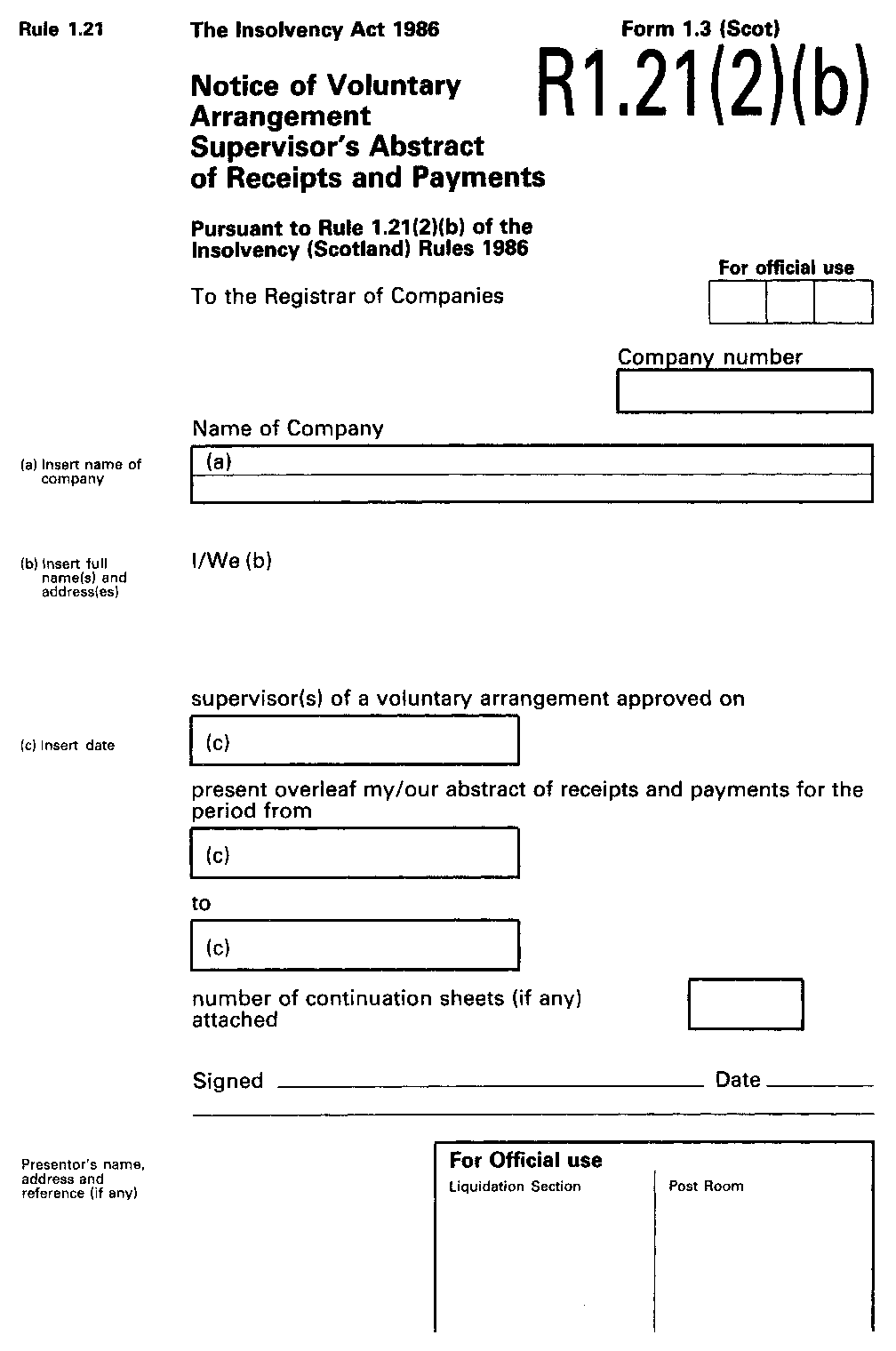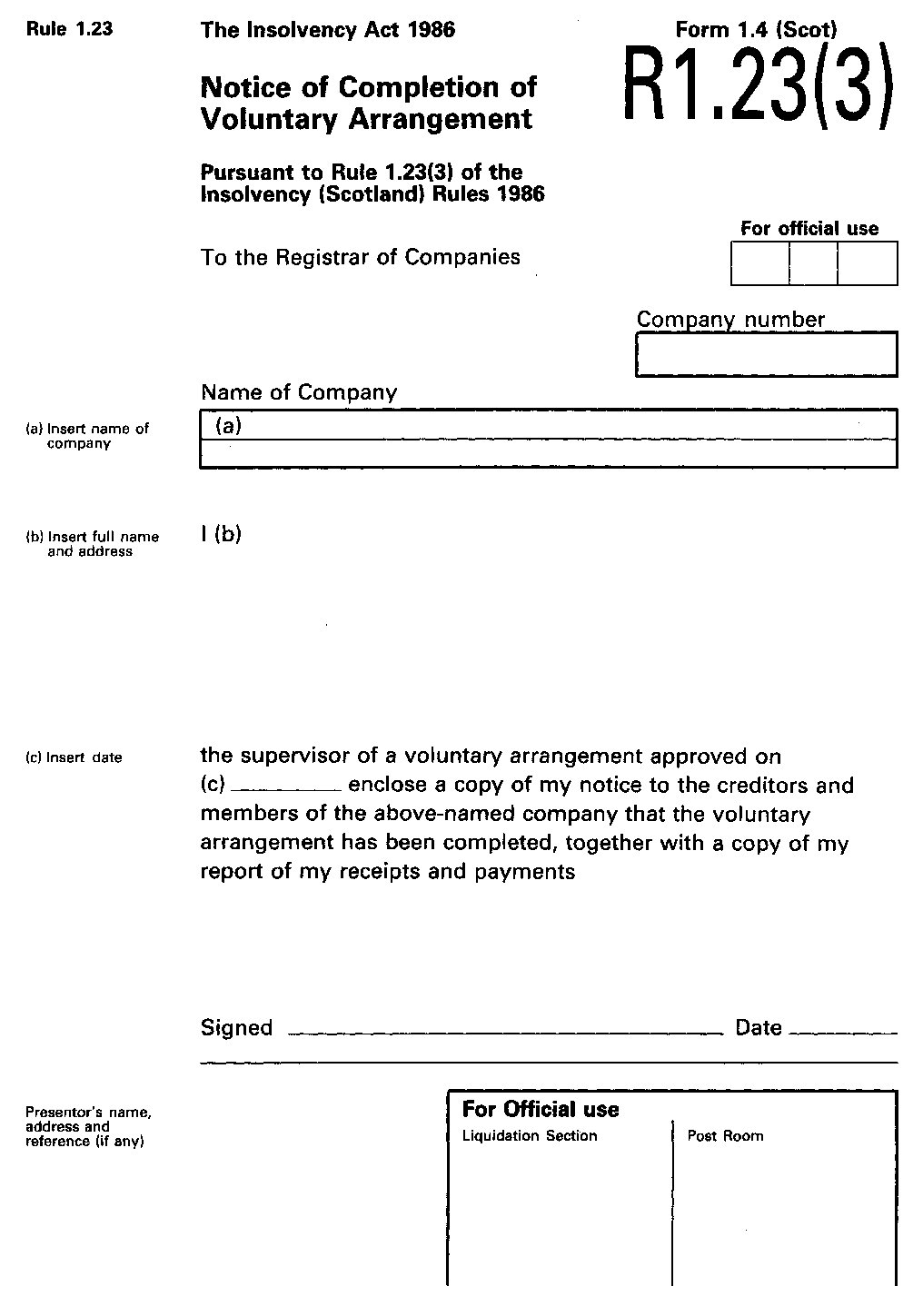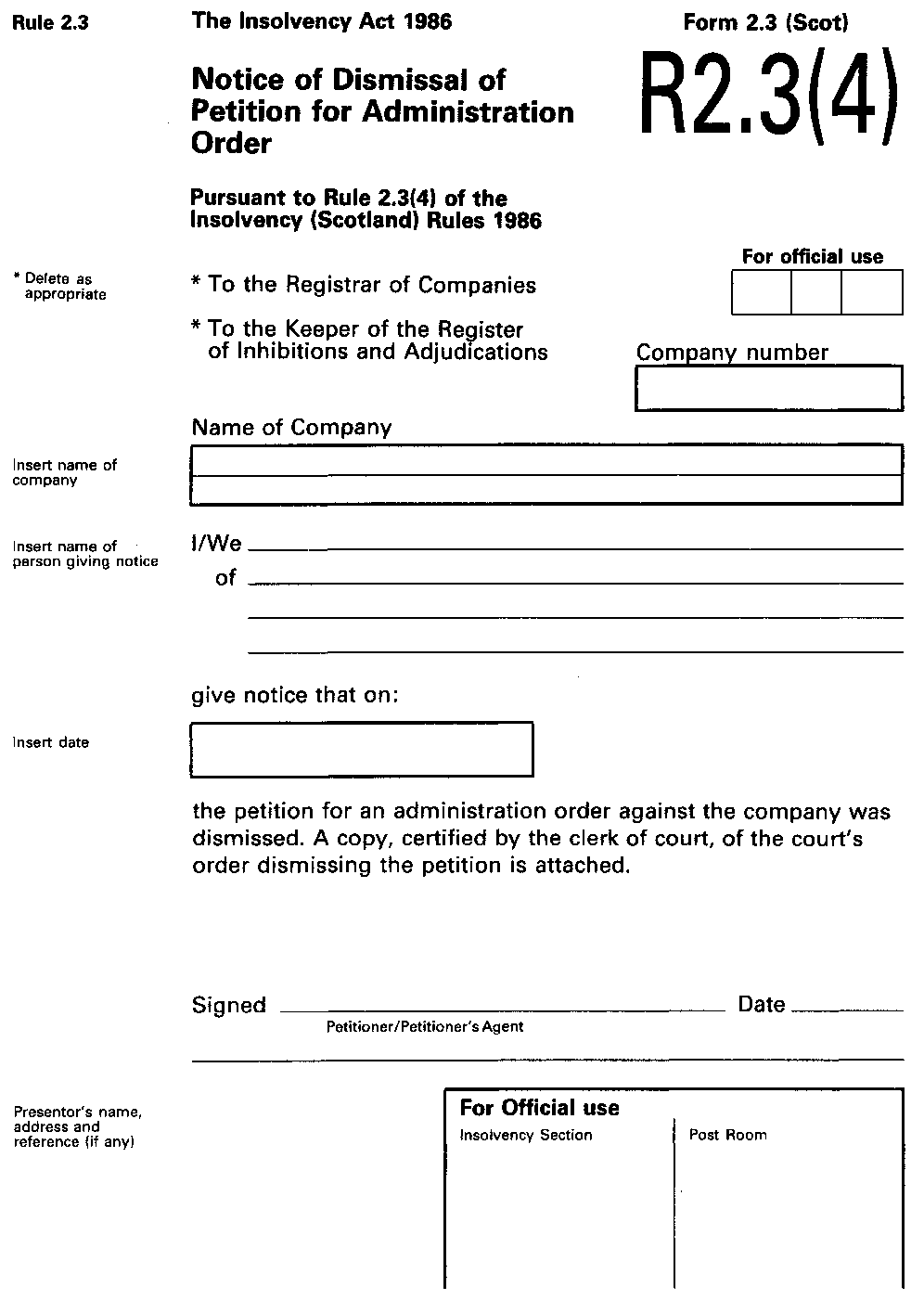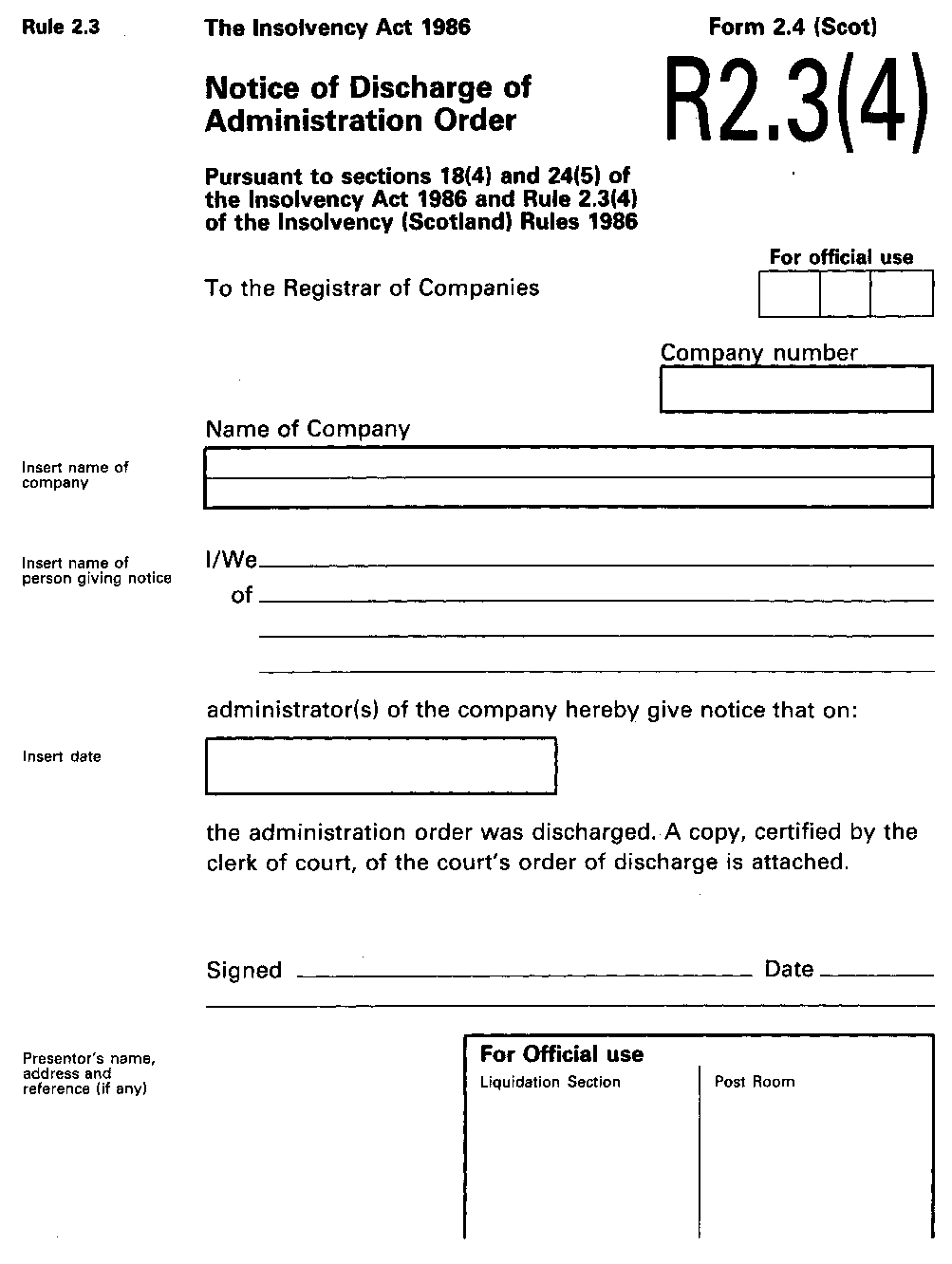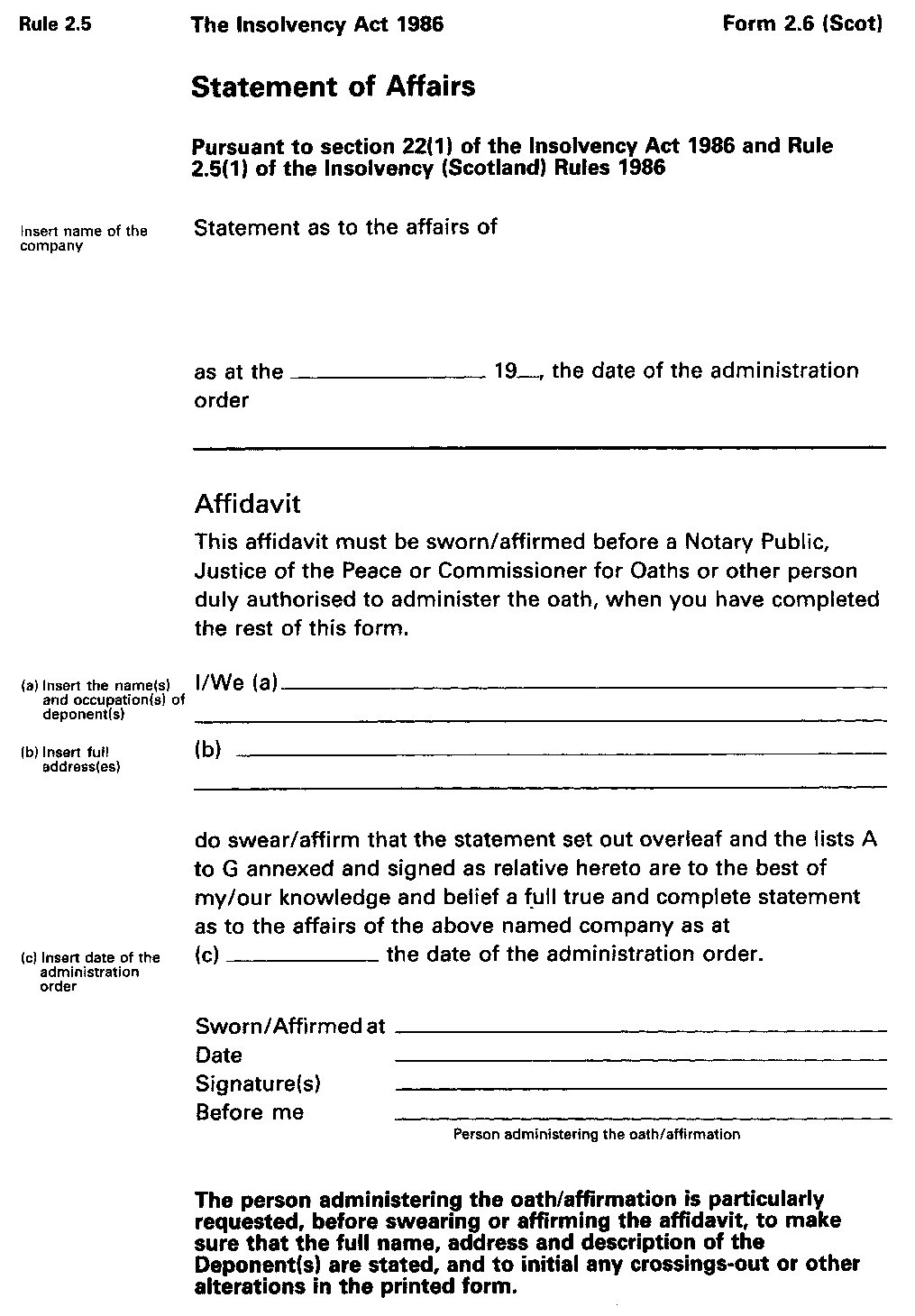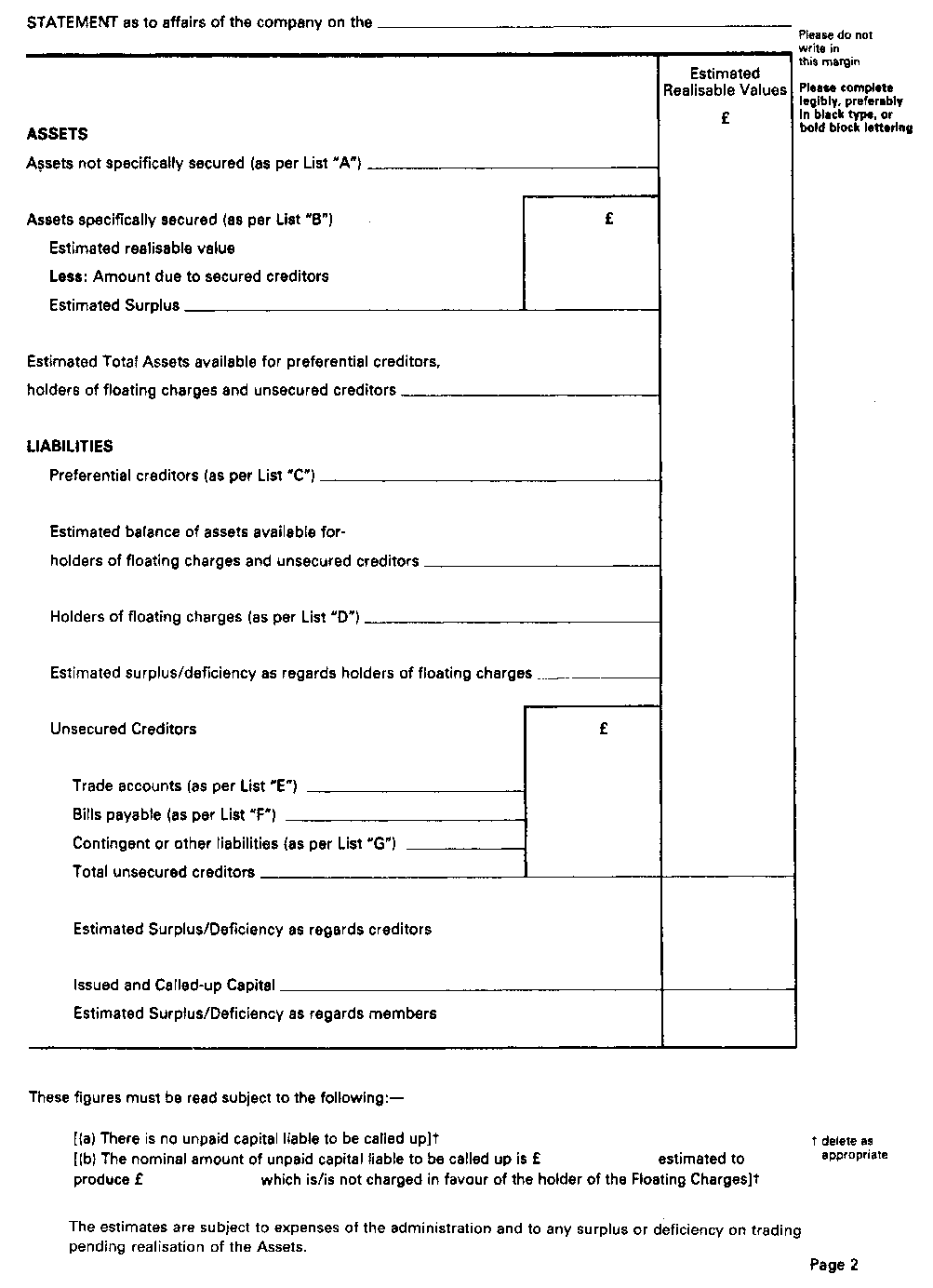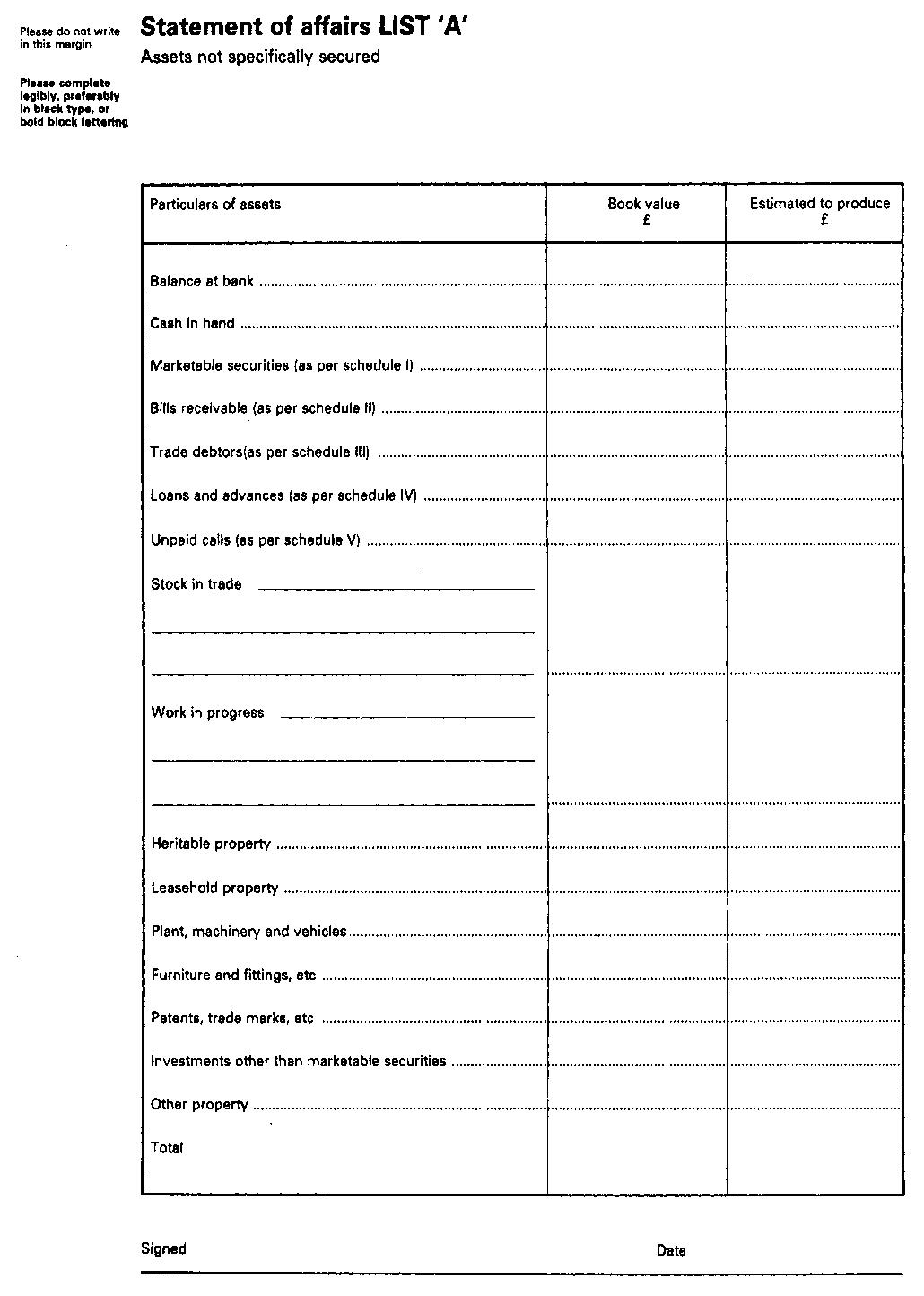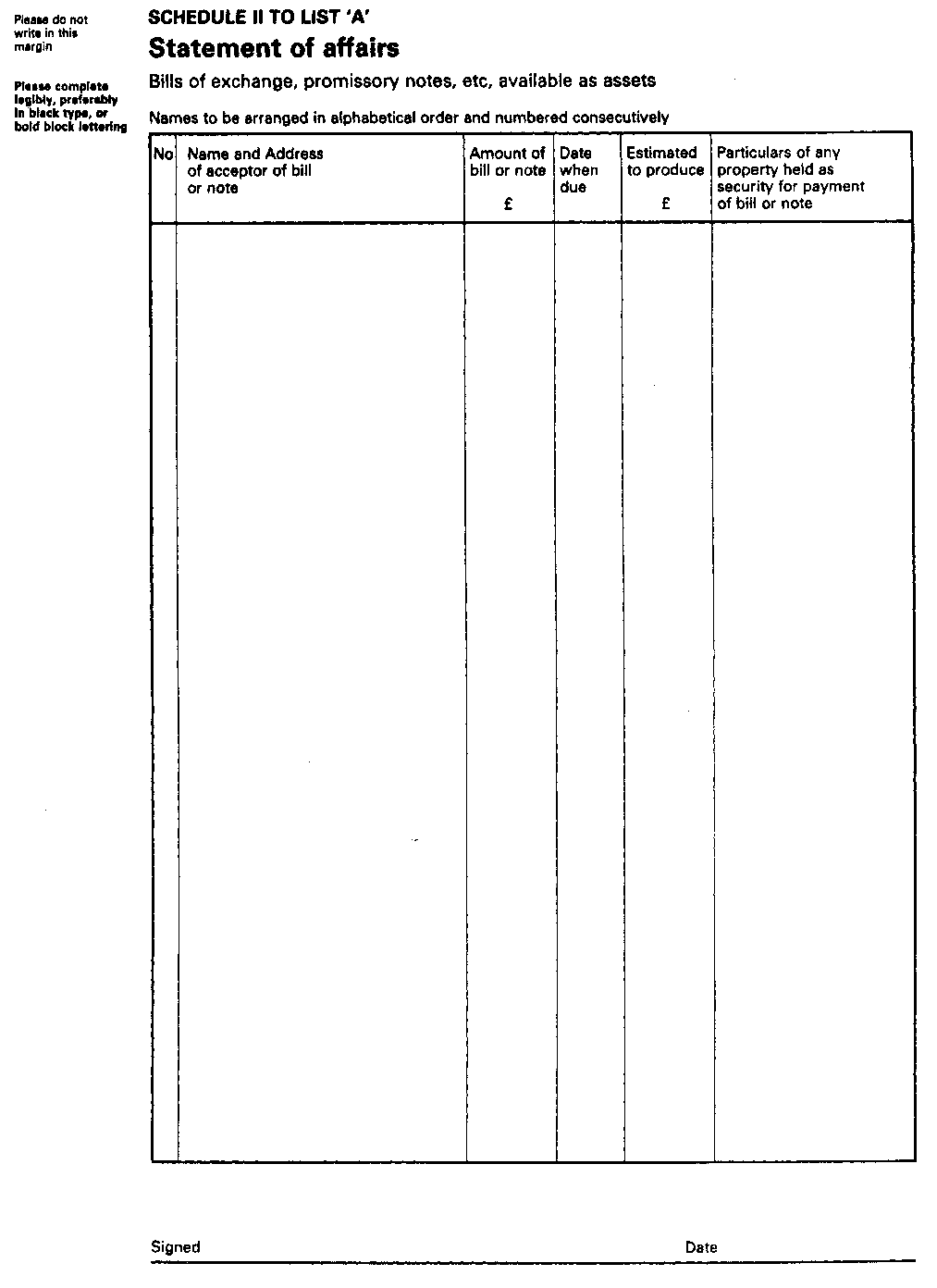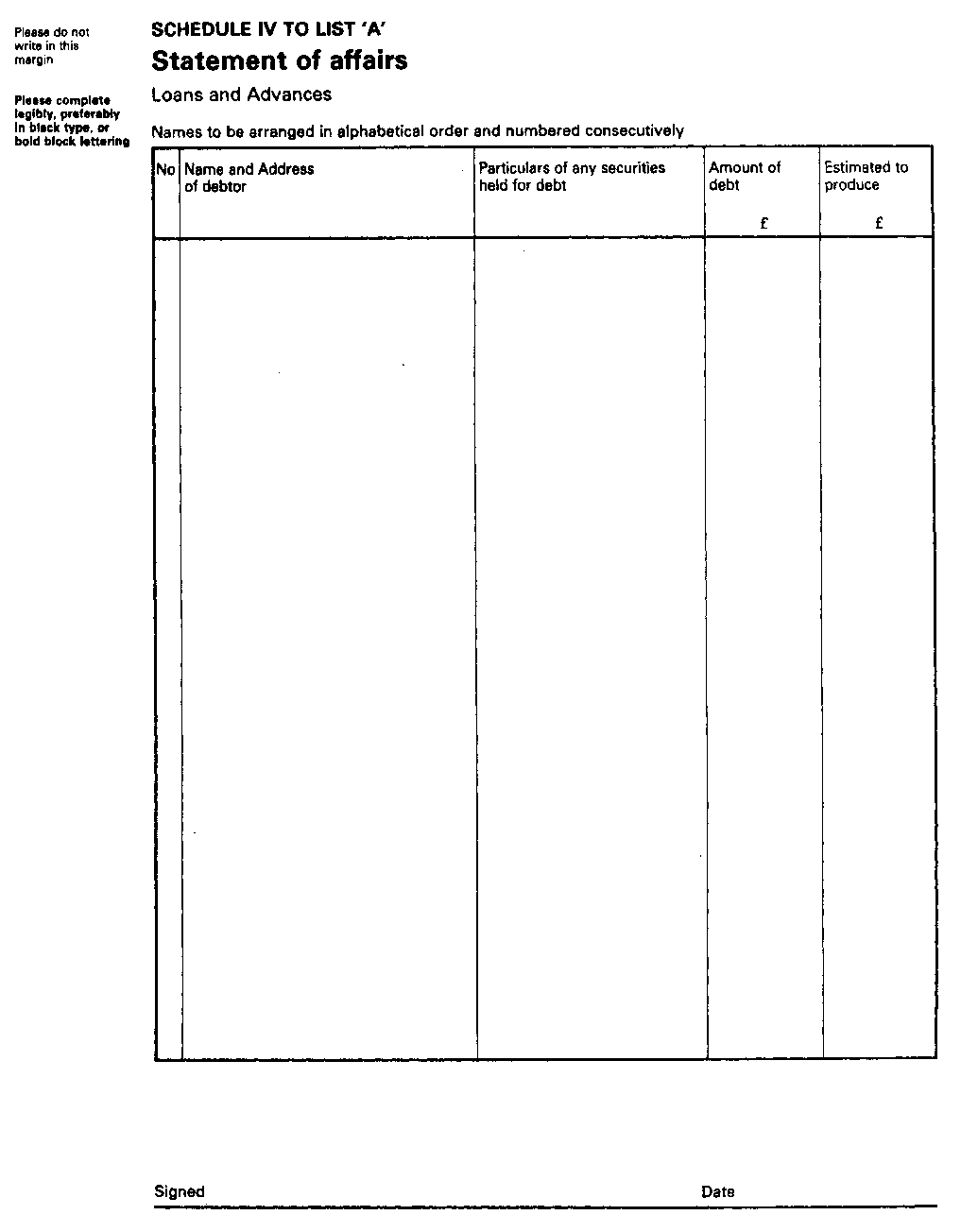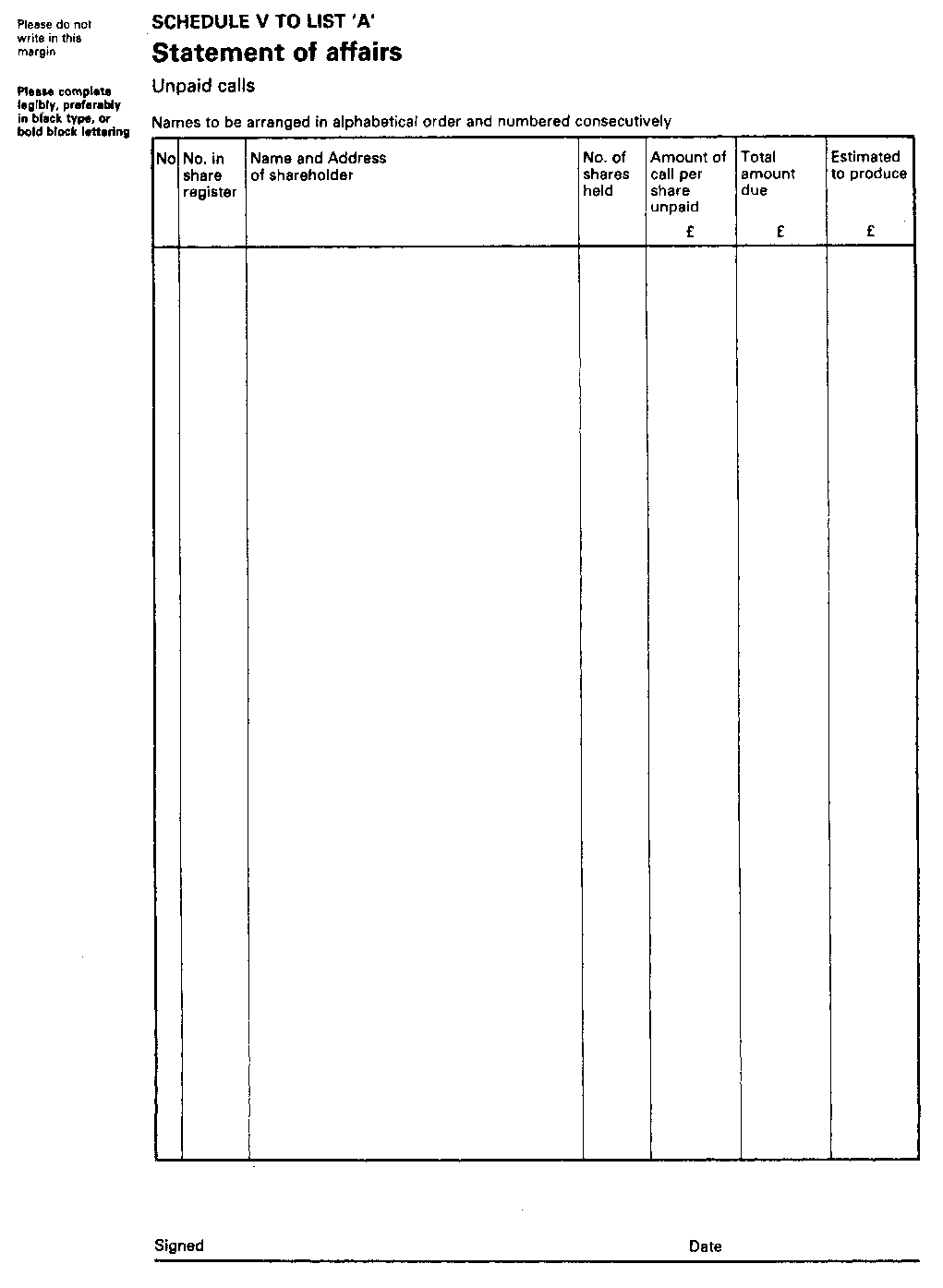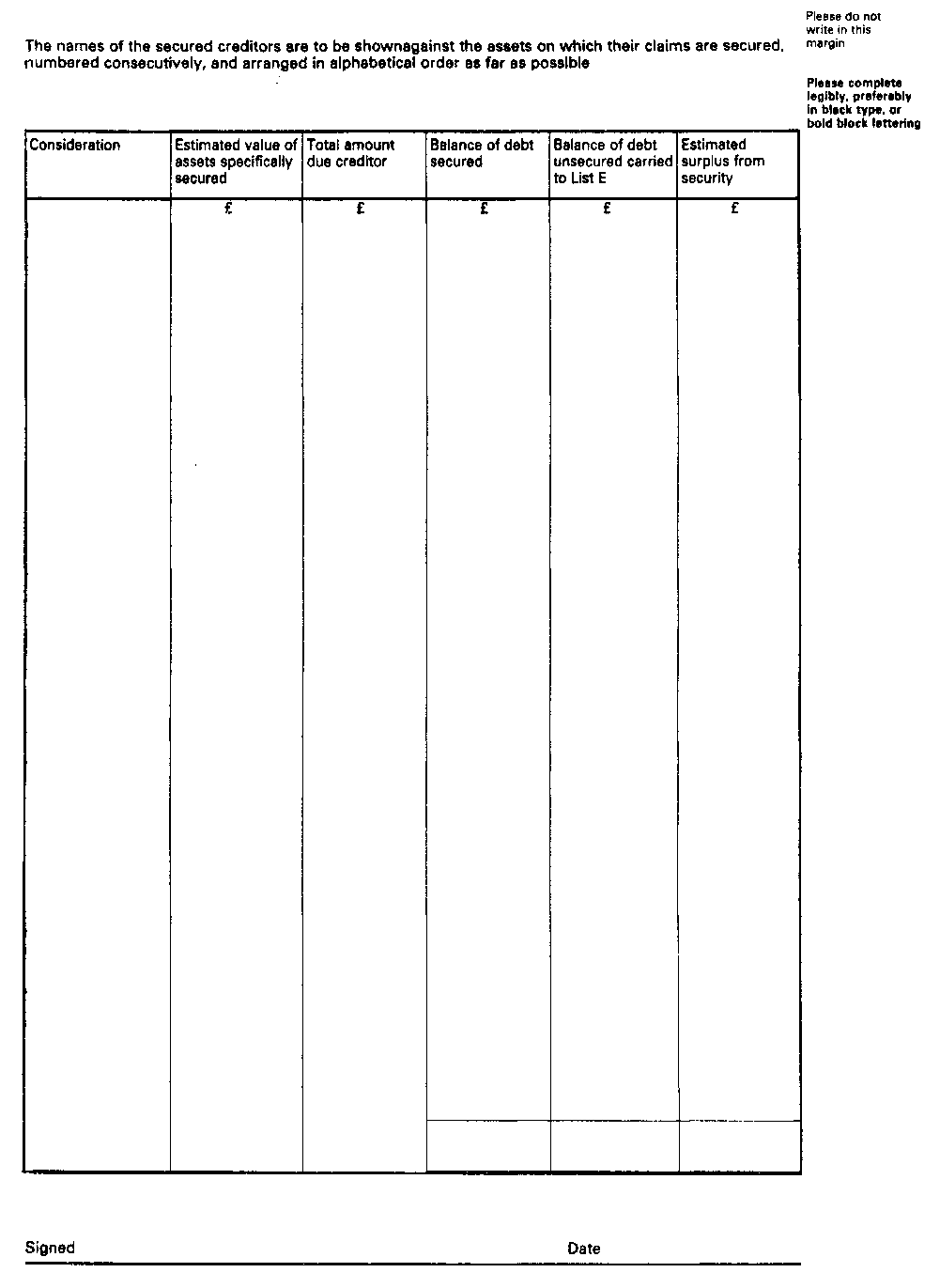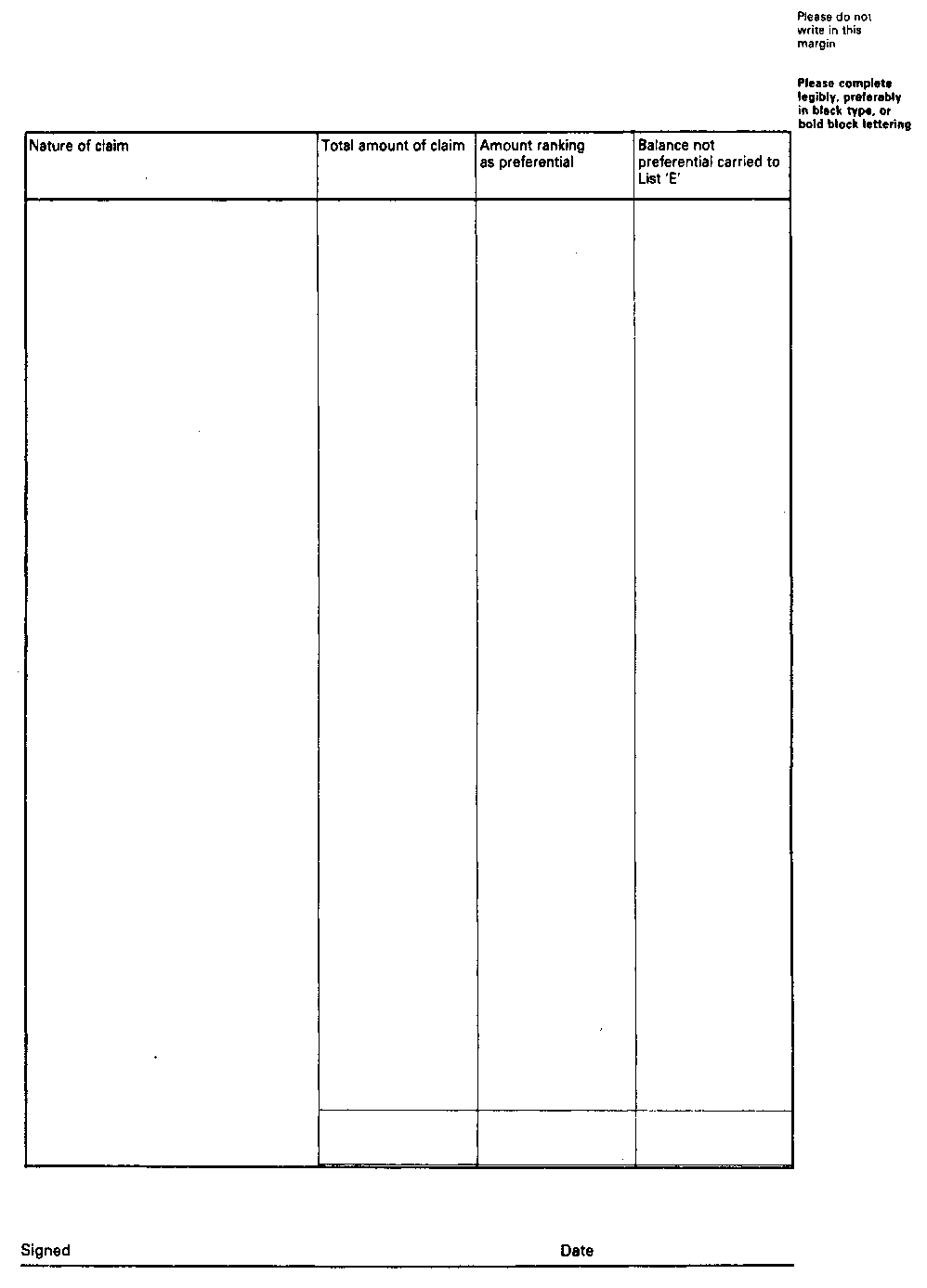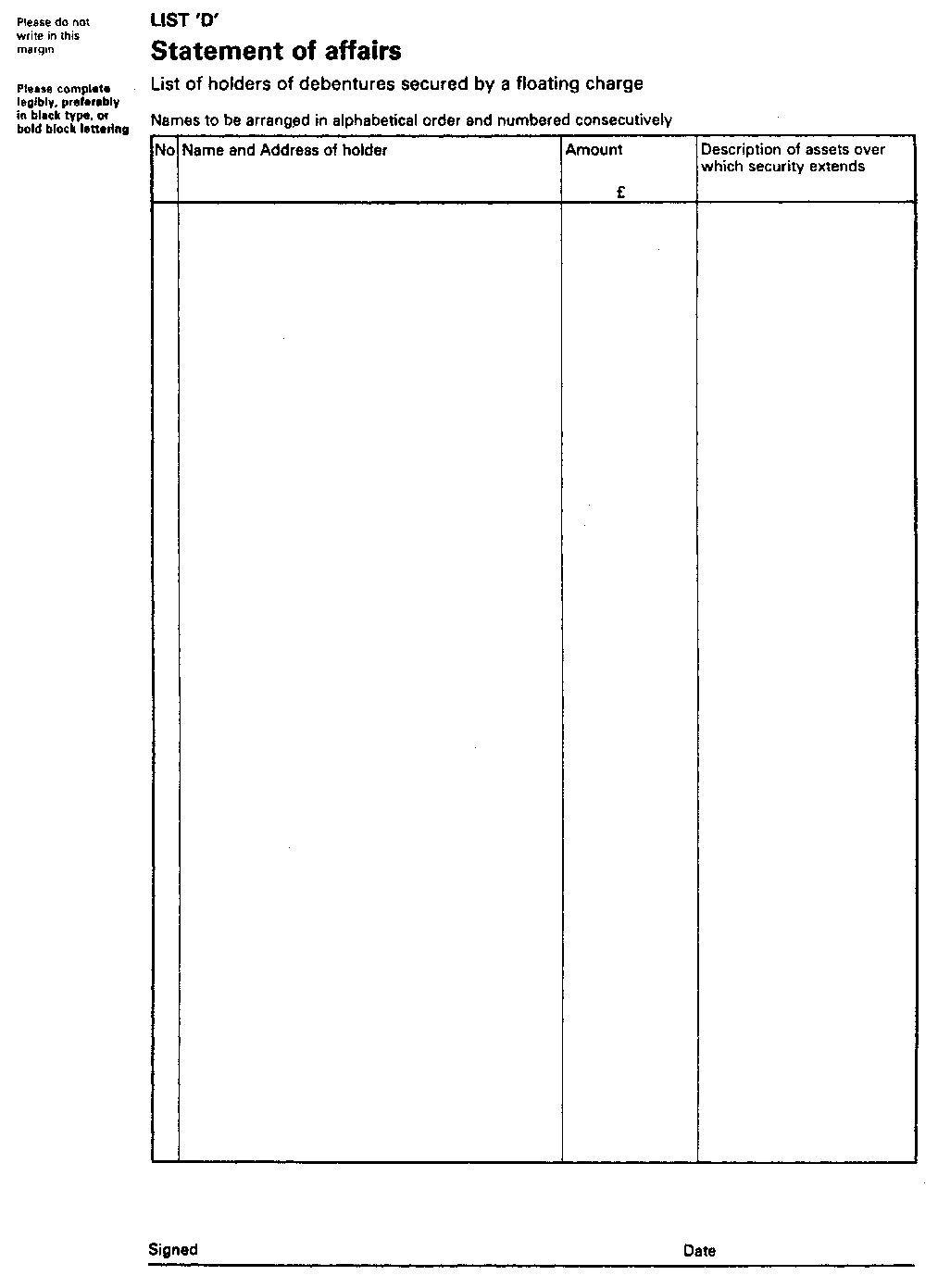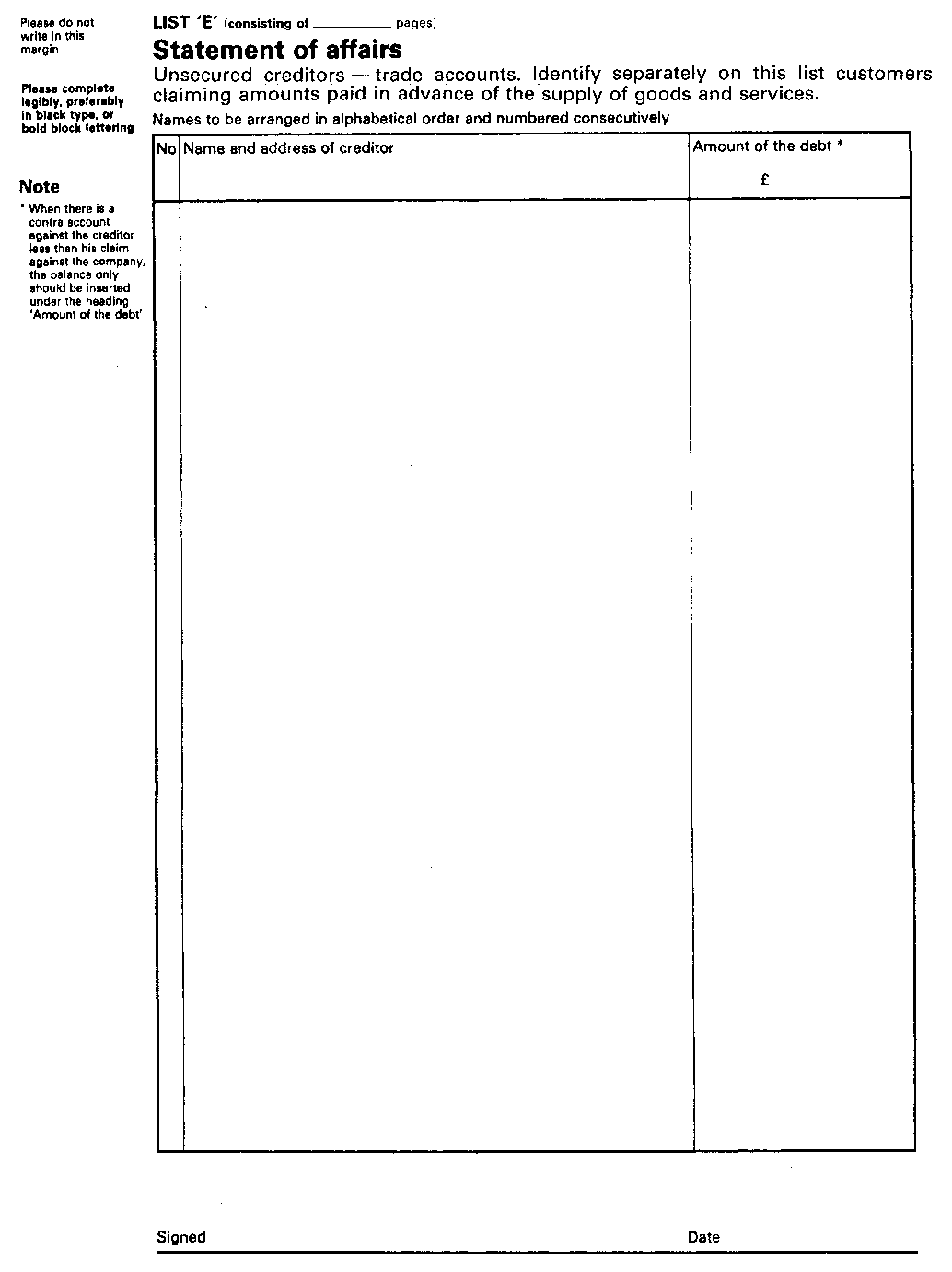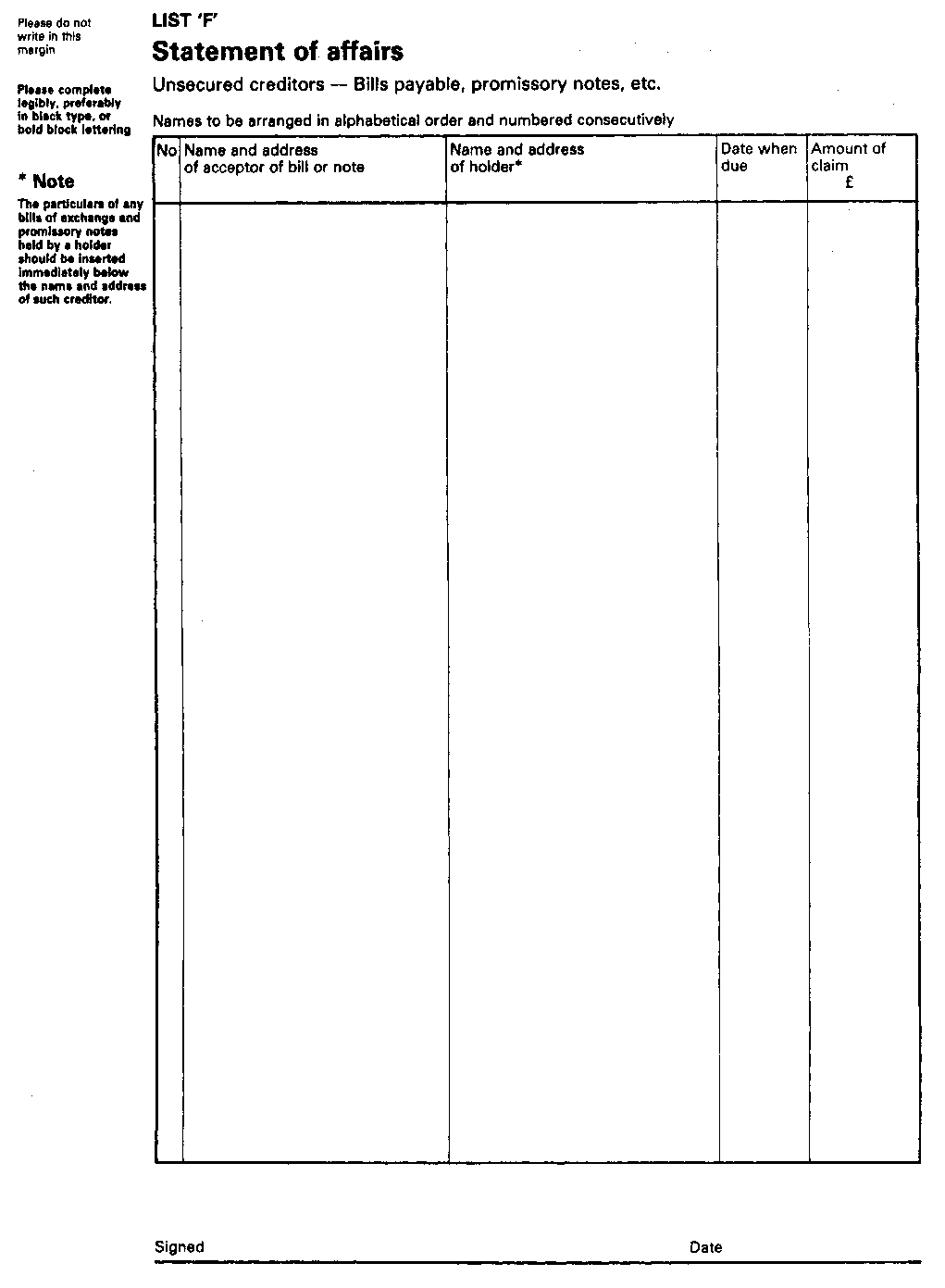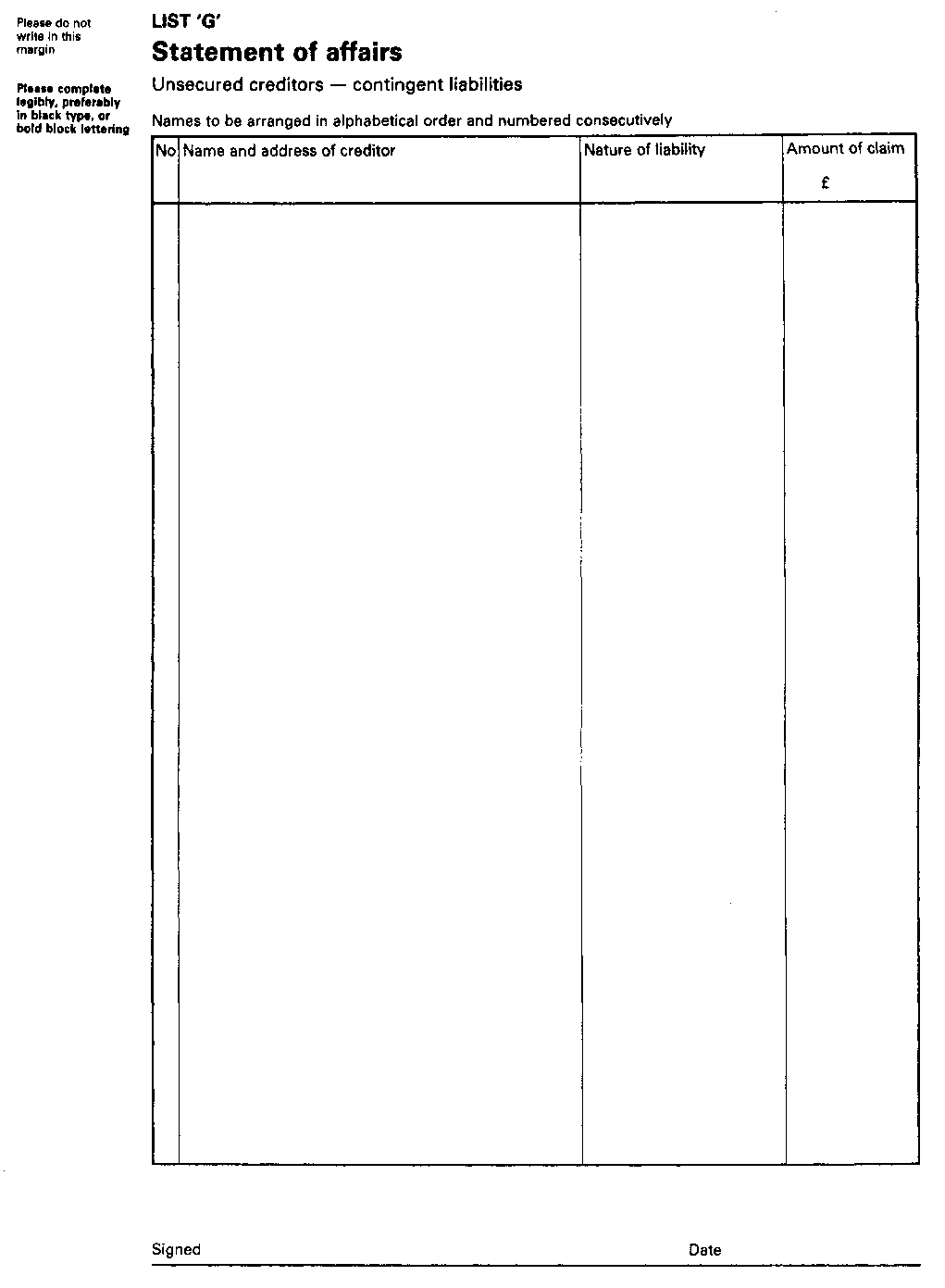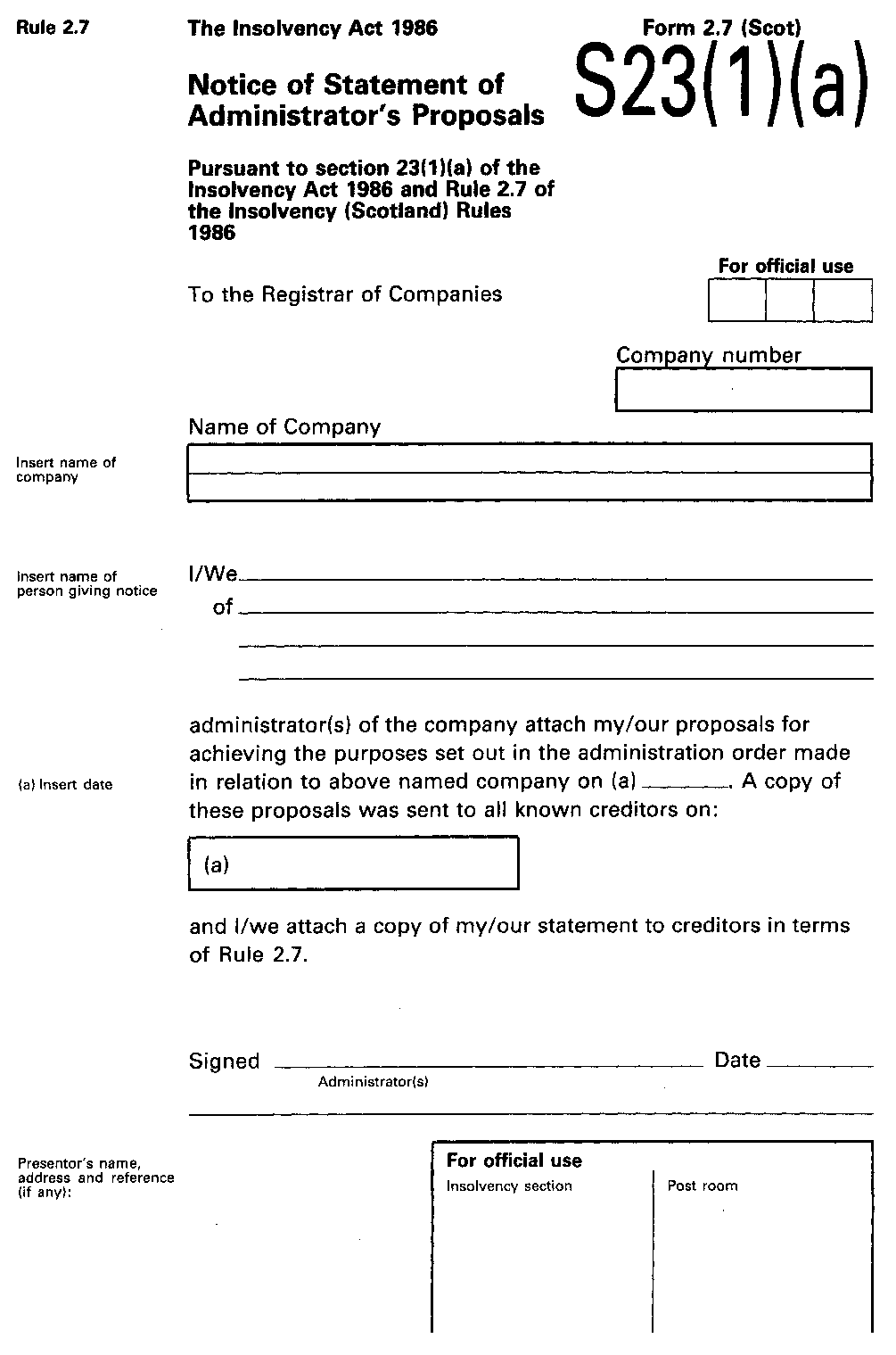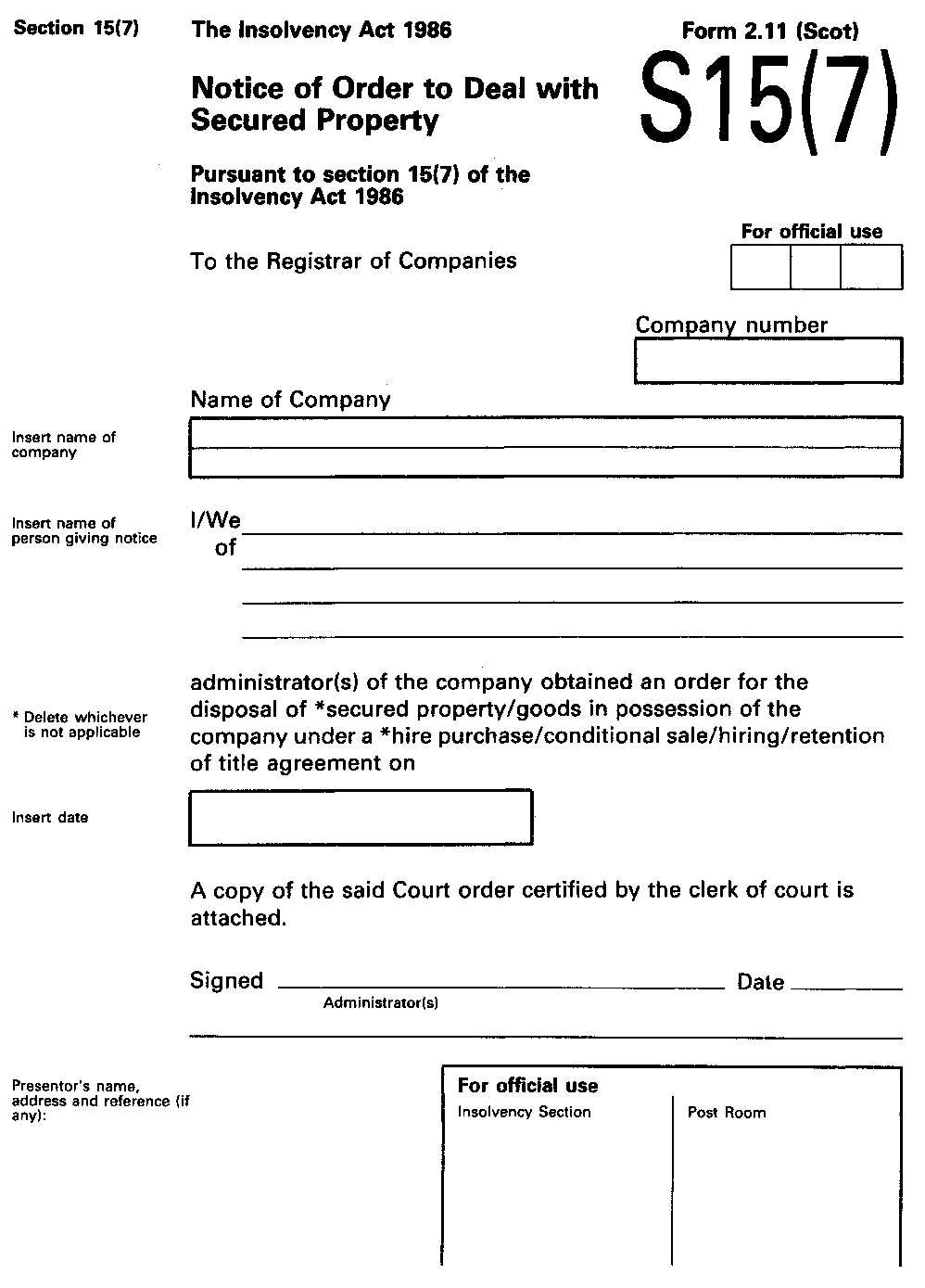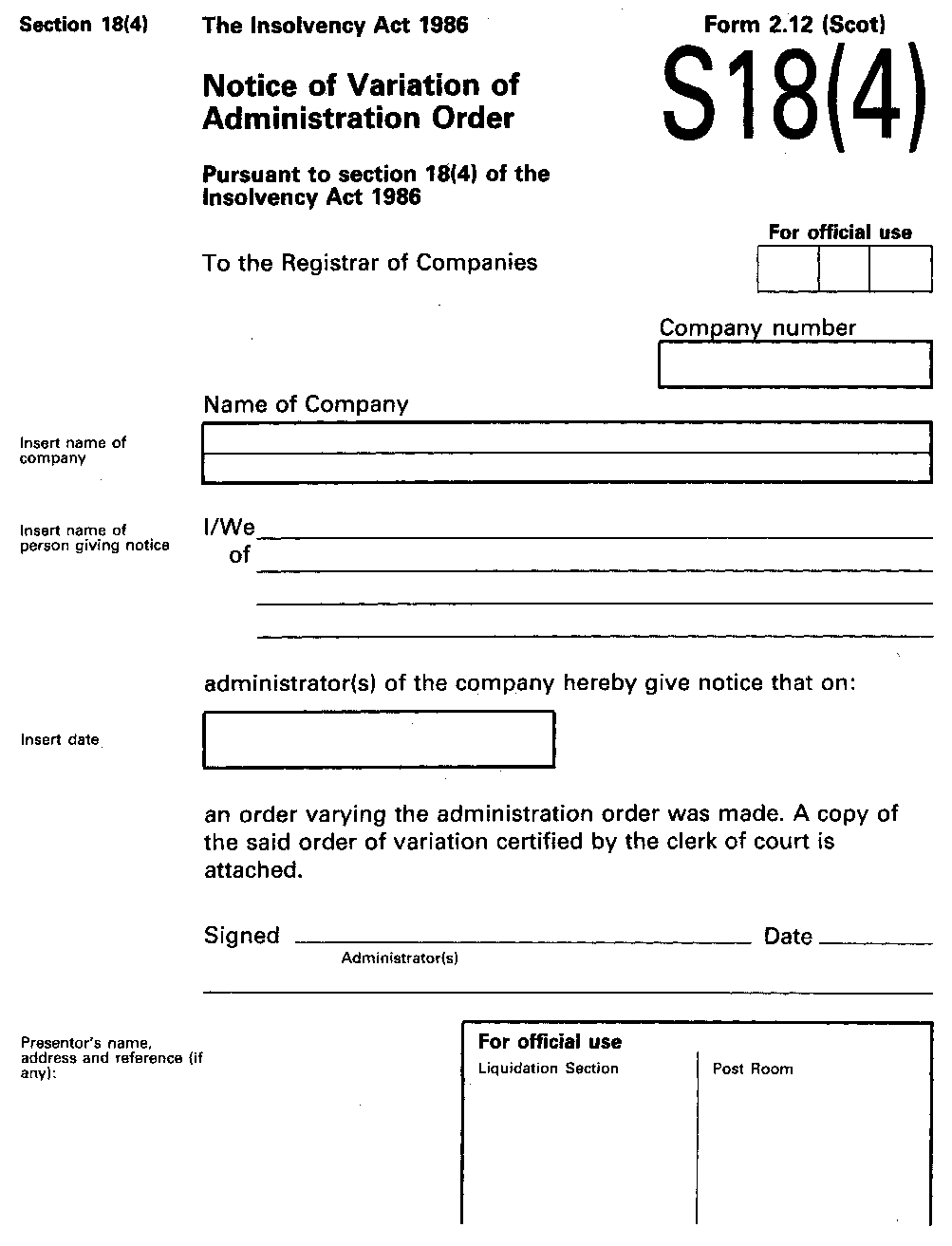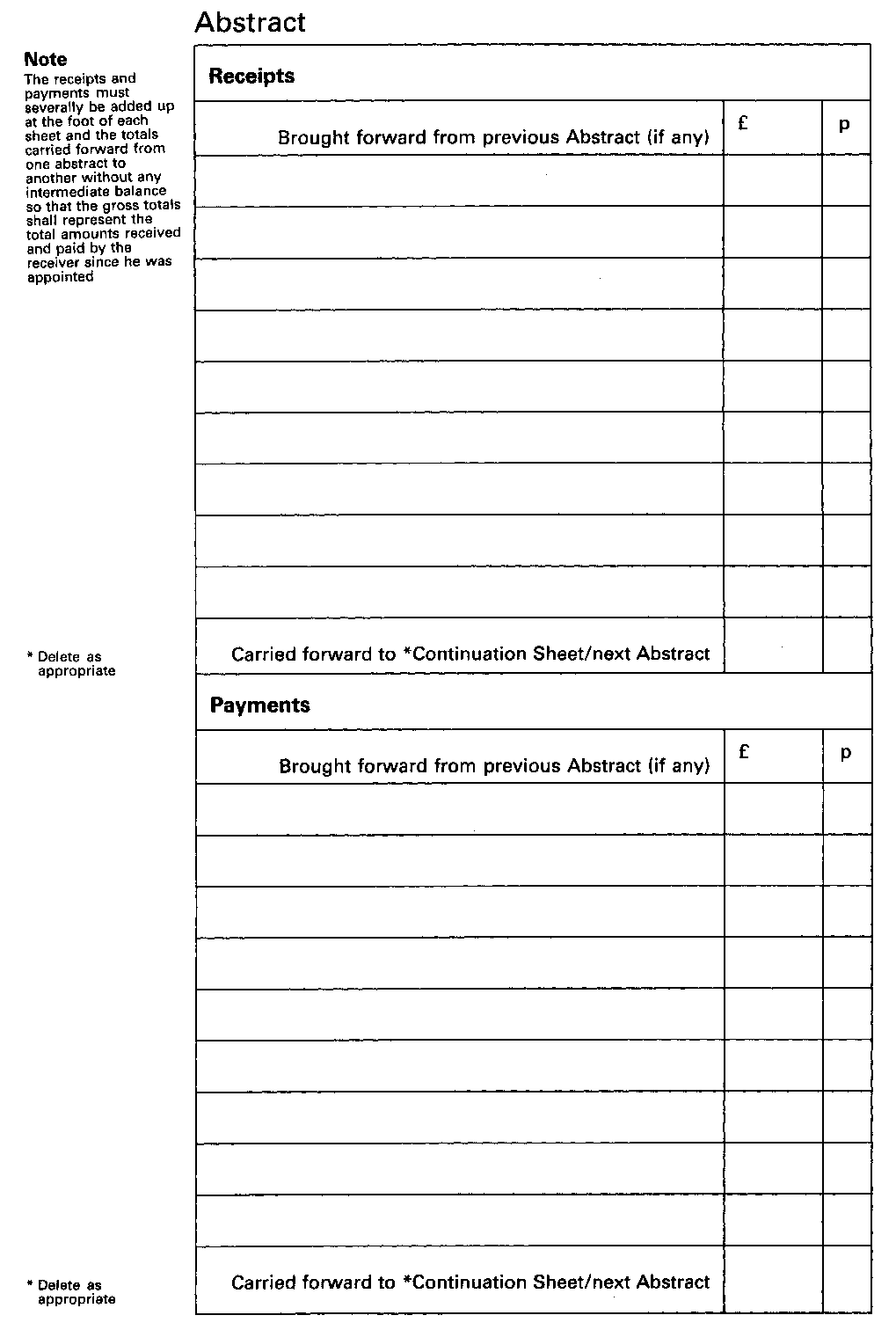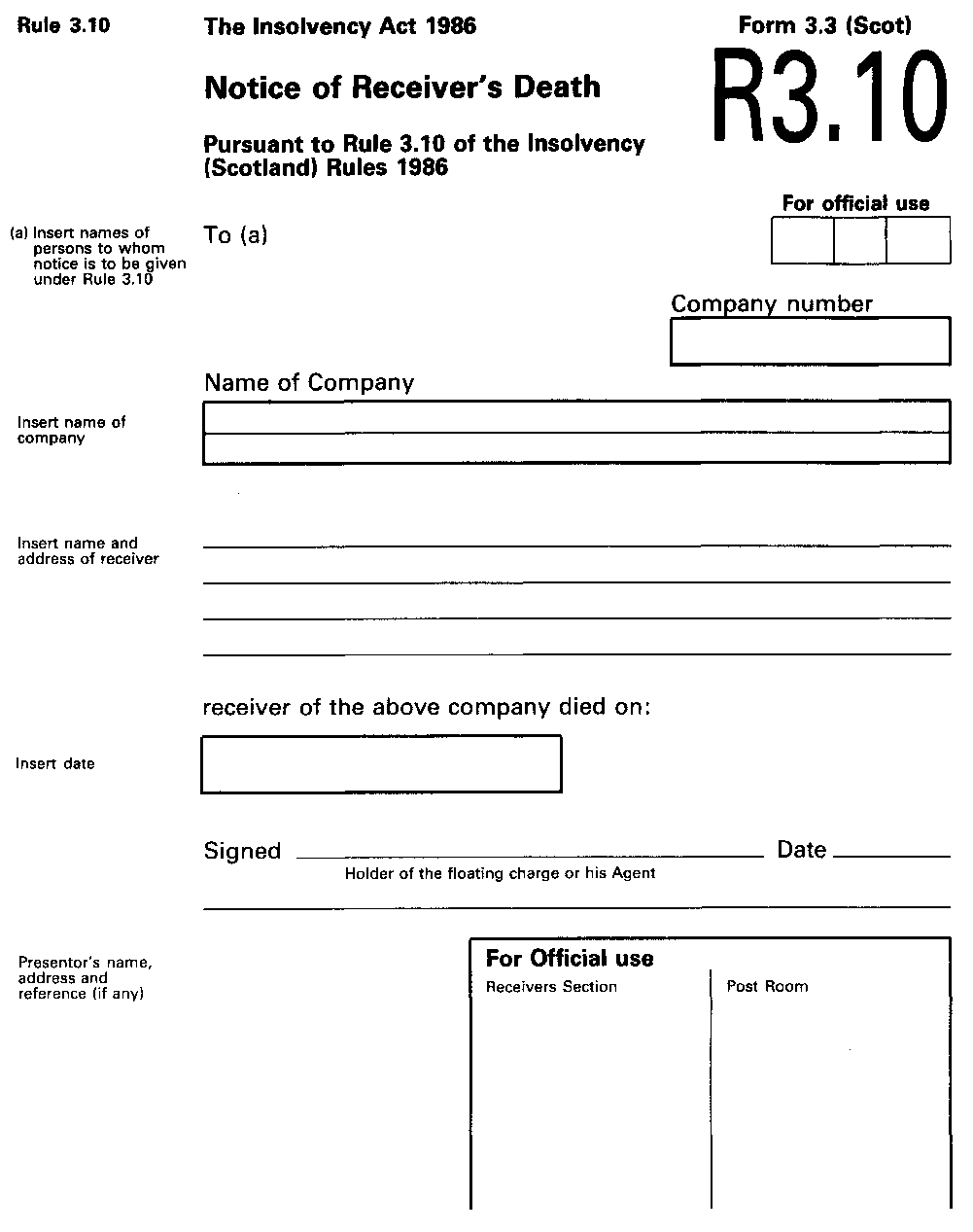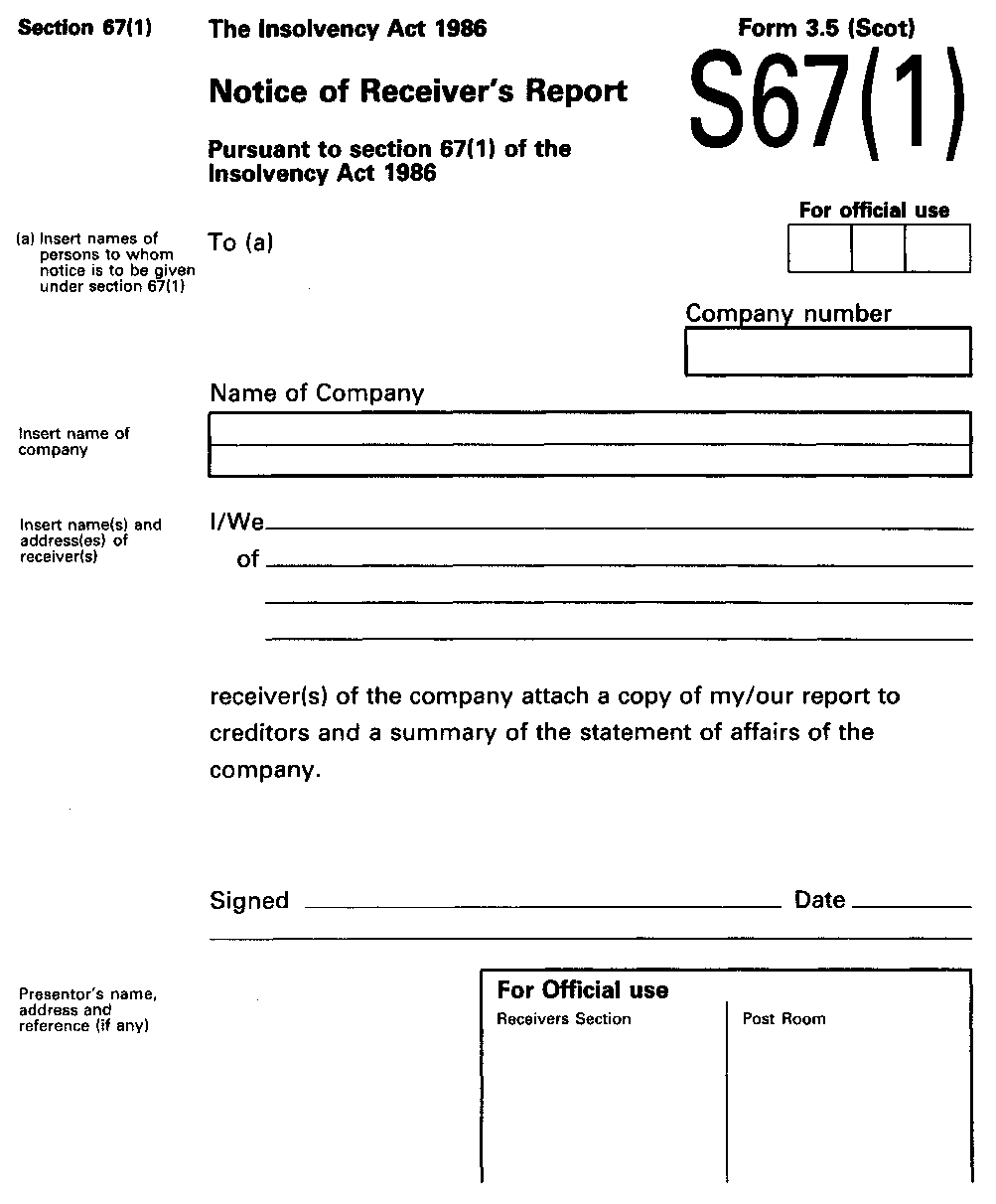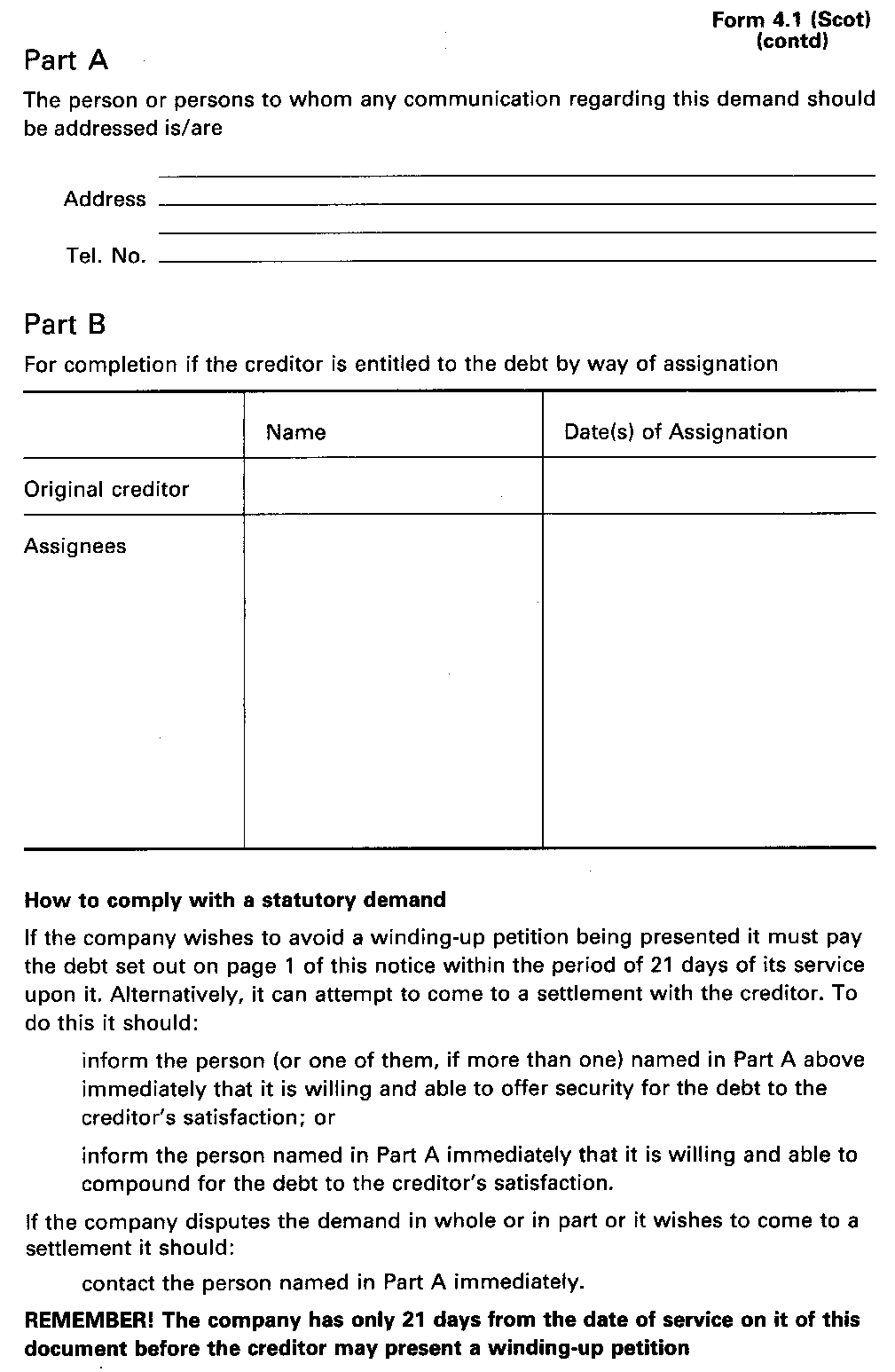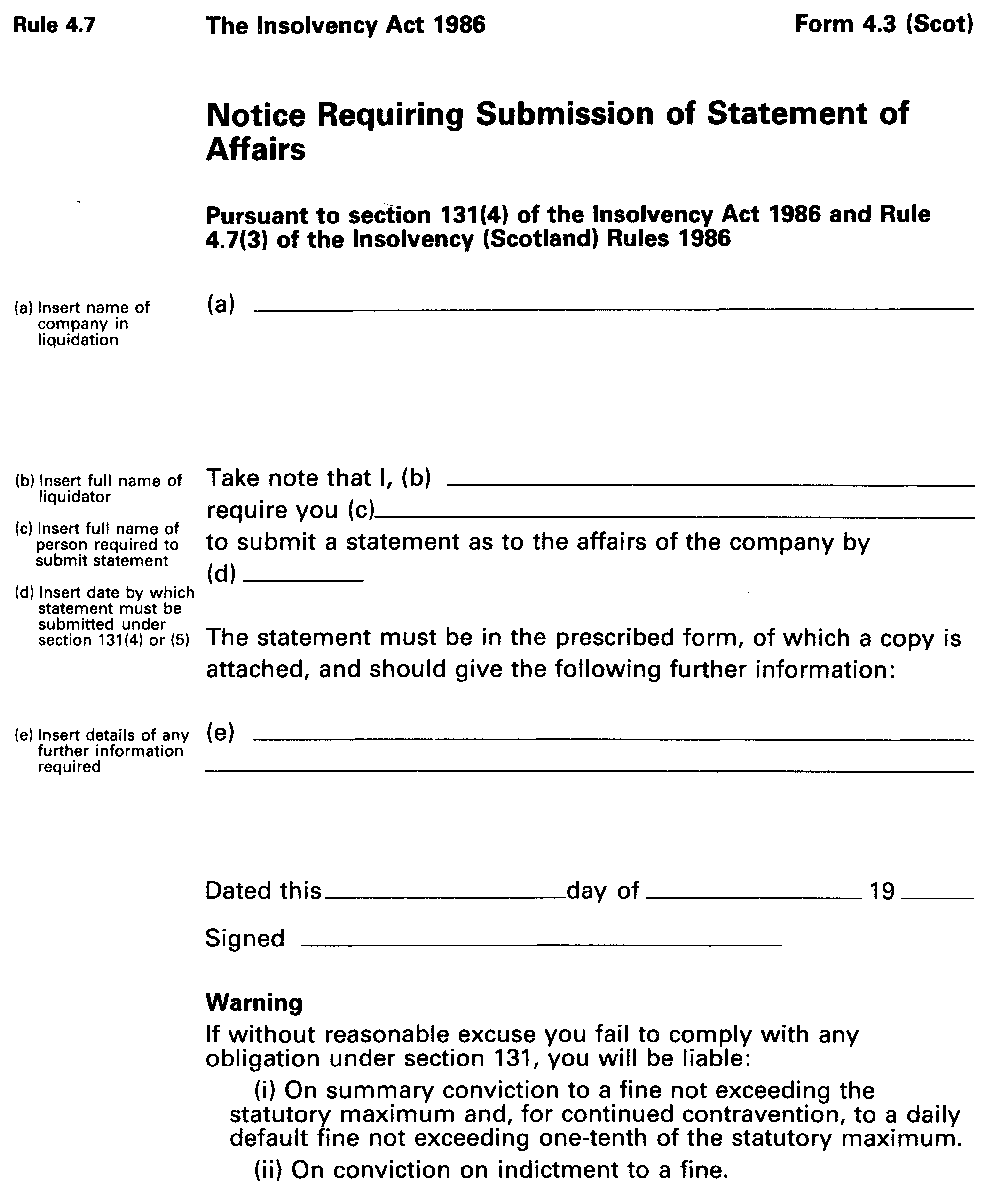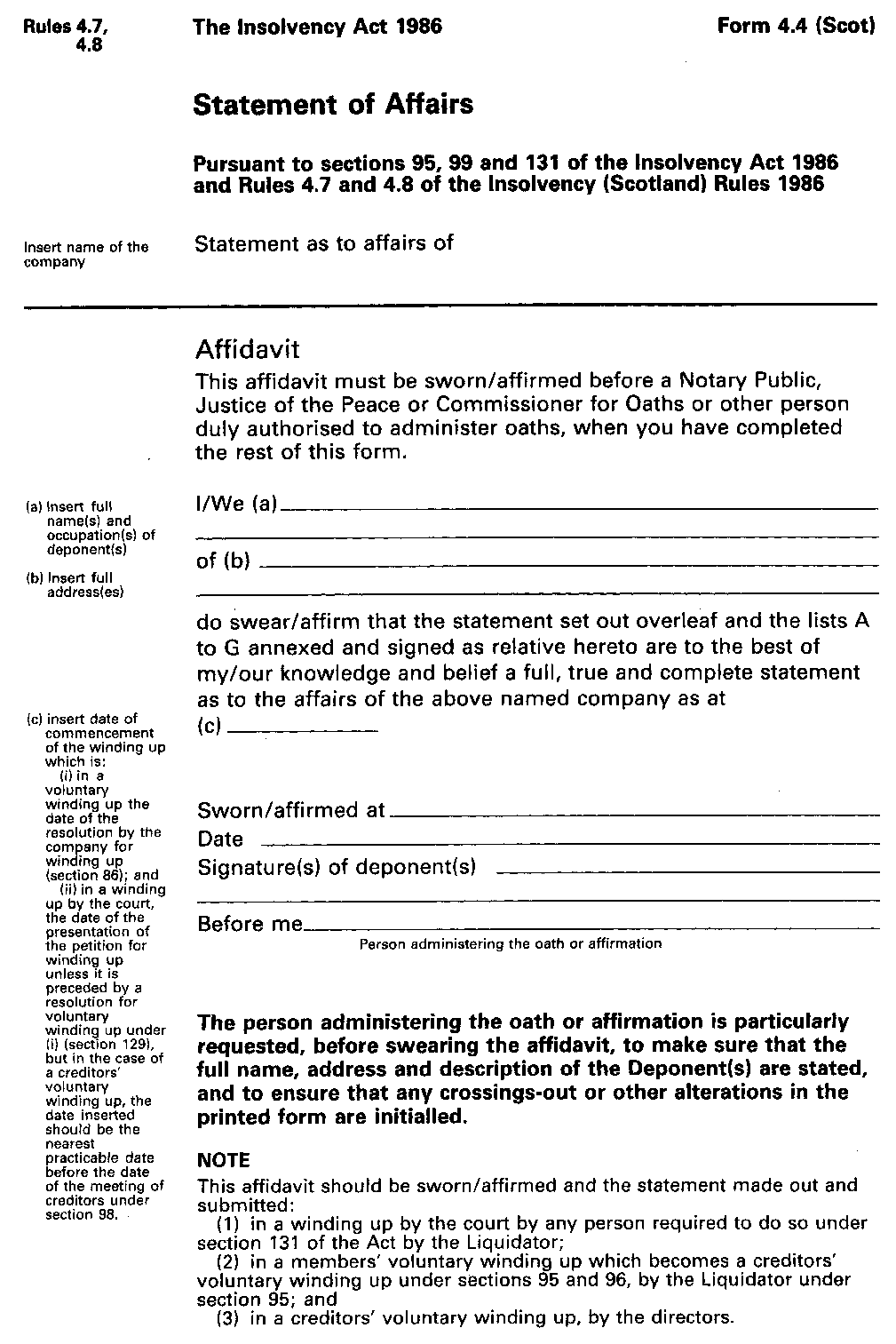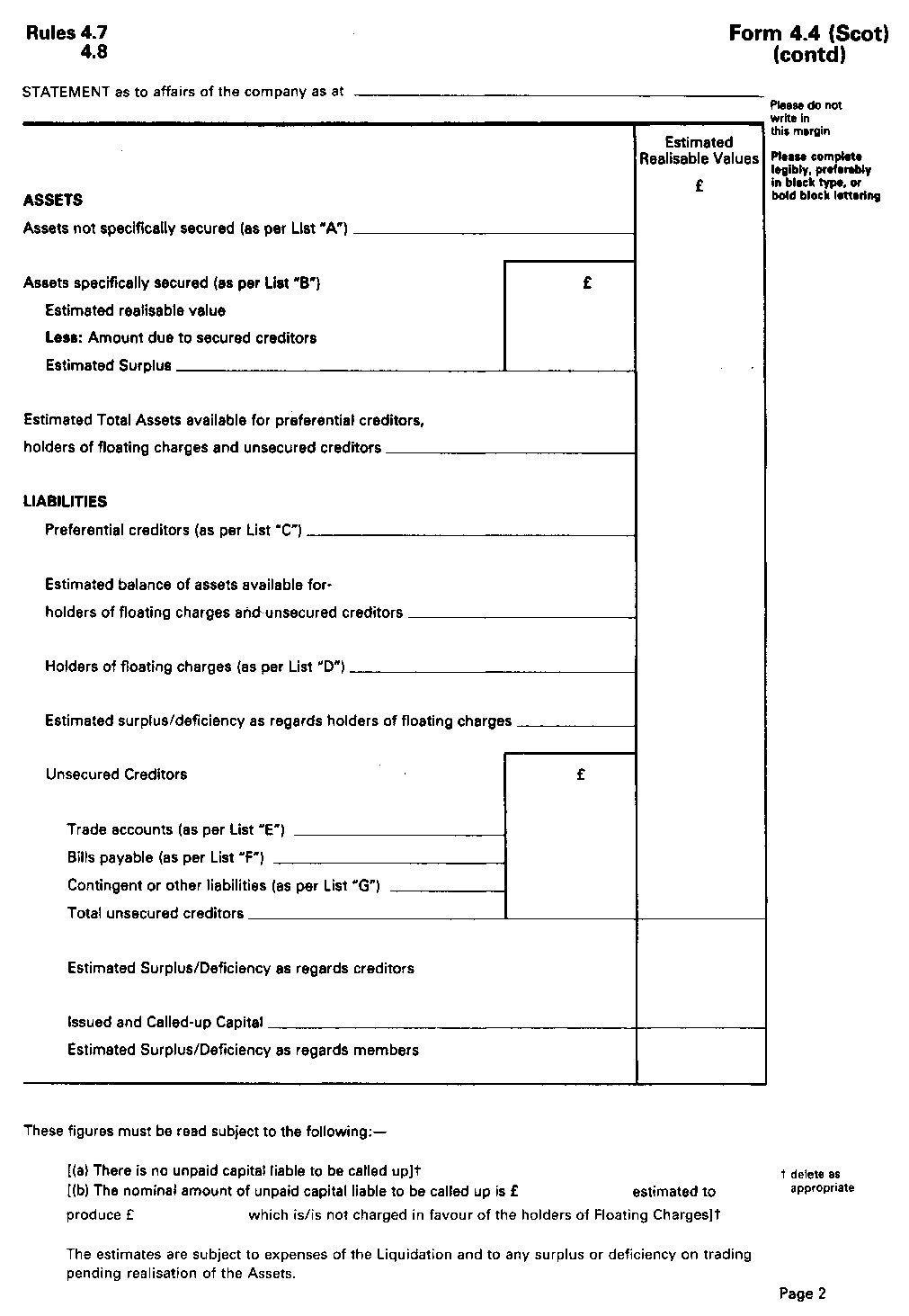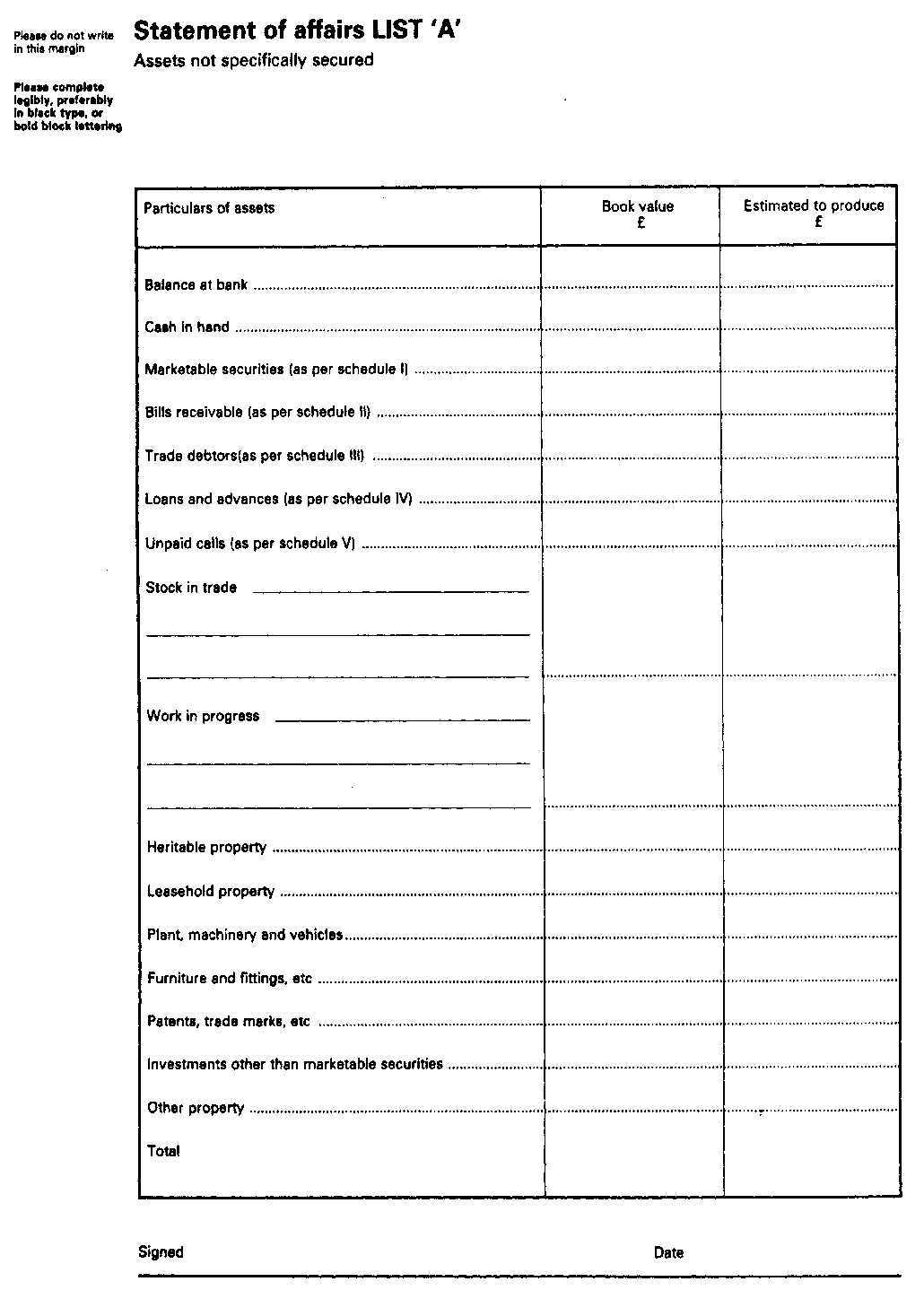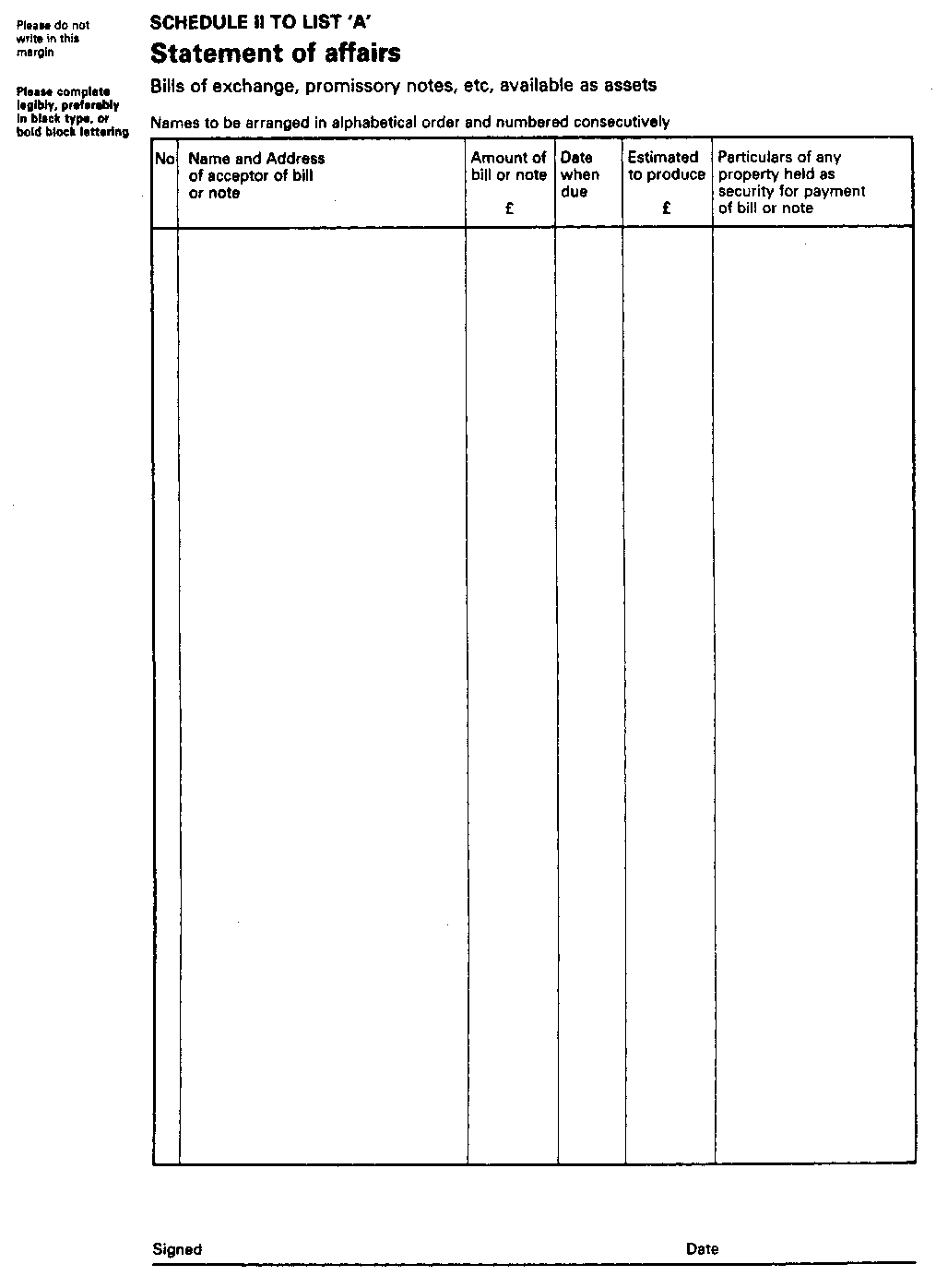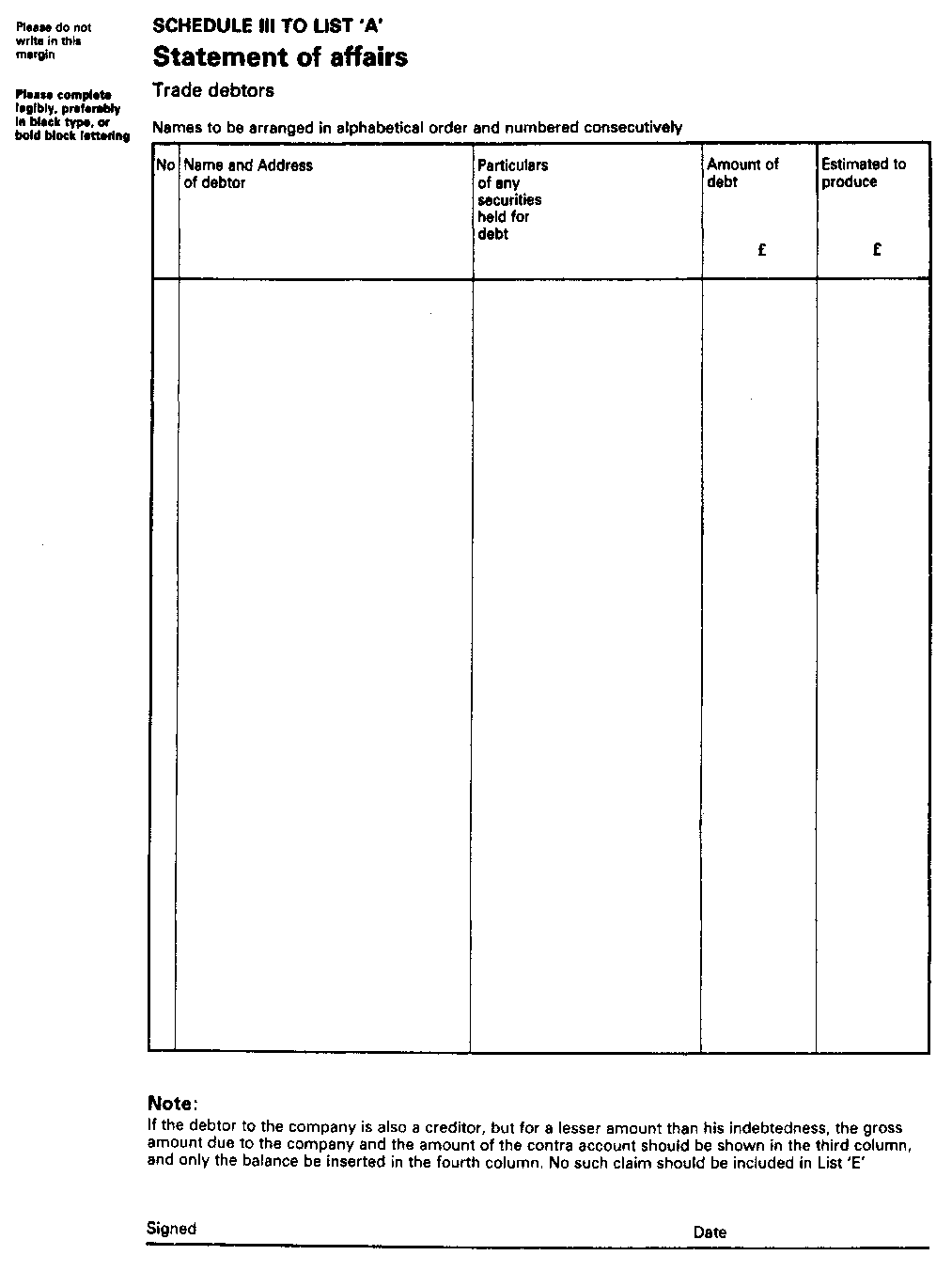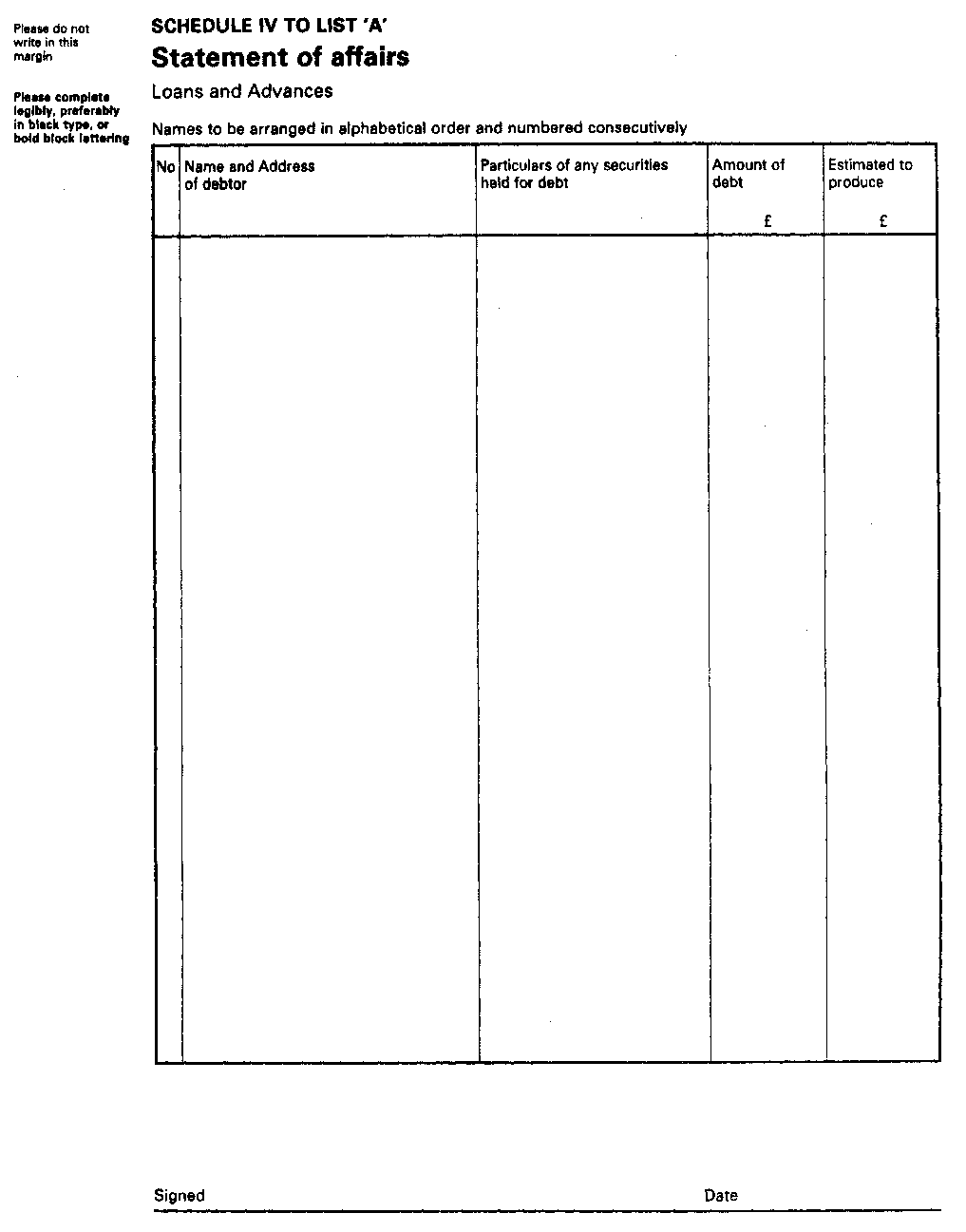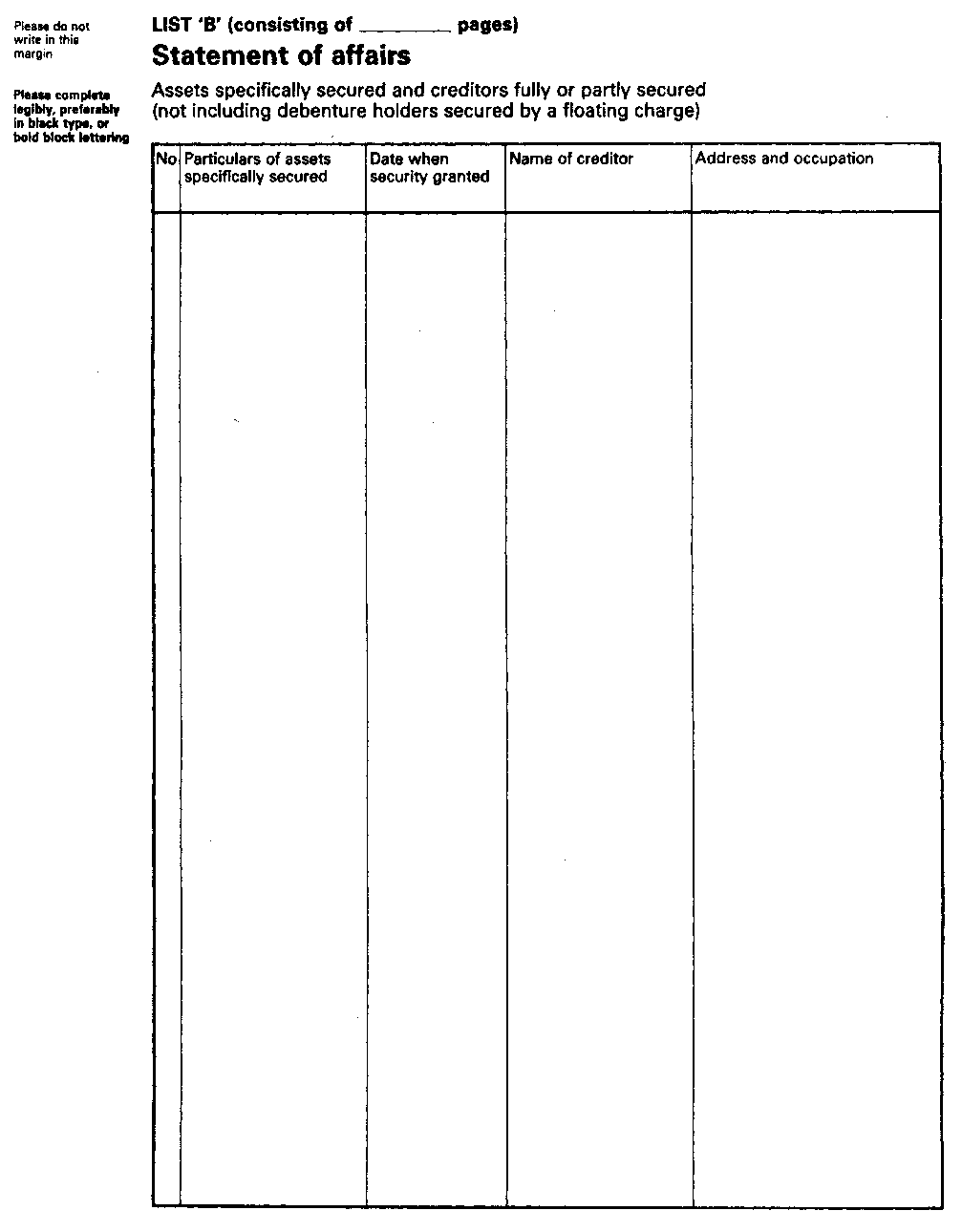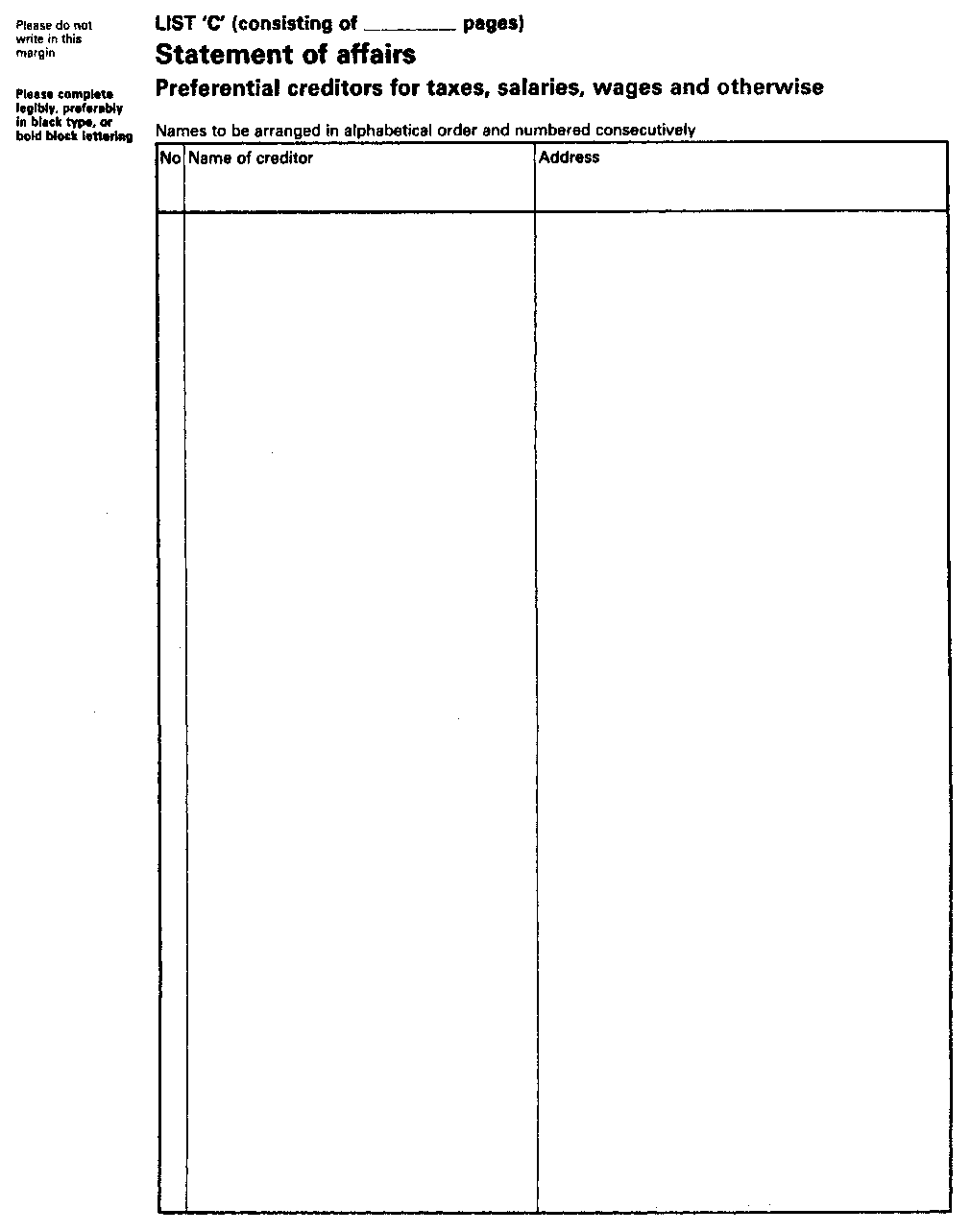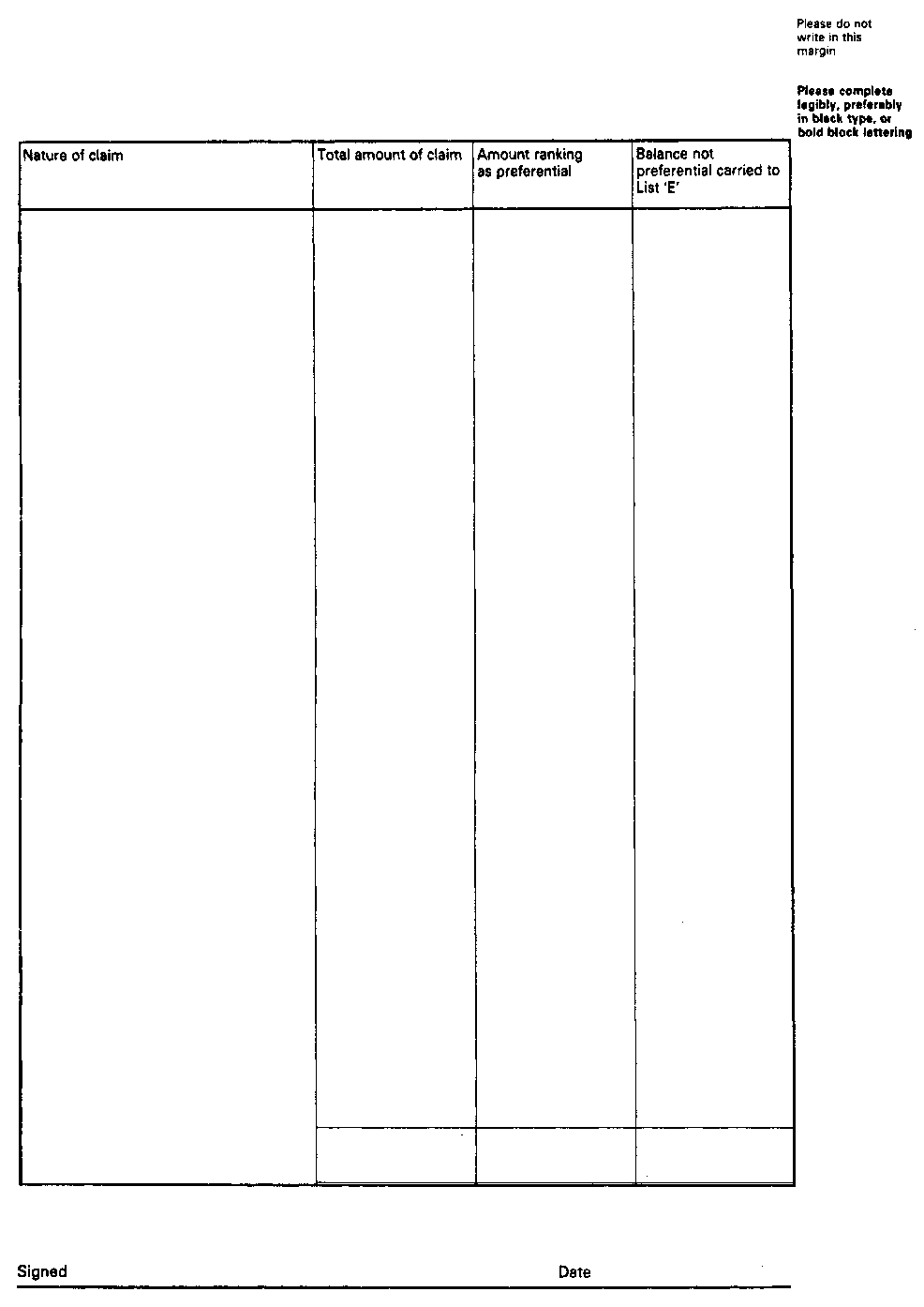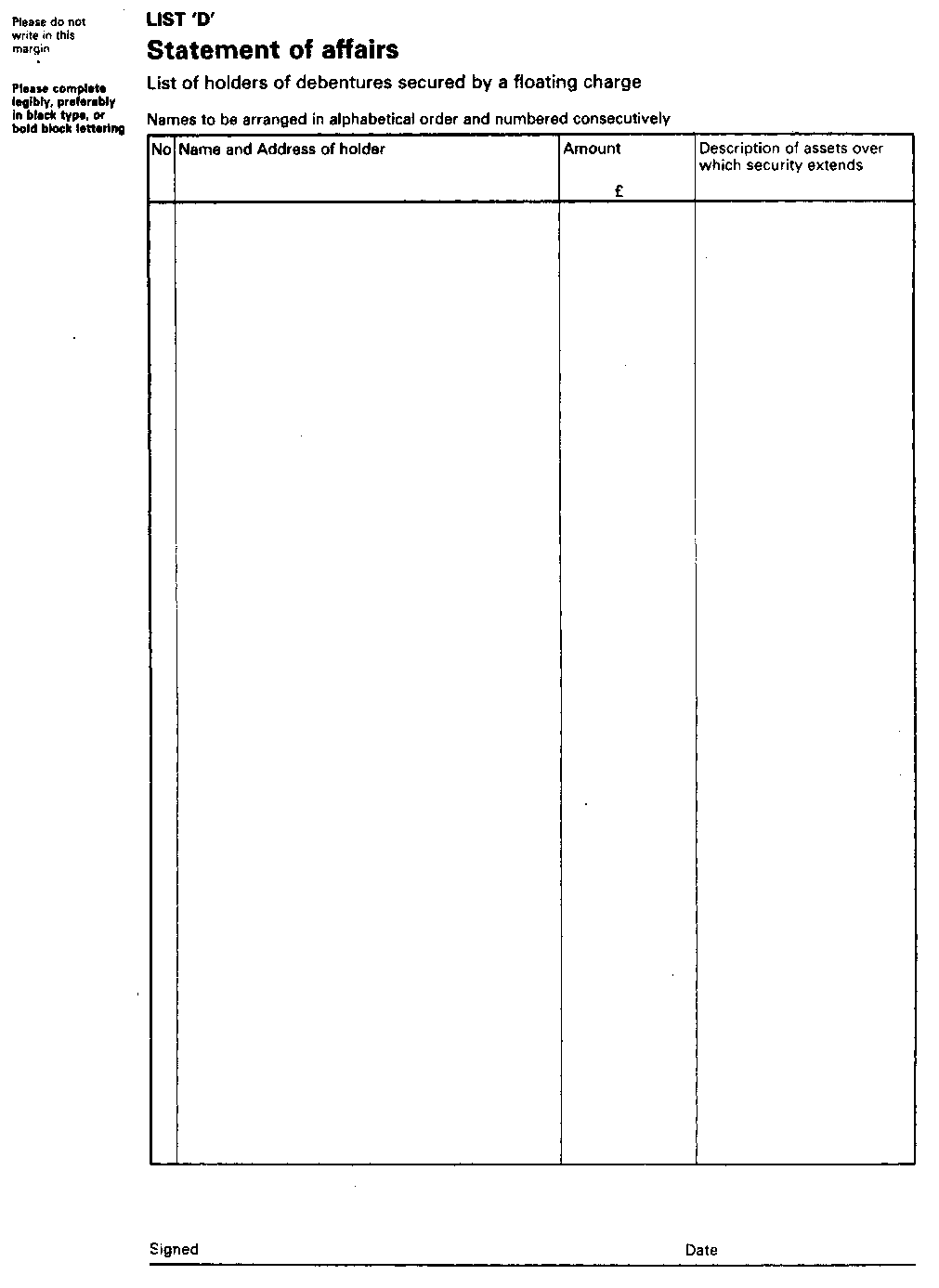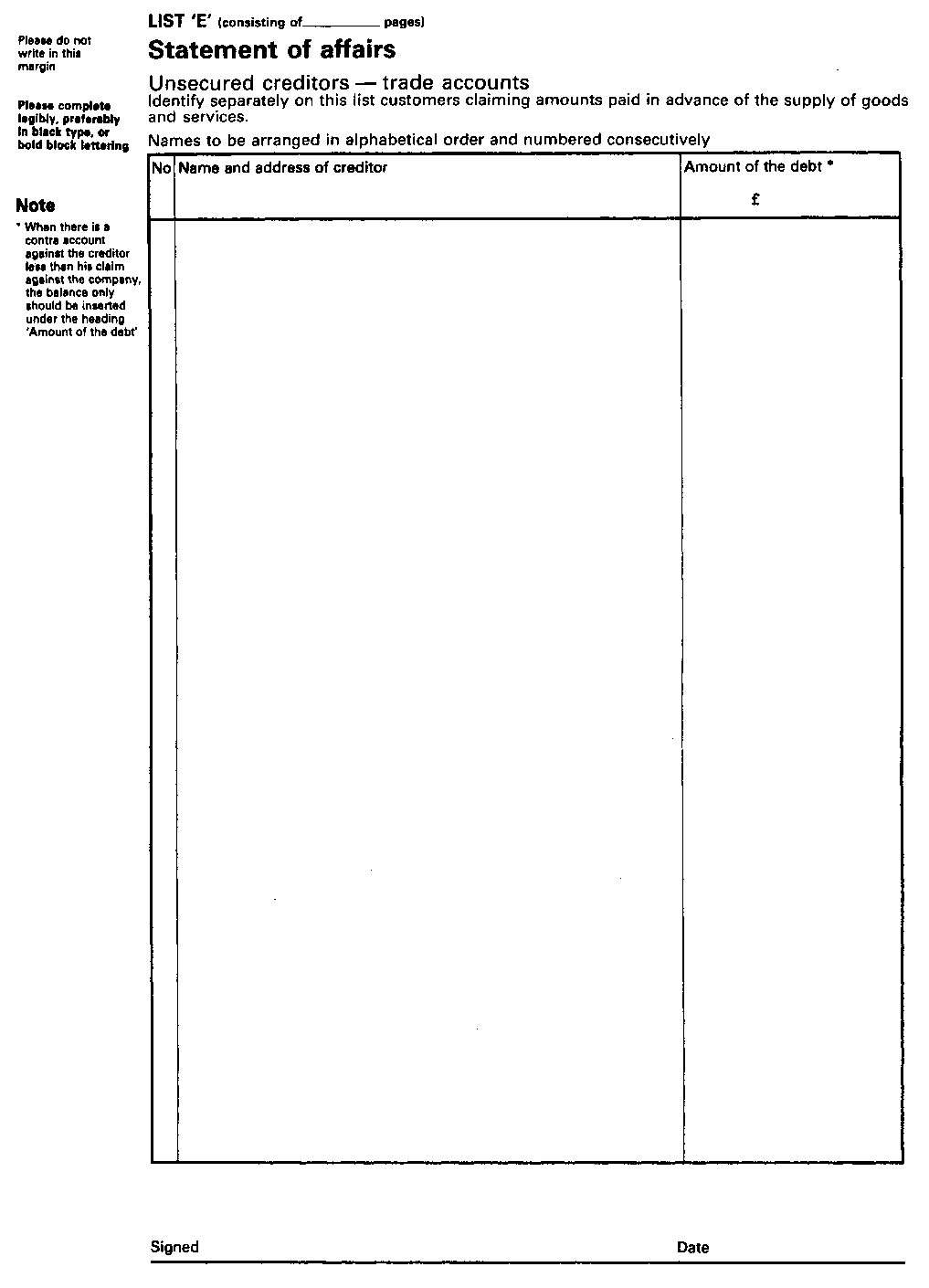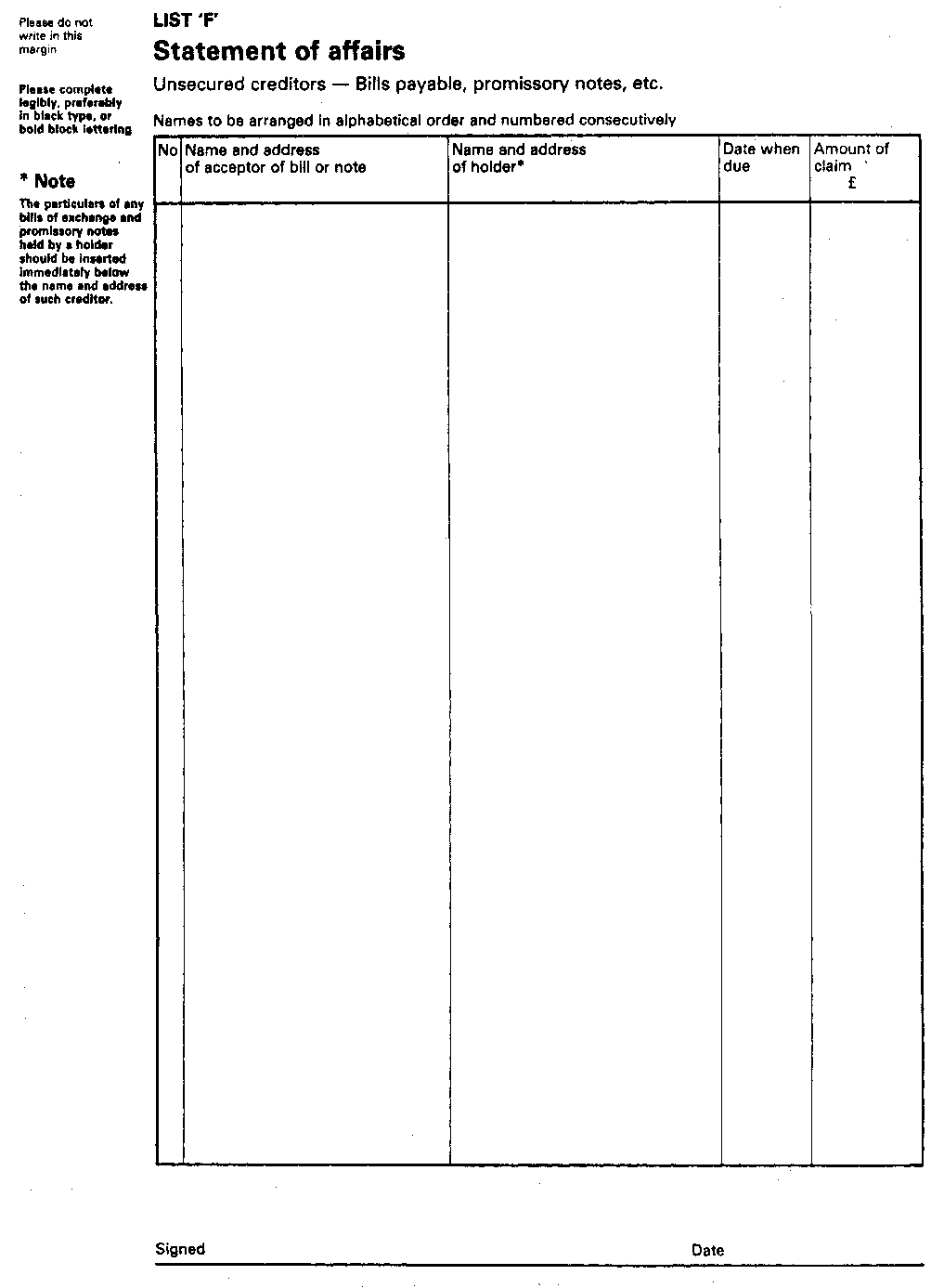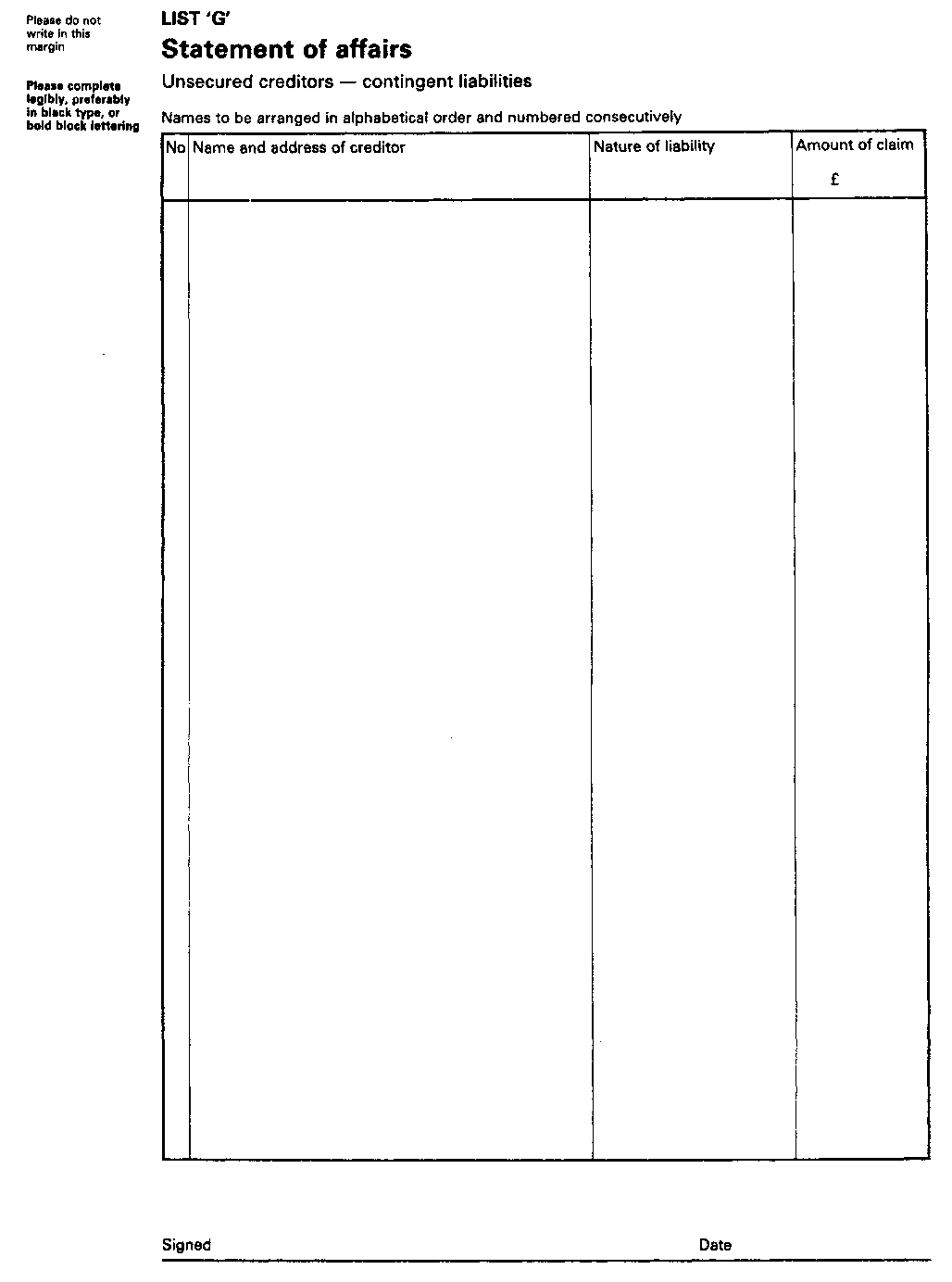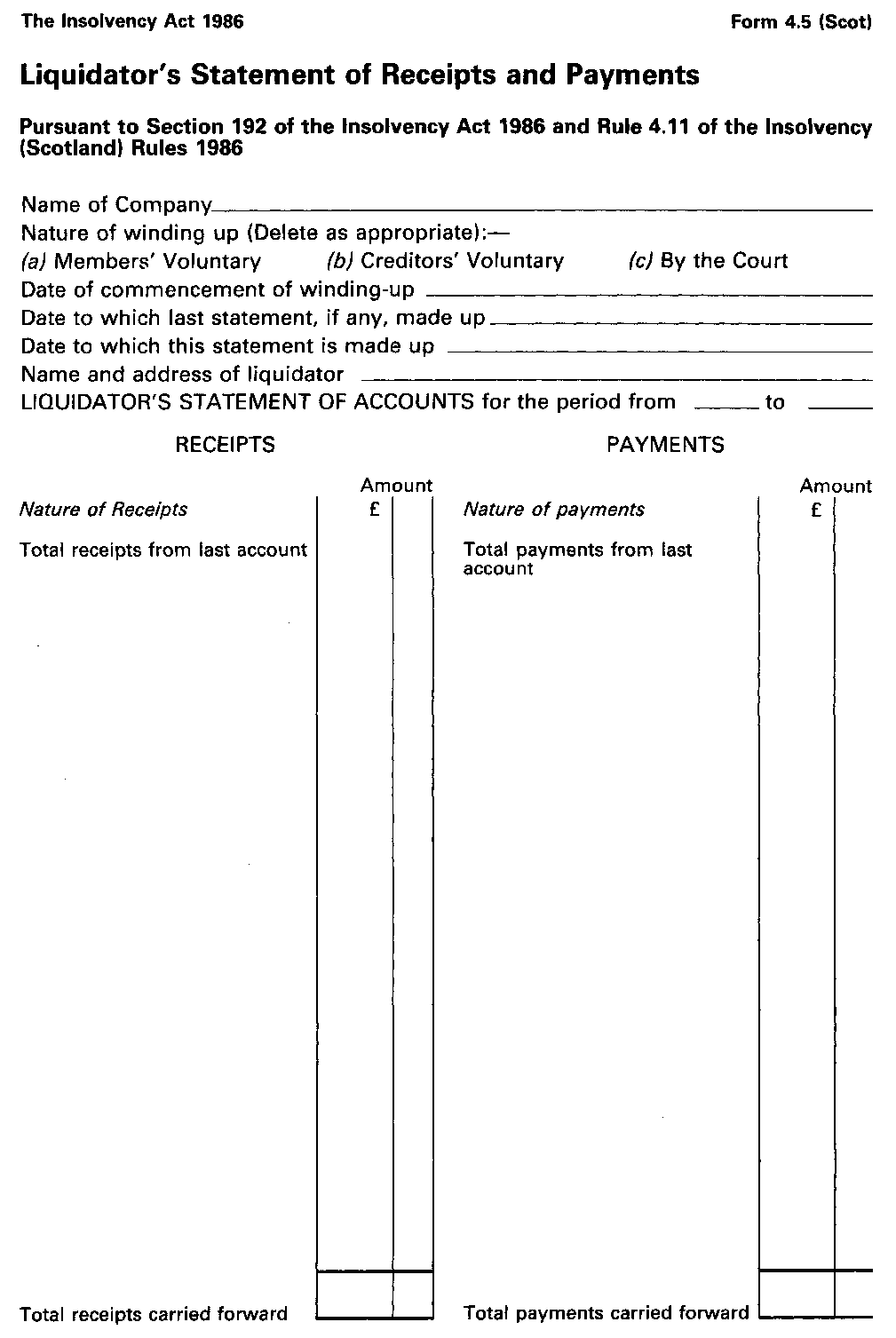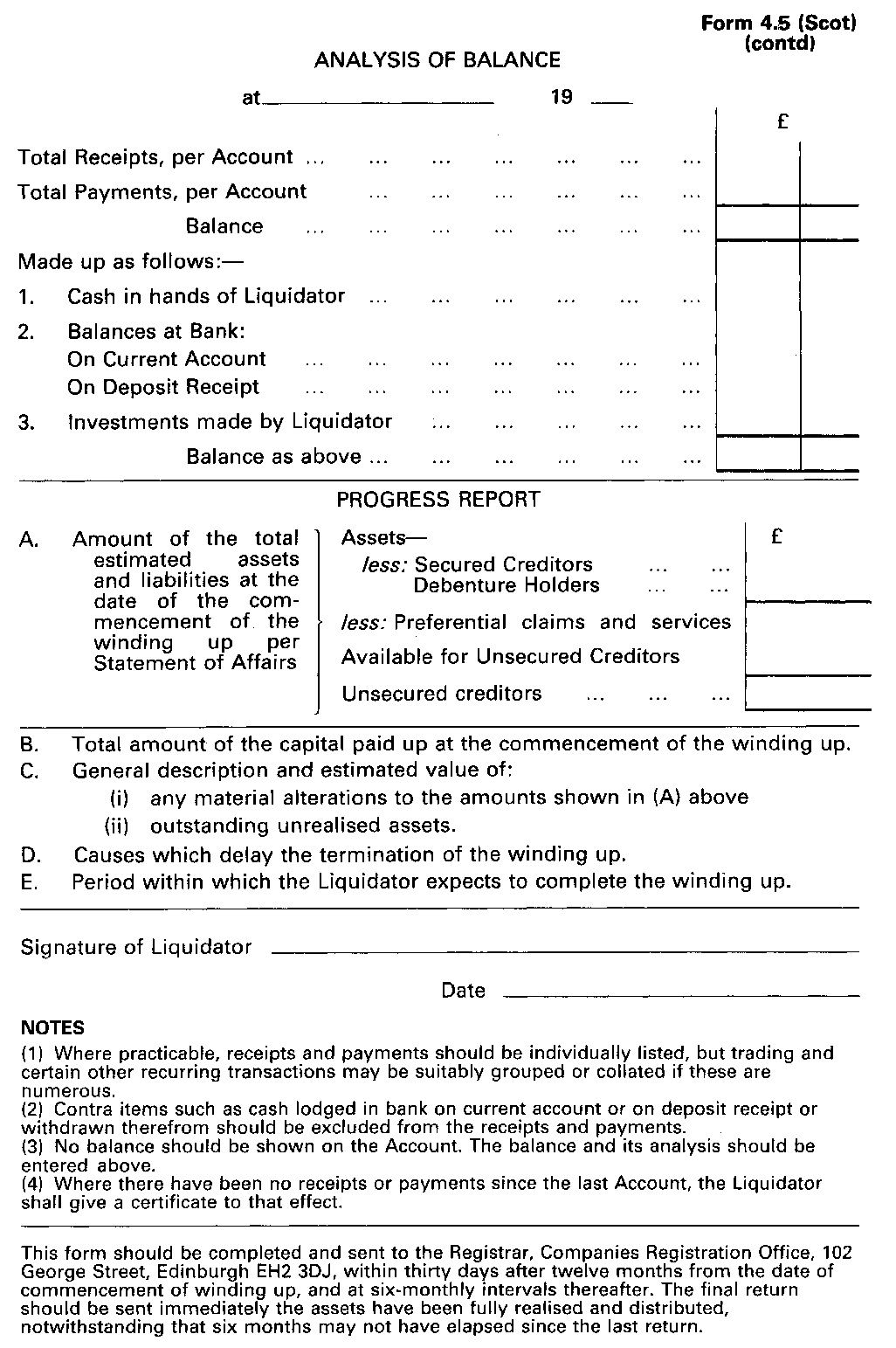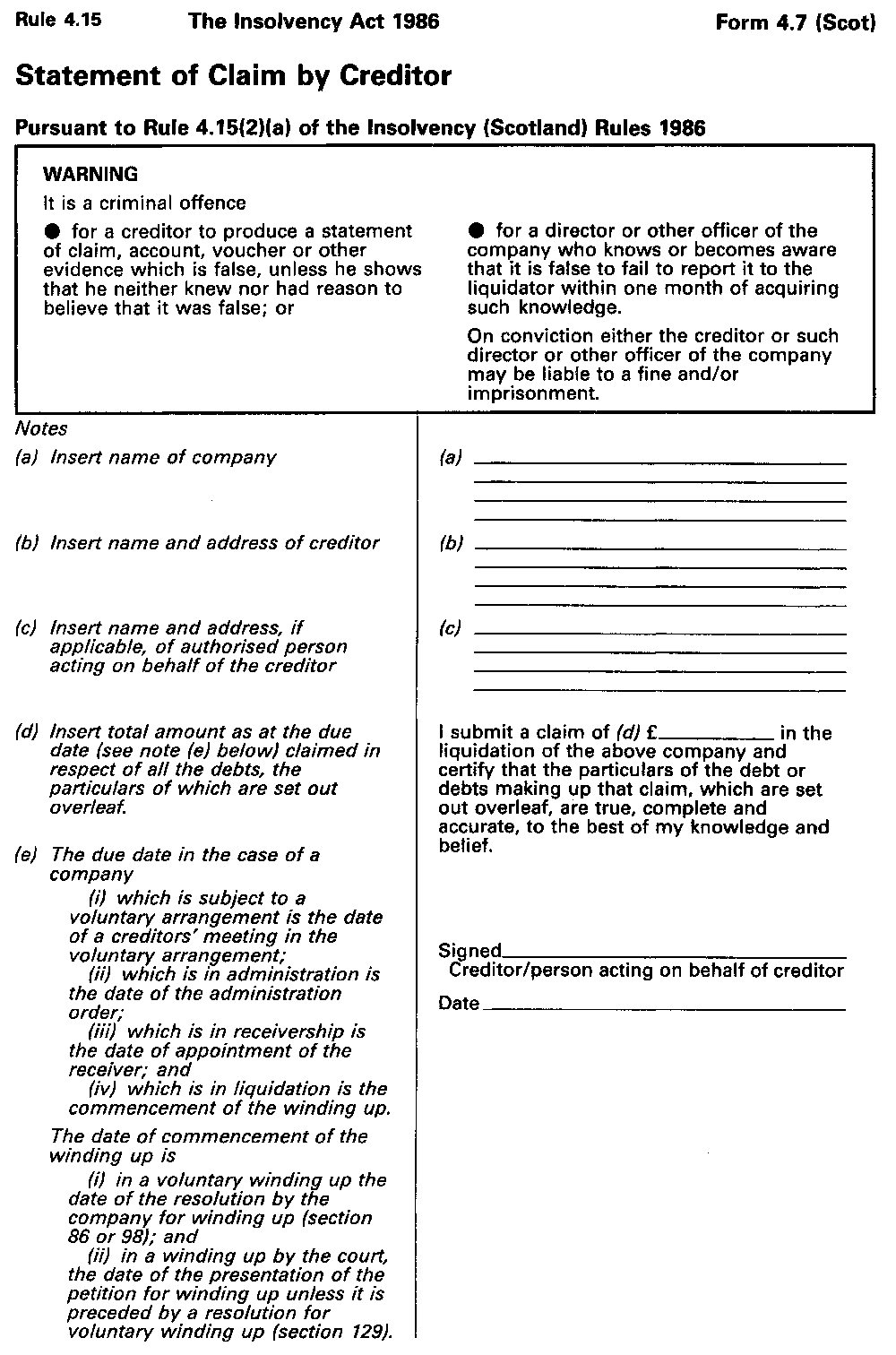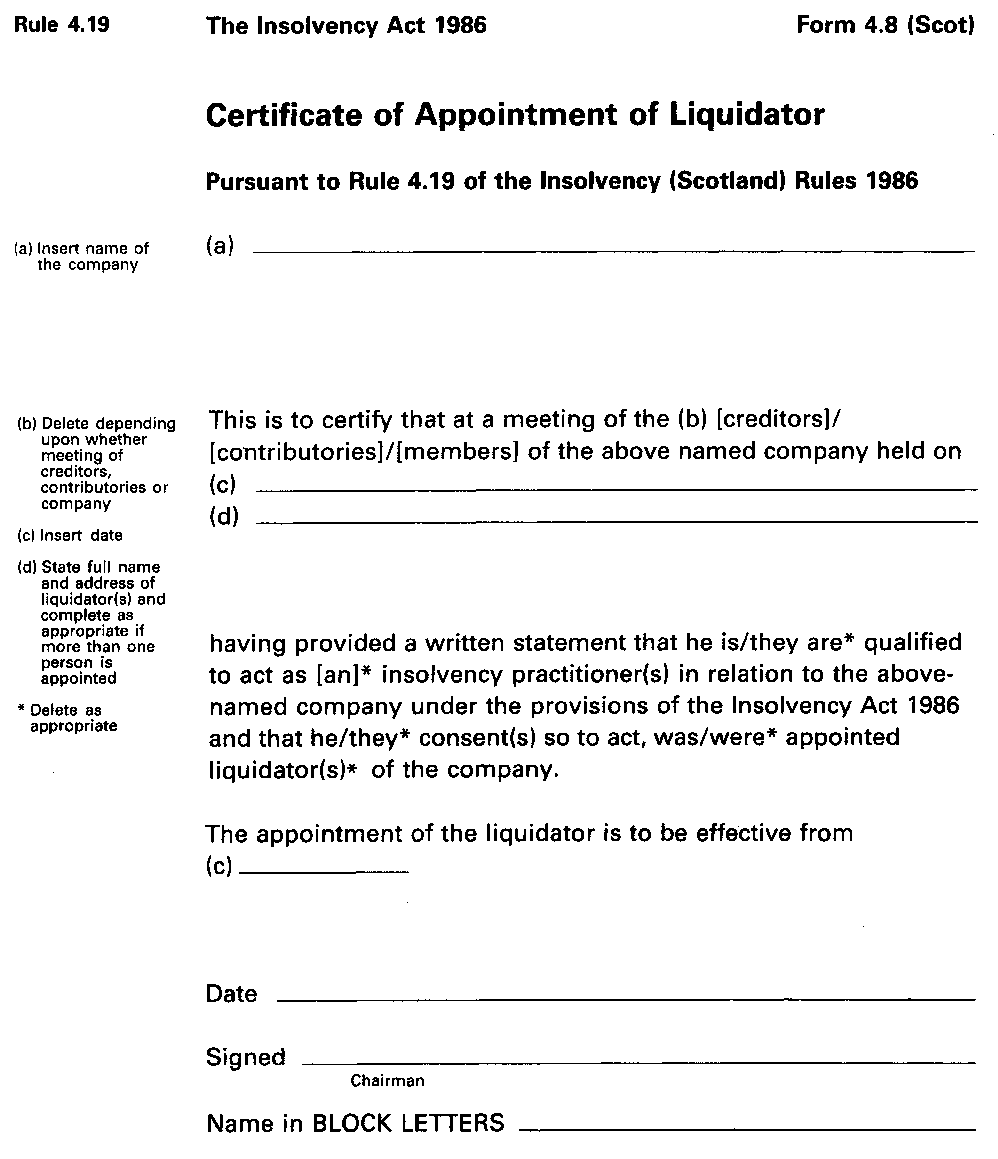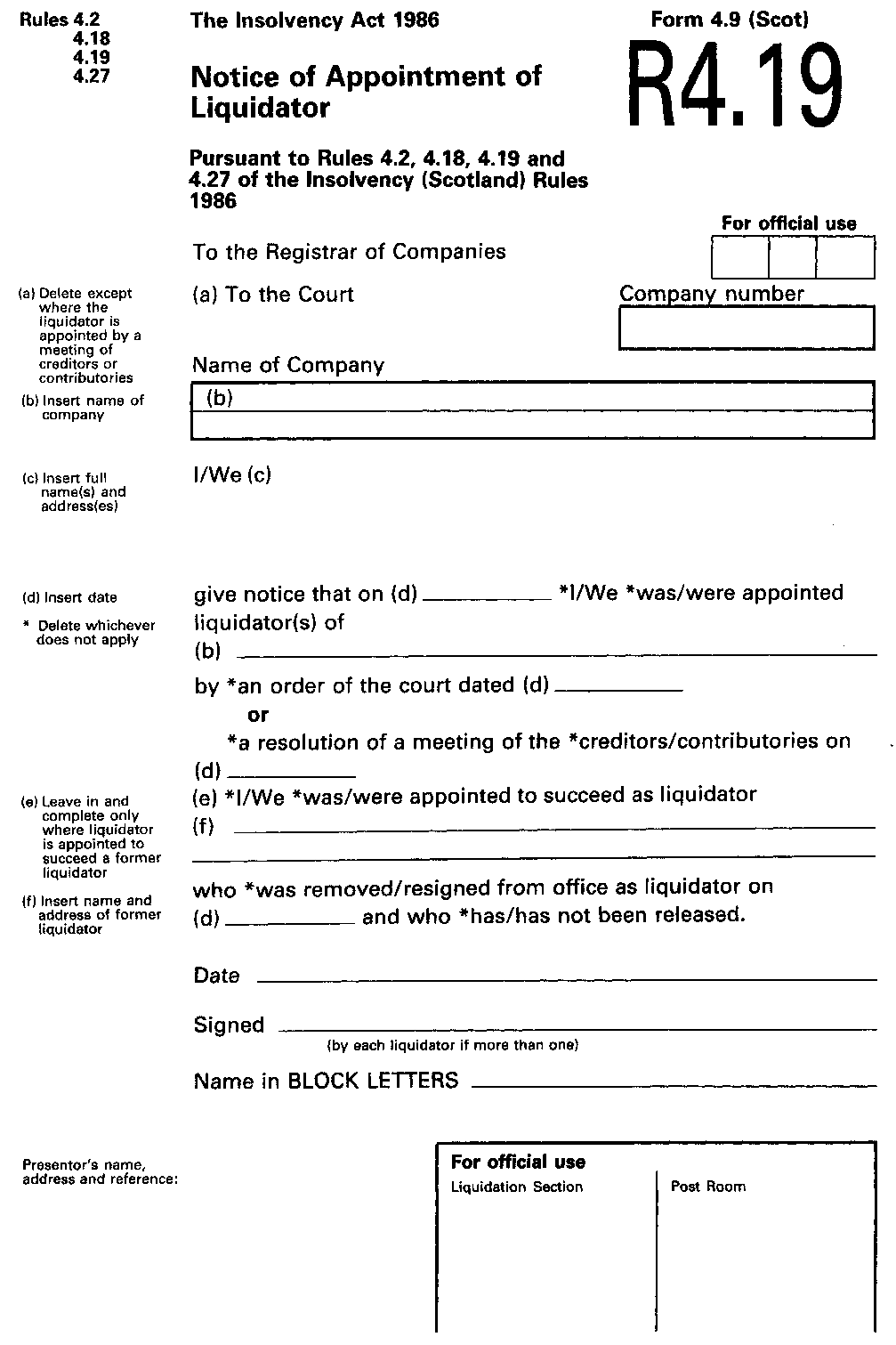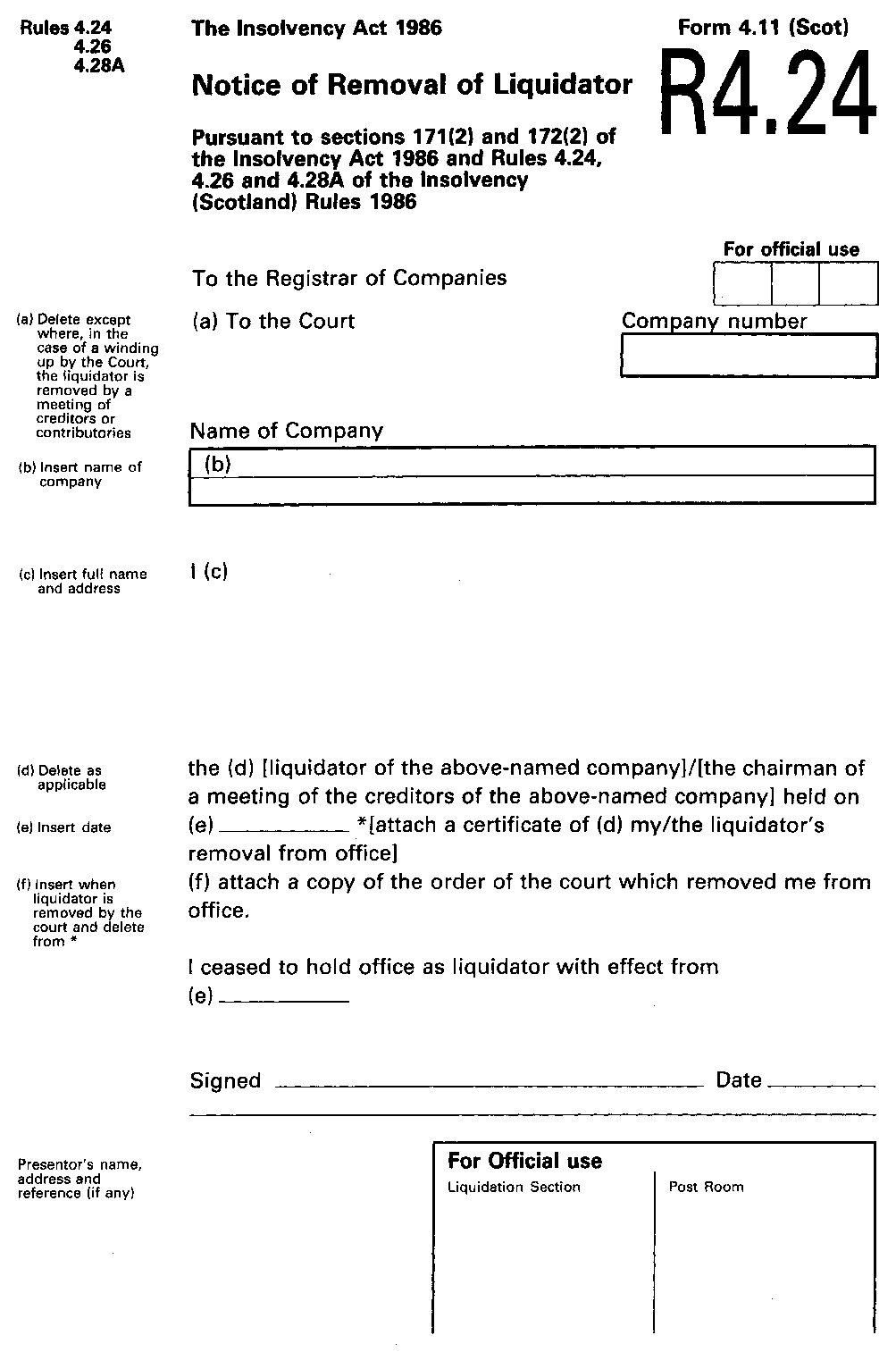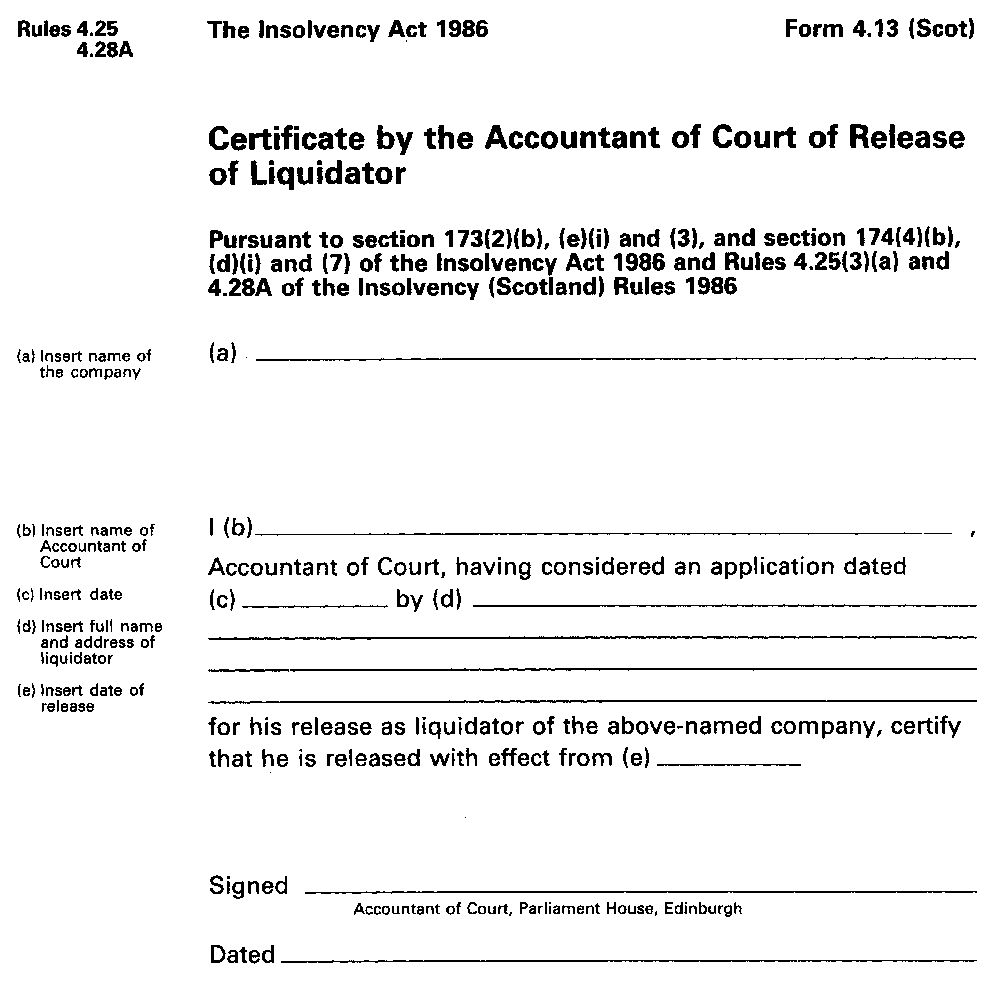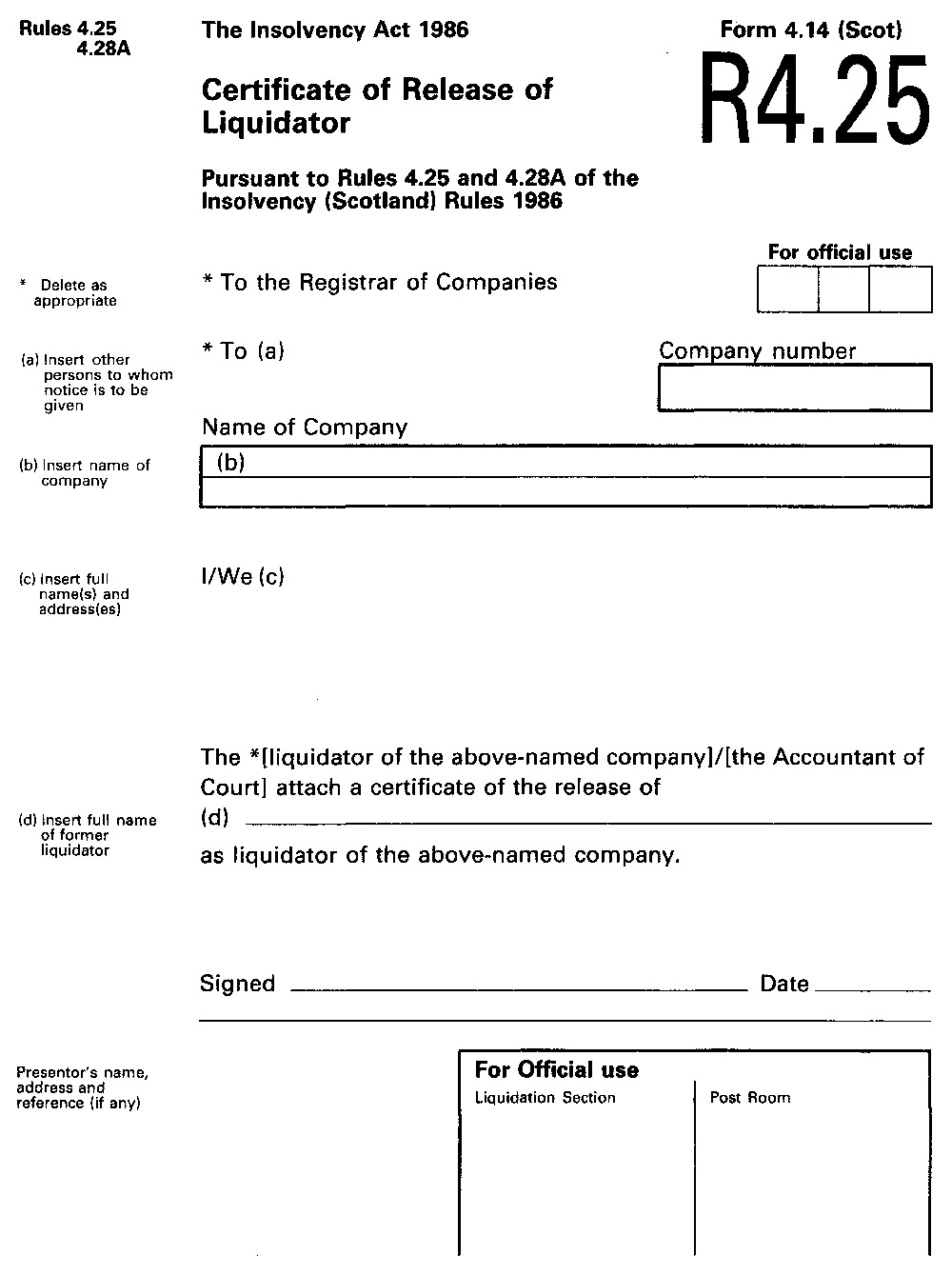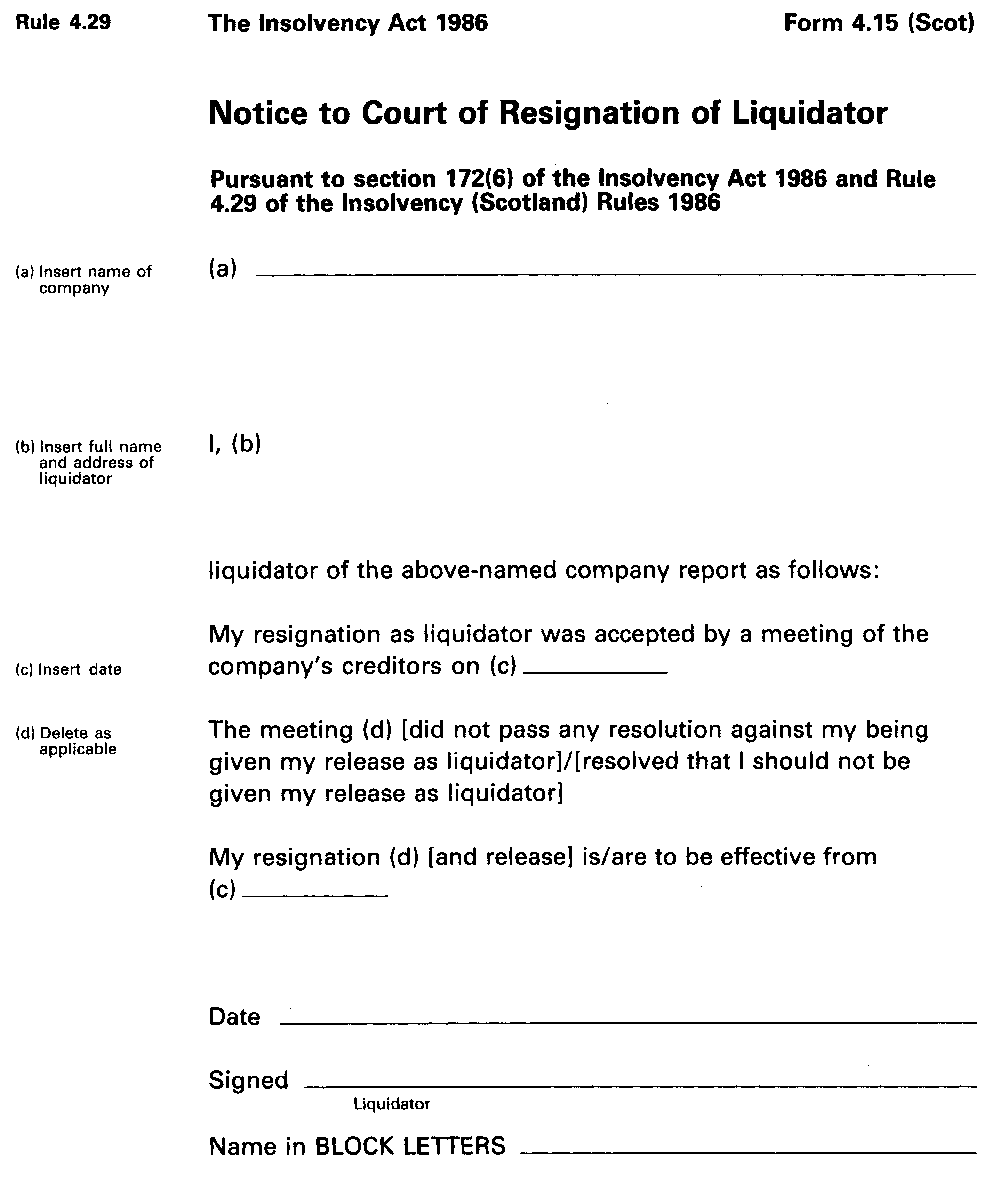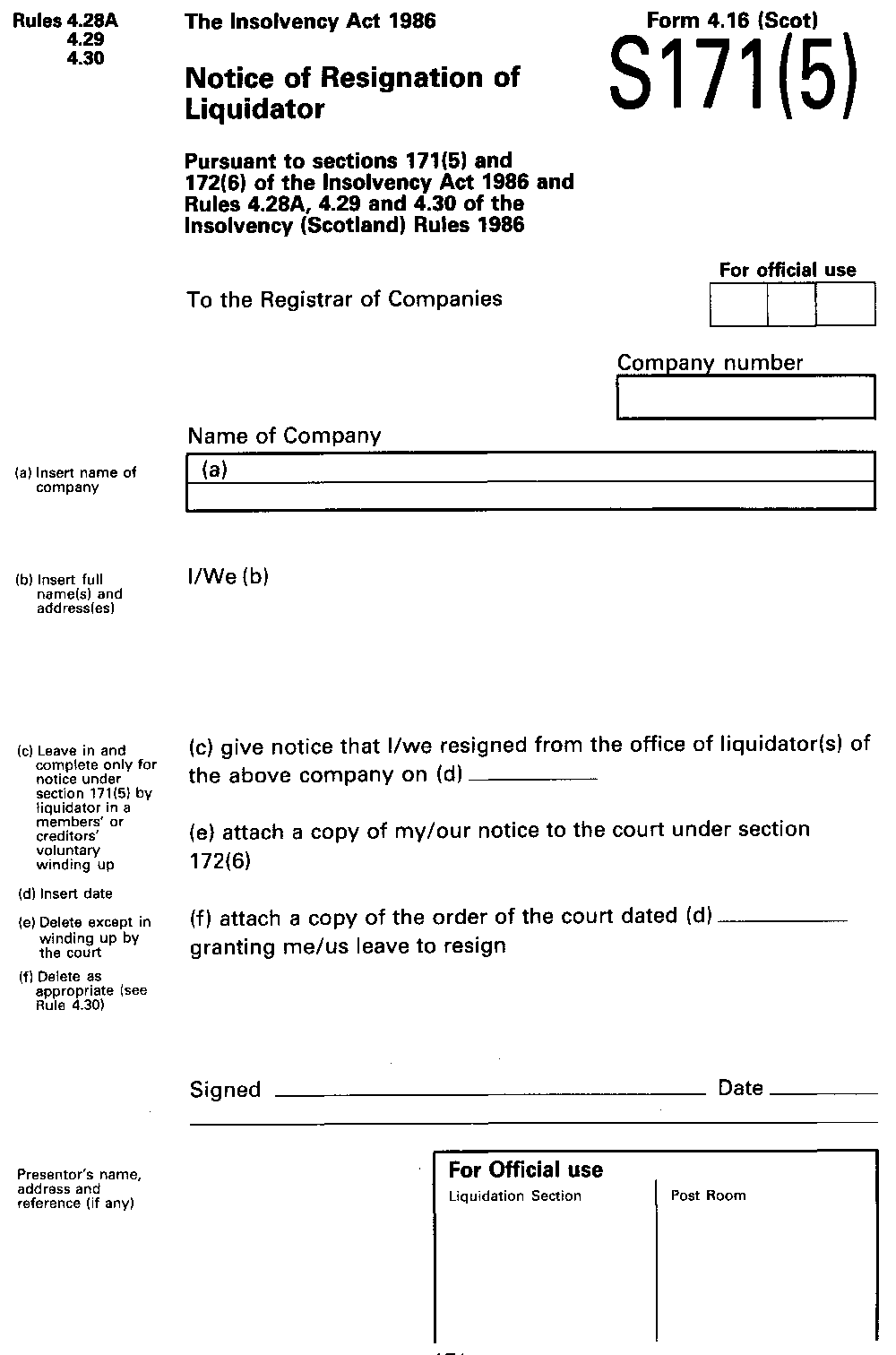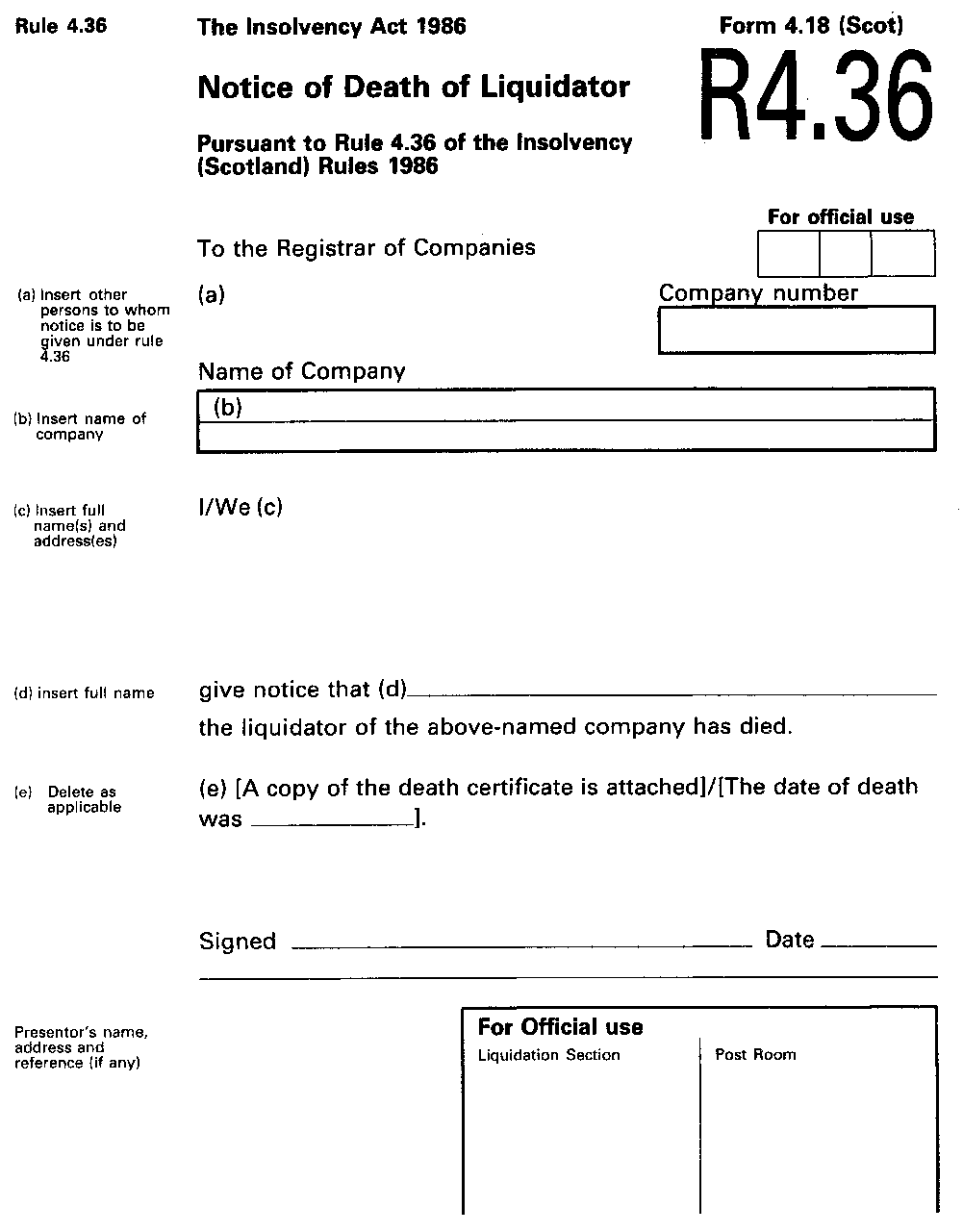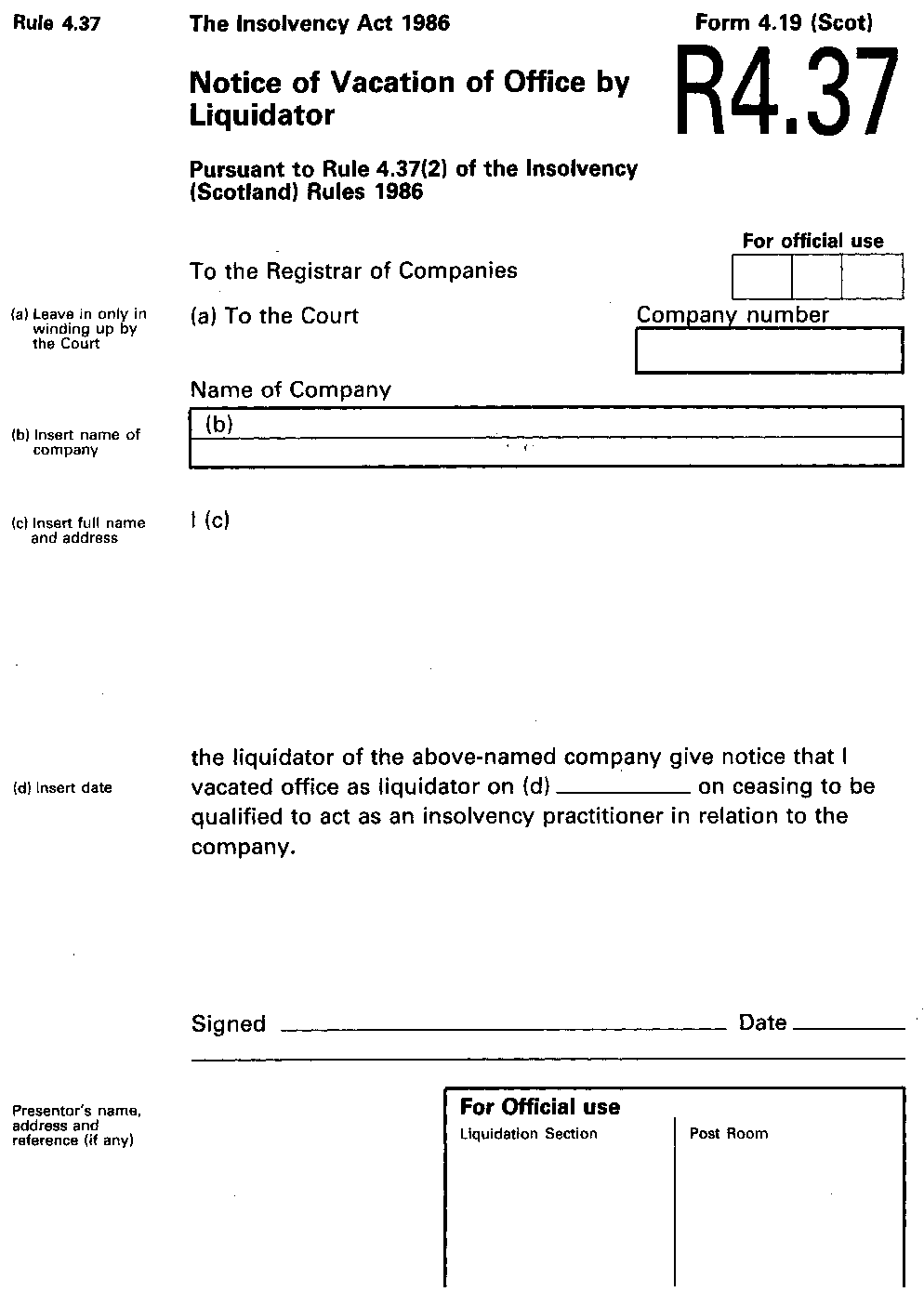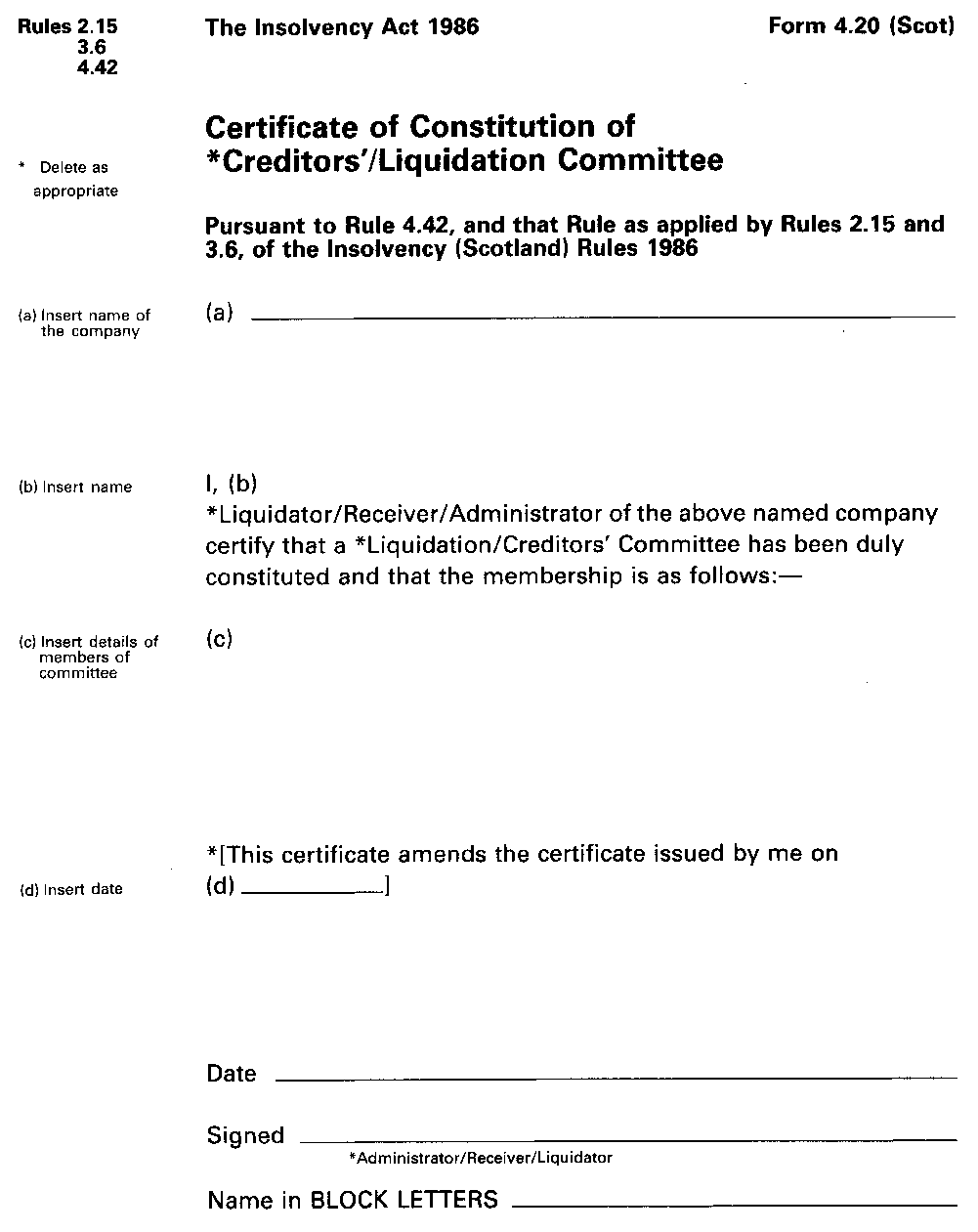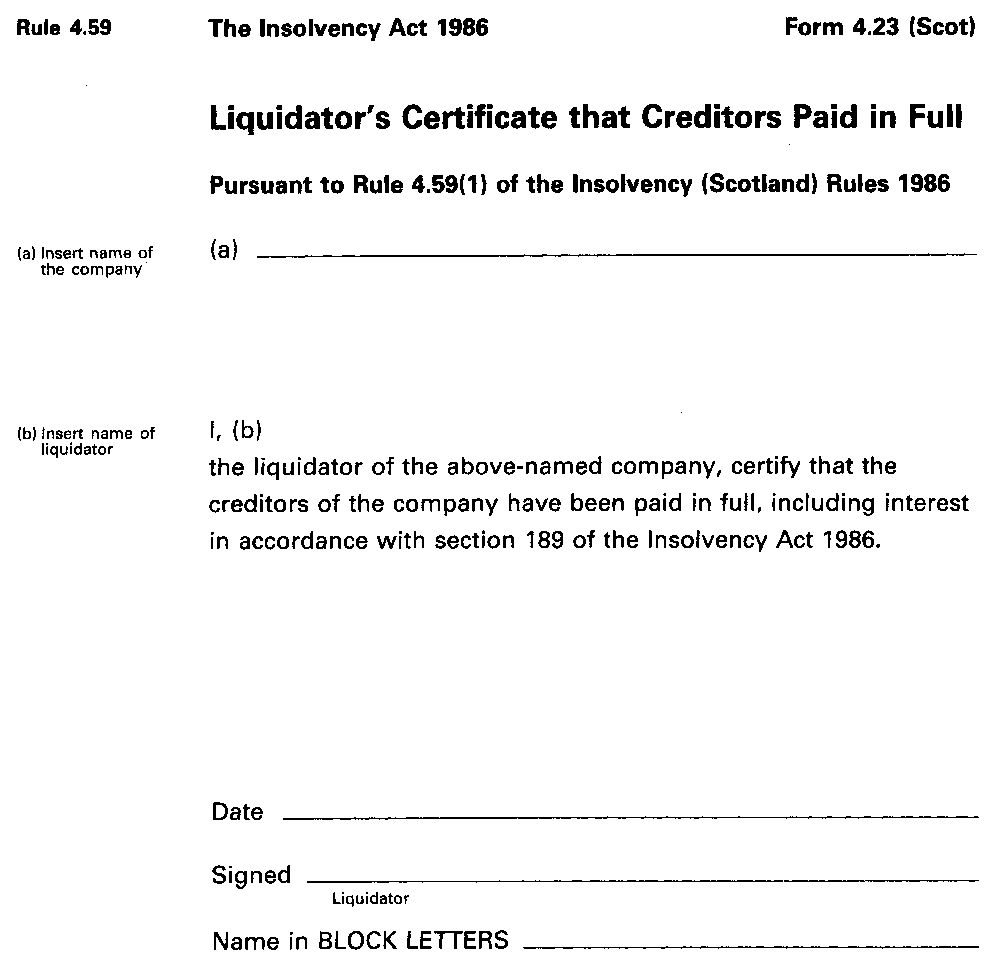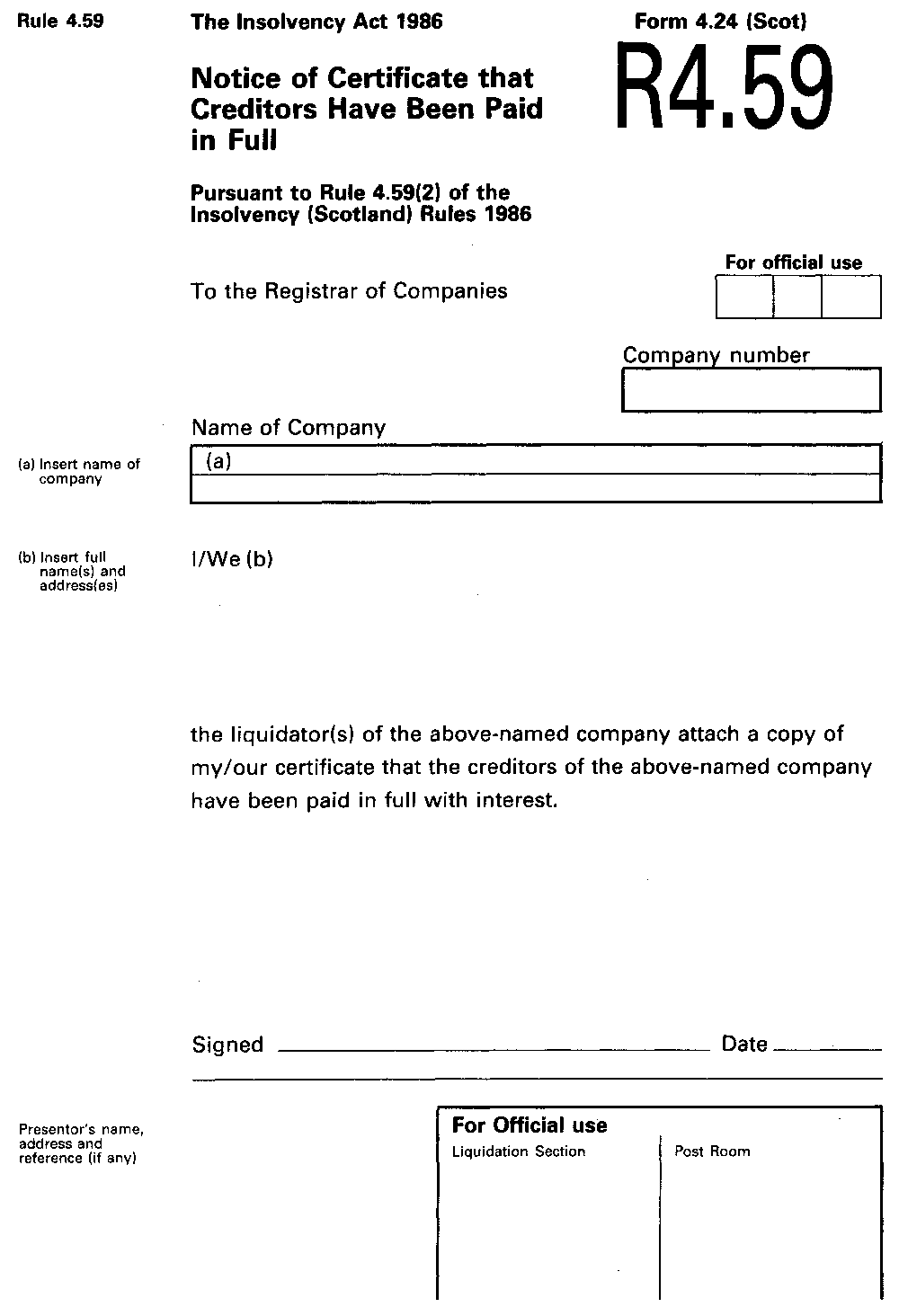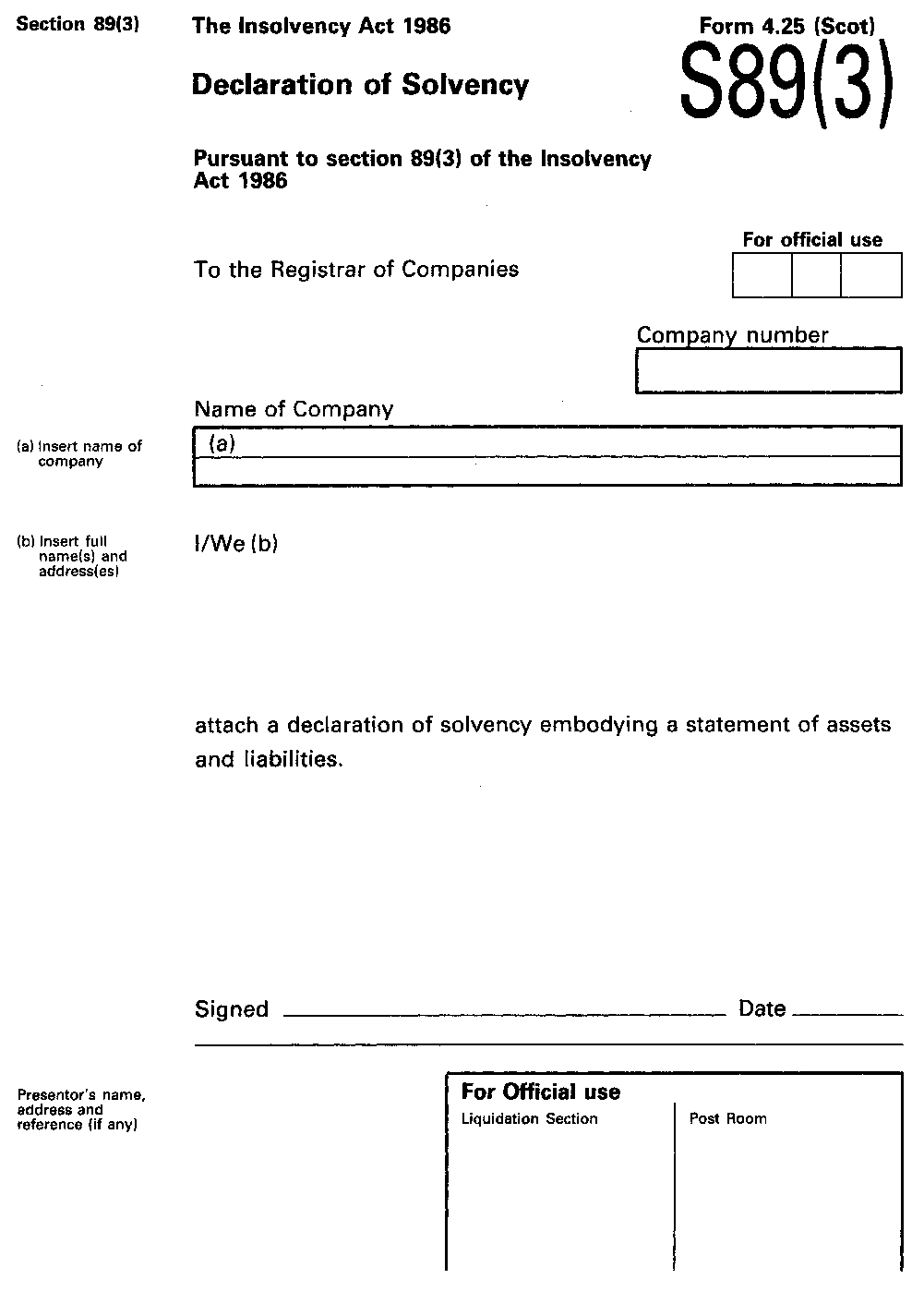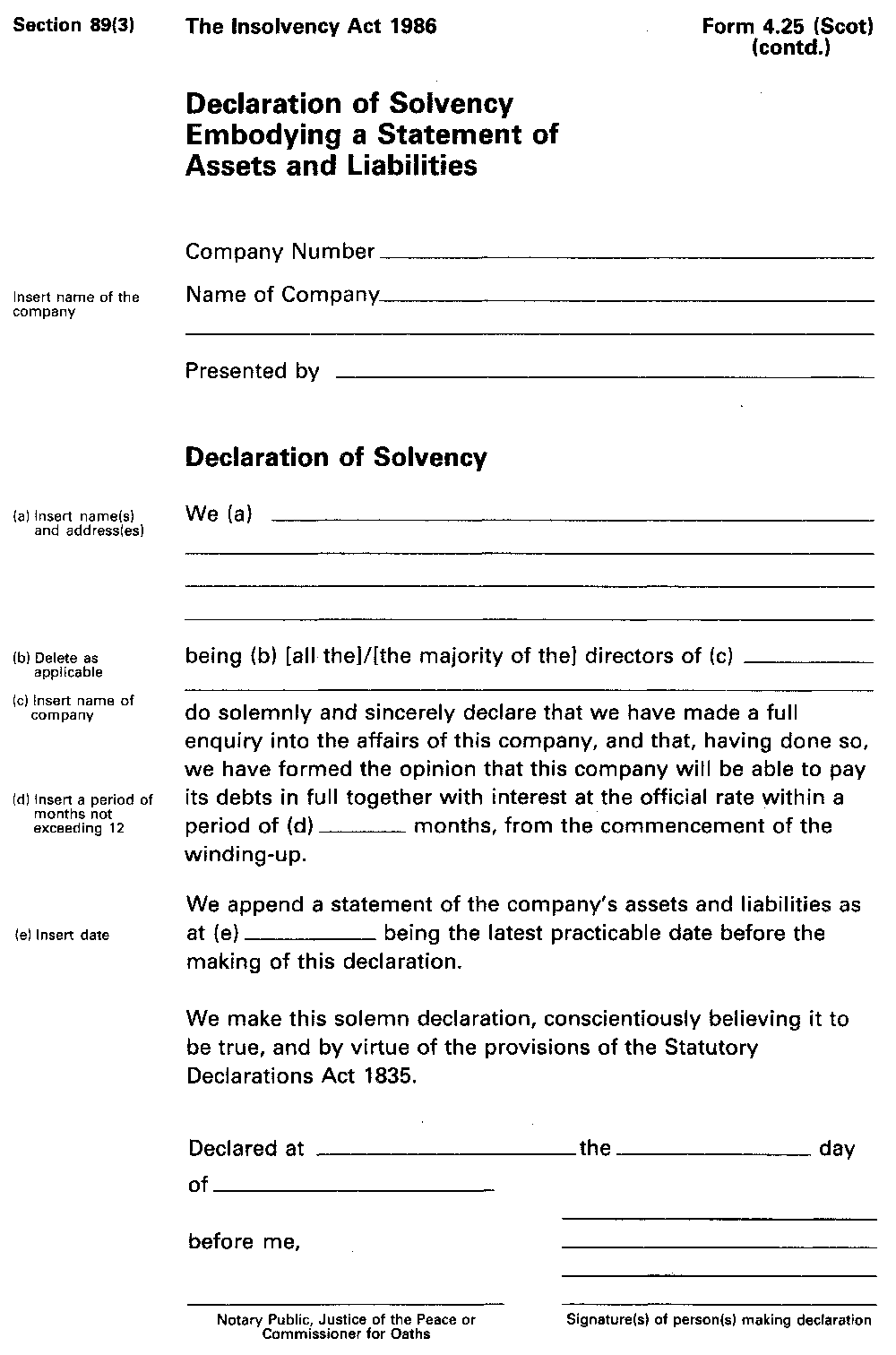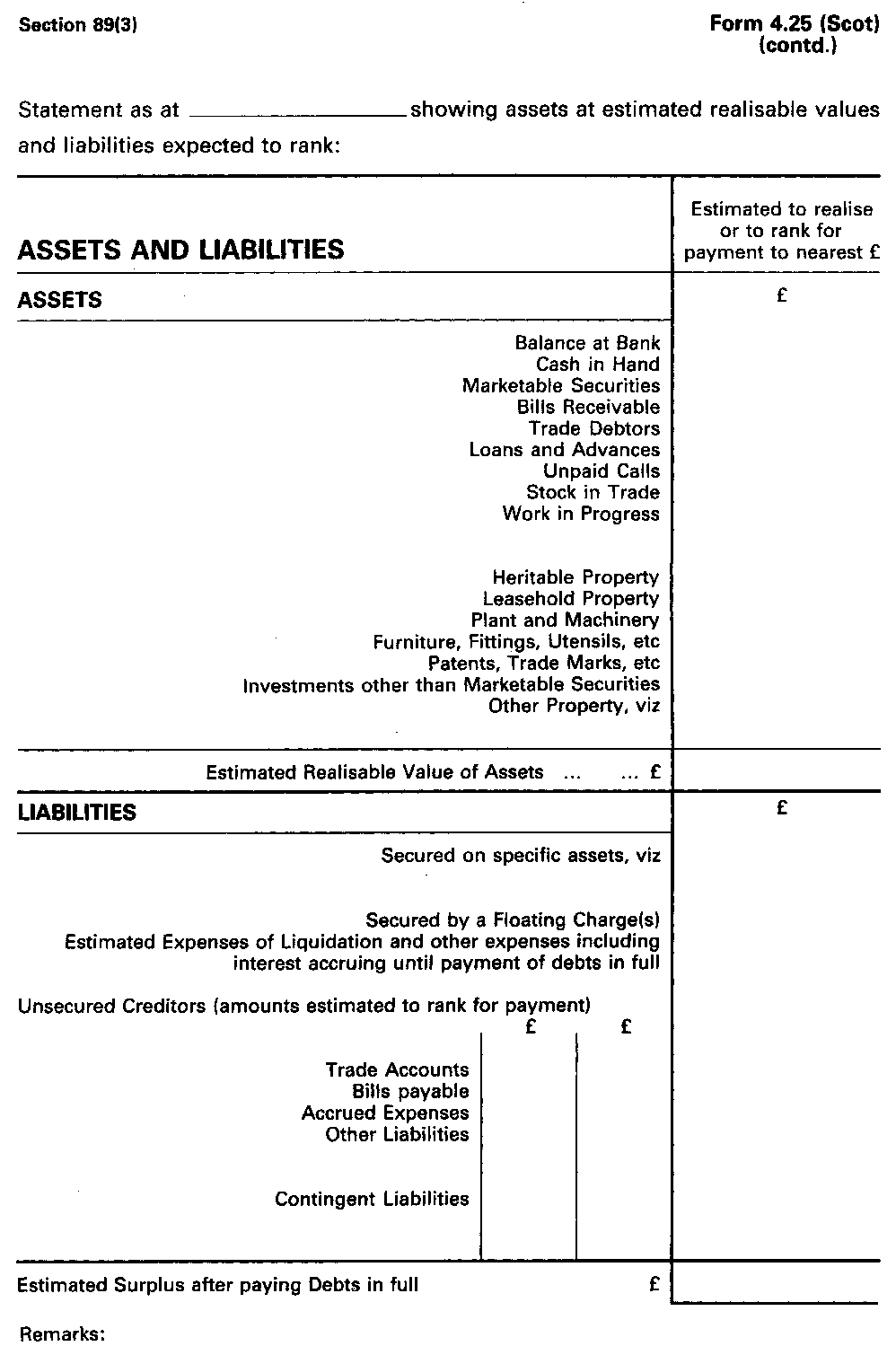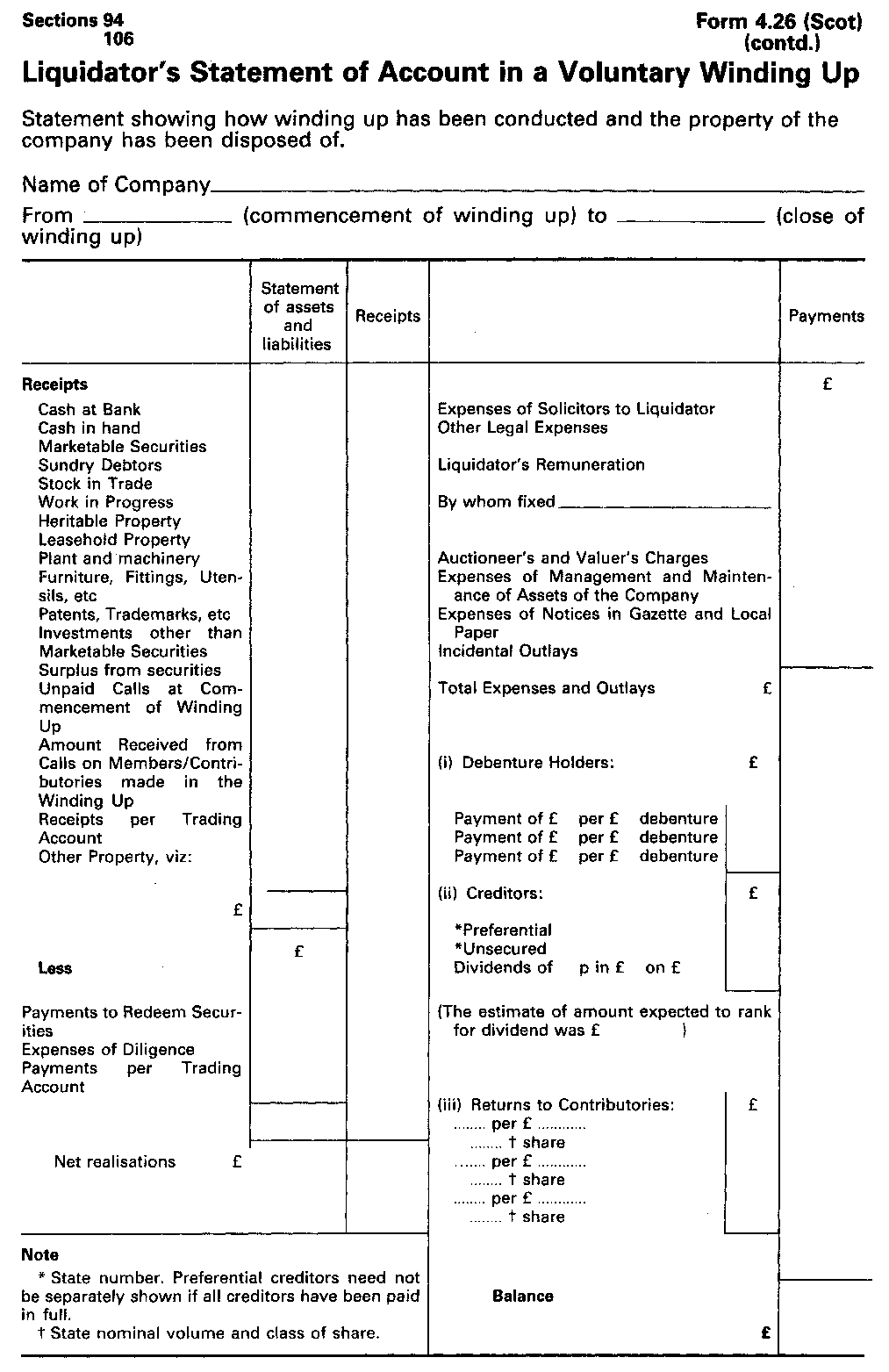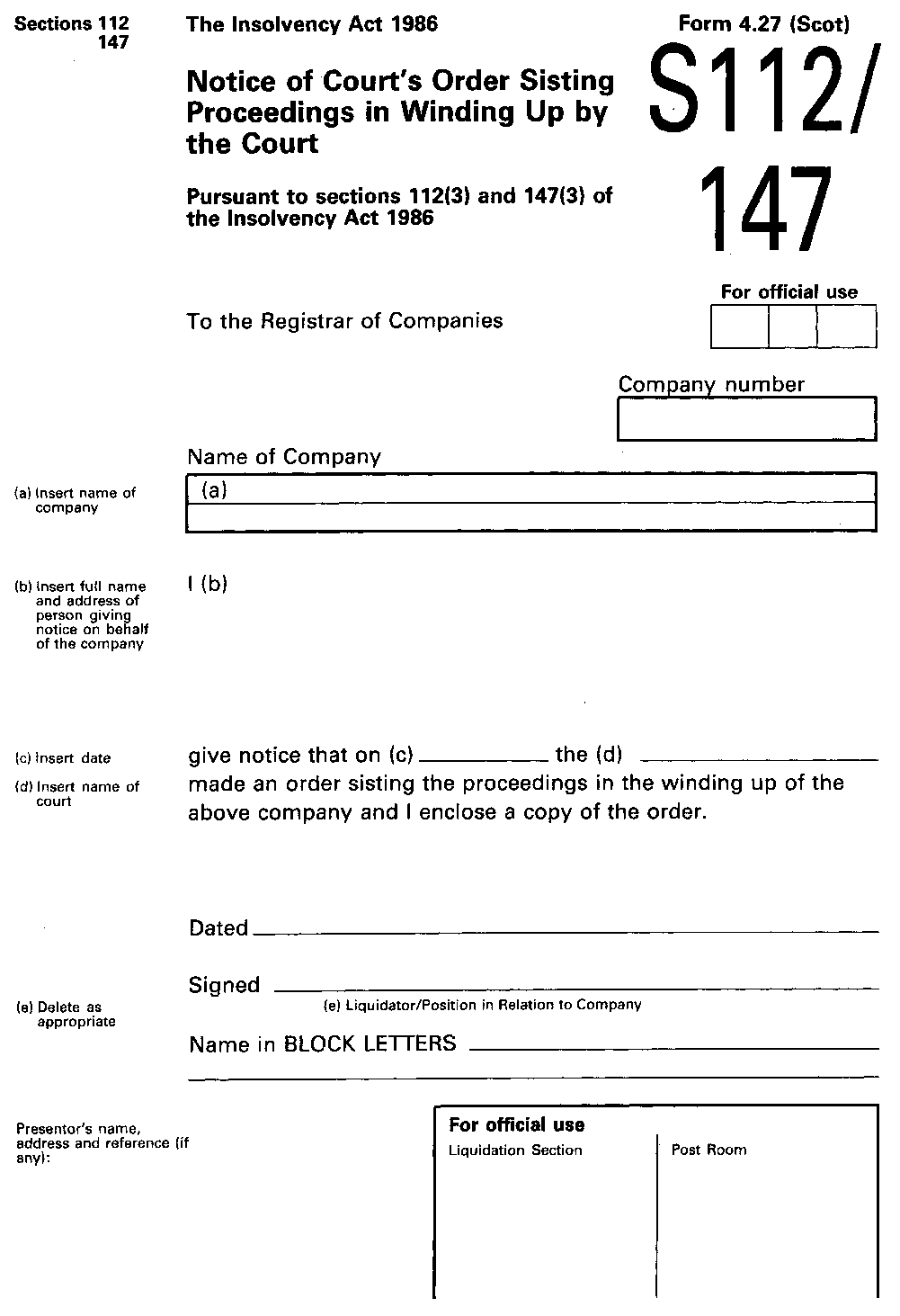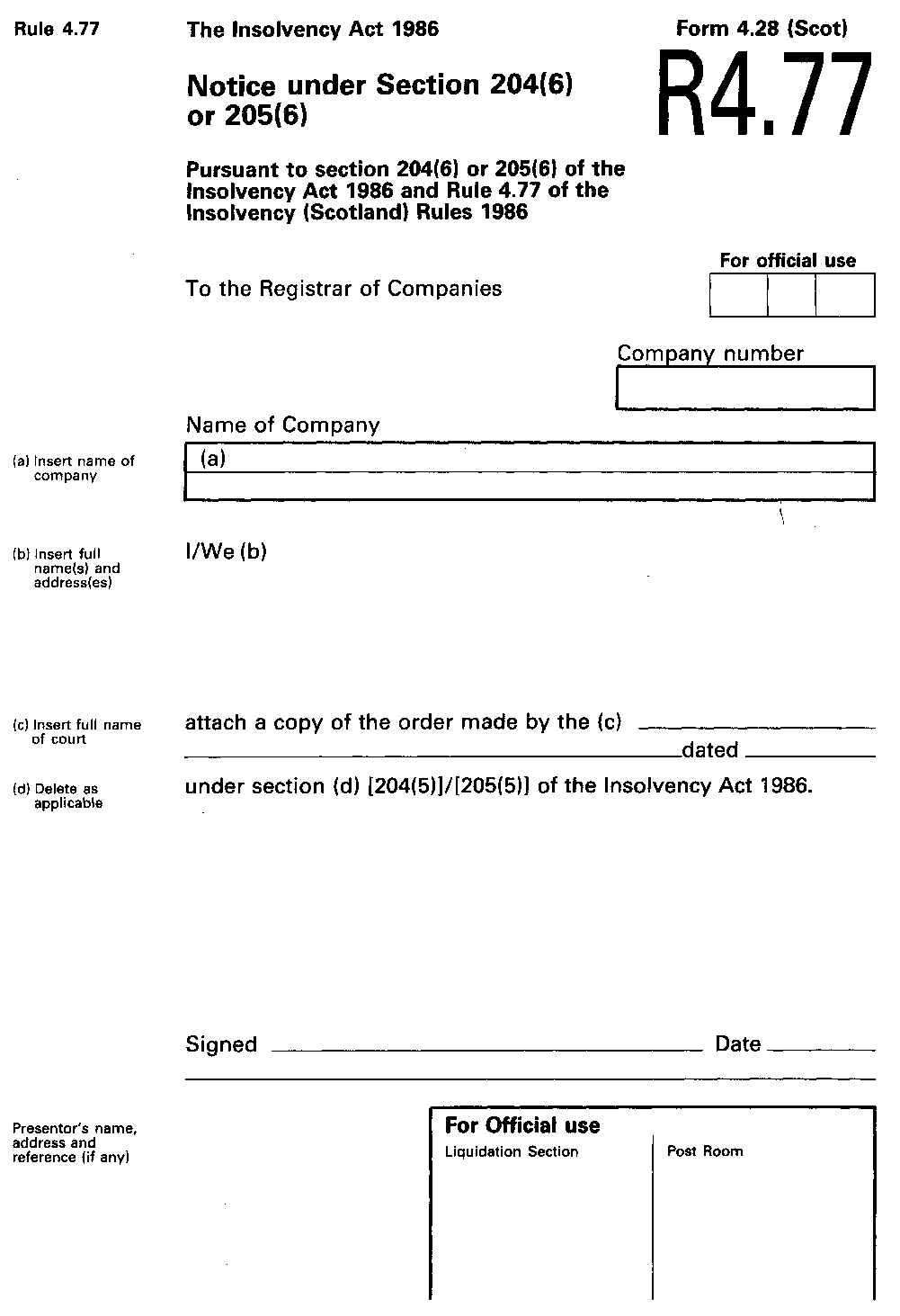- Latest available (Revised)
- Original (As made)
The Insolvency (Scotland) Rules 1986
You are here:
- UK Statutory Instruments
- 1986 No. 1915 (S. 139)
- Whole Instrument
- Previous
- Next
More Resources
Status:
This is the original version (as it was originally made). This item of legislation is currently only available in its original format.
Statutory Instruments
1986 No. 1915 (S. 139)
INSOLVENCY
COMPANIES
The Insolvency (Scotland) Rules 1986
Made
10th November 1986
Laid before Parliament
26th November 1986
Coming into Operation
29th December 1986
The Secretary of State, in exercise of the powers conferred on him by section 411 of the Insolvency Act 1986(1) and of all other powers enabling him in that behalf, hereby makes the following Rules:-
INTRODUCTORY PROVISIONS
Citation and commencement
0.1. These Rules may be cited as the Insolvency (Scotland) Rules 1986 and shall come into operation on 29th December 1986.
Interpretation
0.2.—(1) In these Rules
“the Act” means the Insolvency Act 1986;
“the Companies Act” means the Companies Act 1985(2);
“the Bankruptcy Act” means the Bankruptcy (Scotland) Act 1985(3);
“the Rules” means the Insolvency (Scotland) Rules 1986;
“accounting period” in relation to the winding up of a company, shall be construed in accordance with section 52(1) and (6) of the Bankruptcy Act as applied by Rule 4.68;
“business day” means any day other than a Saturday, a Sunday, Christmas Day, Good Friday or a day which is a bank holiday in any part of Great Britain;
“company” means a company which the courts in Scotland have jurisdiction to wind up;
“insolvency proceedings” means any proceedings under the first group of Parts in the Act or under these Rules;
“receiver” means a receiver appointed under section 51 (Receivers (Scotland)); and
“responsible insolvency practitioner” means, in relation to any insolvency proceedings, the person acting as supervisor of a voluntary arrangement under Part I of the Act, or as administrator, receiver, liquidator or provisional liquidator.
(2) In these Rules, unless the context otherwise requires, any reference -
(a)to a section is a reference to a section of the Act;
(b)to a Rule is a reference to a Rule of the Rules;
(c)to a Part or a Schedule is a reference to a Part of, or Schedule to, the Rules;
(d)to a Chapter is a reference to a Chapter of the Part in which that reference is made.
Application
0.3. These Rules apply -
(a)to receivers appointed, and
(b)to all other insolvency proceedings which are commenced,
on or after the date on which the Rules come into operation.
PART ICOMPANY VOLUNTARY ARRANGEMENTS
CHAPTER 1PRELIMINARY
Scope of this Part; interpretation
1.1.—(1) The Rules in this Part apply where, pursuant to Part I of the Act, it is intended to make and there is made a proposal to a company and to its creditors for a voluntary arrangement, that is to say, a composition in satisfaction of its debts or a scheme of arrangement of its affairs.
(2) In this Part -
(a)Chapter 2 applies where the proposal for a voluntary arrangement is made by the directors of the company, and neither is the company in liquidation nor is an administration order under Part II of the Act in force in relation to it;
(b)Chapter 3 applies where the company is in liquidation or an administration order is in force and the proposal is made by the liquidator or (as the case may be) the administrator, he in either case being the nominee for the purposes of the proposal;
(c)Chapter 4 applies in the same case as Chapter 3, but where the nominee is an insolvency practitioner other than the liquidator or administrator; and
(d)Chapters 5 and 6 apply in all of the three cases mentioned in sub-paragraphs (a) to (c) above.
(3) In Chapters 3, 4 and 5 the liquidator or the administrator is referred to as the “responsible insolvency practitioner”.
CHAPTER 2PROPOSAL BY DIRECTORS
Preparation of proposal
1.2. The directors shall prepare for the intended nominee a proposal on which (with or without amendments to be made under Rule 1.3 below) to make his report to the court under section 2.
Contents of proposal
1.3.—(1) The directors' proposal shall provide a short explanation why, in their opinion, a voluntary arrangement under Part I of the Act is desirable, and give reasons why the company's creditors may be expected to concur with such an arrangement.
(2) The following matters shall be stated, or otherwise dealt with, in the directors' proposal -
(a)the following matters, so far as within the directors' immediate knowledge -
(i)the company's assets, with an estimate of their respective values;
(ii)the extent (if any) to which the assets are subject to any security in favour of any creditors;
(iii)the extent (if any) to which particular assets of the company are to be excluded from the voluntary arrangement;
(b)particulars of any property other than assets of the company itself, which is proposed to be included in the arrangement, the source of such property and the terms on which it is to be made available for inclusion;
(c)the nature and amount of the company's liabilities (so far as within the directors' immediate knowledge), the manner in which they are proposed to be met, modified, postponed or otherwise dealt with by means of the arrangement, and (in particular) -
(i)how it is proposed to deal with preferential creditors (defined in section 386) and creditors who are, or claim to be, secured;
(ii)how persons connected with the company (being creditors) are proposed to be treated under the arrangement; and
(iii)whether there are, to the directors' knowledge, any circumstances giving rise to the possibility, in the event that the company should go into liquidation, of claims under -
section 242 (gratuitous alienations),
section 243 (unfair preferences),
section 244 (extortionate credit transactions), or
section 245 (floating charges invalid);
and, where any such circumstances are present, whether, and if so how, it is proposed under the voluntary arrangement to make provision for wholly or partly indemnifying the company in respect of such claims;
(d)whether any, and if so what, cautionary obligations (including guarantees) have been given of the company's debts by other persons, specifying which (if any) of the cautioners are persons connected with the company;
(e)the proposed duration of the voluntary arrangement;
(f)the proposed dates of distributions to creditors, with estimates of their amounts;
(g)the amount proposed to be paid to the nominee (as such) by way of remuneration and expenses;
(h)the manner in which it is proposed that the supervisor of the arrangement should be remunerated and his expenses defrayed;
(i)whether, for the purposes of the arrangement, any cautionary obligations (including guarantees) are to be offered by directors, or other persons, and whether (if so) any security is to be given or sought;
(j)the manner in which funds held for the purposes of the arrangement are to be banked, invested or otherwise dealt with pending distribution to creditors;
(k)the manner in which funds held for the purpose of payment to creditors, and not so paid on the termination of the arrangement, are to be dealt with;
(l)the manner in which the business of the company is being and is proposed to be conducted during the course of the arrangement;
(m)details of any further credit facilities which it is intended to arrange for the company and how the debts so arising are to be paid;
(n)the functions which are to be undertaken by the supervisor of the arrangement;
(o)the name, address and qualification of the person proposed as supervisor of the voluntary arrangement, and confirmation that he is (so far as the directors are aware) qualified to act as an insolvency practitioner in relation to the company.
(3) With the agreement in writing of the nominee, the directors' proposal may be amended at any time up to delivery of the former's report to the court under section 2(2).
Notice to intended nominee
1.4.—(1) The directors shall give to the intended nominee written notice of their proposal.
(2) The notice, accompanied by a copy of the proposal, shall be delivered either to the nominee himself, or to a person authorised to take delivery of documents on his behalf.
(3) If the intended nominee agrees to act, he shall cause a copy of the notice to be endorsed to the effect that it has been received by him on a specified date; and the period of 28 days referred to in section 2(2) then runs from that date.
(4) The copy of the notice so endorsed shall be returned by the nominee forthwith to the directors at an address specified by them in the notice for that purpose.
Statement of affairs
1.5.—(1) The directors shall, within 7 days after their proposal is delivered to the nominee, or within such longer time as he may allow, deliver to him a statement of the company's affairs.
(2) The statement shall comprise the following particulars (supplementing or amplifying, so far as is necessary for clarifying the state of the company's affairs, those already given in the directors' proposal): -
(a)a list of the company's assets, divided into such categories as are appropriate for easy identification, with estimated values assigned to each category;
(b)in the case of any property on which a claim against the company is wholly or partly secured, particulars of the claim and its amount and of how and when the security was created;
(c)the names and addresses of the company's preferential creditors (defined in section 386), with the amounts of their respective claims;
(d)the names and addresses of the company's unsecured creditors, with the amounts of their respective claims;
(e)particulars of any debts owed by or to the company to or by persons connected with it;
(f)the names and addresses of the company's members and details of their respective shareholdings; and
(g)such other particulars (if any) as the nominee may in writing require to be furnished for the purposes of making his report to the court on the directors' proposal.
(3) The statement of affairs shall be made up to a date not earlier than 2 weeks before the date of the notice given by the directors to the nominee under Rule 1.4. However the nominee may allow an extension of that period to the nearest practicable date (not earlier than 2 months before the date of the notice under Rule 1.4); and if he does so, he shall give his reasons in his report to the court on the directors' proposal.
(4) The statement shall be certified as correct, to the best of their knowledge and belief, by two or more directors of the company or by the company secretary and at least one director (other than the secretary himself).
Additional disclosure for assistance of nominee
1.6.—(1) If it appears to the nominee that he cannot properly prepare his report on the basis of information in the directors' proposal and statement of affairs, he may call on the directors to provide him with -
(a)further and better particulars as to the circumstances in which, and the reasons why, the company is insolvent or (as the case may be) threatened with insolvency;
(b)particulars of any previous proposals which have been made in respect of the company under Part I of the Act;
(c)any further information with respect to the company's affairs which the nominee thinks necessary for the purposes of his report.
(2) The nominee may call on the directors to inform him, with respect to any person who is, or at any time in the 2 years preceding the notice under Rule 1.4 has been, a director or officer of the company, whether and in what circumstances (in those 2 years or previously) that person -
(a)has been concerned in the affairs of any other company (whether or not incorporated in Scotland) which has become insolvent, or
(b)has had his estate sequestrated, granted a trust deed for his creditors, been adjudged bankrupt or compounded or entered into an arrangement with his creditors.
(3) For the purpose of enabling the nominee to consider their proposal and prepare his report on it, the directors must give him access to the company's accounts and records.
Nominee's report on the proposal
1.7.—(1) With his report to the court under section 2 the nominee shall lodge -
(a)a copy of the directors' proposal (with amendments, if any, authorised under Rule 1.3(3));
(b)a copy or summary of the company's statement of affairs.
(2) If the nominee makes known his opinion that meetings of the company and its creditors should be summoned under section 3, his report shall have annexed to it his comments on the proposal. If his opinion is otherwise, he shall give his reasons for that opinion.
(3) The nominee shall send a copy of his report and of his comments (if any) to the company. Any director, member or creditor of the company is entitled, at all reasonable times on any business day, to inspect the report and comments.
Replacement of nominee
1.8. Where any person intends to apply to the court under section 2(4) for the nominee to be replaced he shall give to the nominee at least 7 days' notice of his application.
Summoning of meetings under section 3
1.9.—(1) If in his report the nominee states that in his opinion meetings of the company and its creditors should be summoned to consider the directors' proposal, the date on which the meetings are to be held shall be not less than 14, nor more than 28 days from the date on which he lodged his report in court under section 2.
(2) The notice summoning the meeting shall specify the court in which the nominee's report under section 2 has been lodged and with each notice there shall be sent -
(a)a copy of the directors' proposal;
(b)a copy of the statement of affairs or, if the nominee thinks fit, a summary of it (the summary to include a list of creditors and the amount of their debts); and
(c)the nominee's comments on the proposal.
CHAPTER 3PROPOSAL BY ADMINISTRATOR OR LIQUIDATOR WHERE HE IS THE NOMINEE
Preparation of proposal
1.10. The responsible insolvency practitioner's proposal shall specify -
(a)all such matters as under Rule 1.3 in Chapter 2 the directors of the company would be required to include in a proposal by them, and
(b)such other matters (if any) as the insolvency practitioner considers appropriate for ensuring that members and creditors of the company are enabled to reach an informed decision on the proposal.
Summoning of meetings under section 3
1.11.—(1) The responsible insolvency practitioner shall give at least 14 days' notice of the meetings of the company and of its creditors under section 3(2).
(2) With each notice summoning the meeting, there shall be sent -
(a)a copy of the responsible insolvency practitioner's proposal; and
(b)a copy of the company's statement of affairs or, if he thinks fit, a summary of it (the summary to include a list of the creditors and the amount of their debts).
CHAPTER 4PROPOSAL BY ADMINISTRATOR OR LIQUIDATOR WHERE ANOTHER INSOLVENCY PRACTITIONER IS THE NOMINEE
Preparation of proposal and notice to nominee
1.12.—(1) The responsible insolvency practitioner shall give notice to the intended nominee, and prepare his proposal for a voluntary arrangement, in the same manner as is required of the directors in the case of a proposal by them, under Chapter 2.
(2) Rule 1.2 applies to the responsible insolvency practitioner as it applies to the directors; and Rule 1.4 applies as regards the action to be taken by the nominee.
(3) The content of the proposal shall be as required by Rule 1.3, reading references to the directors as referring to the responsible insolvency practitioner.
(4) Rule 1.6 applies, in respect of the information to be provided to the nominee, reading references to the directors as referring to the responsible insolvency practitioner.
(5) With the proposal the responsible insolvency practitioner shall provide a copy of the company's statement of affairs.
(6) Rules 1.7 to 1.9 apply as regards a proposal under this Chapter as they apply to a proposal under Chapter 2.
CHAPTER 5MEETINGS
General
1.13. The provisions of Chapter 1 of Part 7 (Meetings) shall apply with regard to the meetings of the company and of the creditors which are summoned under section 3, subject to Rules 1.9, 1.11 and 1.12(6) and the provisions in this Chapter.
Summoning of meetings
1.14.—(1) In fixing the date, time and place for the creditors' meeting and the company meeting, the person summoning the meetings (“the convenor”) shall have regard primarily to the convenience of the creditors.
(2) The meetings shall be held on the same day and in the same place, but the creditors' meeting shall be fixed for a time in advance of the company meeting.
Attendance by company officers
1.15.—(1) At least 14 days' notice to attend the meetings shall be given by the convenor to -
(a)all directors of the company, and
(b)any persons in whose case the convenor thinks that their presence is required as being officers of the company or as having been directors or officers of it at any time in the 2 years immediately preceding the date of the notice.
(2) The chairman may, if he thinks fit, exclude any present or former director or officer from attendance at a meeting, either completely or for any part of it; and this applies whether or not a notice under this Rule has been sent to the person excluded.
Adjournments
1.16.—(1) On the day on which the meetings are held, they may from time to time be adjourned; and, if the chairman thinks fit for the purpose of obtaining the simultaneous agreement of the meetings to the proposal (with the same modifications, if any), the meetings may be held together.
(2) If on that day the requisite majority for the approval of the voluntary arrangement (with the same modifications, if any) has not been obtained from both creditors and members of the company, the chairman may, and shall, if it is so resolved, adjourn the meetings for not more than 14 days.
(3) If there are subsequently further adjournments, the final adjournment shall not be to a day later than 14 days after the date on which the meetings were originally held.
(4) There shall be no adjournment of either meeting unless the other is also adjourned to the same business day.
(5) In the case of a proposal by the directors, if the meetings are adjourned under paragraph (2), notice of the fact shall be given by the nominee forthwith to the court.
(6) If following any final adjournment of the meetings the proposal (with the same modifications, if any) is not agreed by both meetings, it is deemed rejected.
Report of meetings
1.17.—(1) A report of the meetings shall be prepared by the person who was chairman of them.
(2) The report shall -
(a)state whether the proposal for a voluntary arrangement was approved or rejected and, if approved, with what (if any) modifications;
(b)set out the resolutions which were taken at each meeting, and the decision on each one;
(c)list the creditors and members of the company (with their respective values) who were present or represented at the meeting, and how they voted on each resolution; and
(d)include such further information (if any) as the chairman thinks it appropriate to make known to the court.
(3) A copy of the chairman's report shall, within 4 days of the meetings being held, be lodged in court.
(4) In respect of each of the meetings the persons to whom notice of the result of the meetings is to be sent under section 4(6) are all those who were sent notice of the meeting. The notice shall be sent immediately after a copy of the chairman's report is lodged in court under paragraph (3).
(5) If the voluntary arrangement has been approved by the meetings (whether or not in the form proposed) the chairman shall forthwith send a copy of the report to the registrar of companies.[Form 1.1 (Scot)]
CHAPTER 6IMPLEMENTATION OF THE VOLUNTARY ARRANGEMENT
Resolutions to follow approval
1.18.—(1) If the voluntary arrangement is approved (with or without modifications) by the two meetings, a resolution may be taken by the creditors, where two or more insolvency practitioners are appointed to act as supervisor, on the question whether acts to be done in connection with the arrangement may be done by one of them or are to be done by both or all.
(2) A resolution under paragraph (1) may be passed in anticipation of the approval of the voluntary arrangement by the company meeting if such meeting has not at that time been concluded.
(3) If at either meeting a resolution is moved for the appointment of some person other than the nominee to be supervisor of the arrangement, there must be produced to the chairman, at or before the meeting -
(a)that person's written consent to act (unless the person is present and then and there signifies his consent), and
(b)his written confirmation that he is qualified to act as an insolvency practitioner in relation to the company.
Hand-over of property, etc. to supervisor
1.19.—(1) After the approval of the voluntary arrangement, the directors or, where -
(a)the company is in liquidation or is subject to an administration order, and
(b)a person other than the responsible insolvency practitioner is appointed as supervisor of the voluntary arrangement,
the responsible insolvency practitioner, shall forthwith do all that is required for putting the supervisor into possession of the assets included in the arrangement.
(2) Where paragraph (1)(a) and (b) applies, the supervisor shall, on taking possession of the assets, discharge any balance due to the responsible insolvency practitioner by way of remuneration or on account of -
(a)fees, costs, charges and expenses properly incurred and payable under the Act or the Rules, and
(b)any advances made in respect of the company, together with interest on such advances at the official rate (within the meaning of Rule 4.66(2)(b)) ruling at the date on which the company went into liquidation or (as the case may be) became subject to the administration order.
(3) Alternatively, the supervisor shall, before taking possession, give the responsible insolvency practitioner a written undertaking to discharge any such balance out of the first realisation of assets.
(4) The sums due to the responsible insolvency practitioner as above shall be paid out of the assets included in the arrangement in priority to all other sums payable out of those assets, subject only to the deduction from realisations by the supervisor of the proper costs and expenses of such realisations.
(5) The supervisor shall from time to time out of the realisation of assets discharge all cautionary obligations (including guarantees) properly given by the responsible insolvency practitioner for the benefit of the company and shall pay all the responsible insolvency practitioner's expenses.
Revocation or suspension of the arrangement
1.20.—(1) This Rule applies where the court makes an order of revocation or suspension under section 6.
(2) The person who applied for the order shall serve copies of it -
(a)on the supervisor of the voluntary arrangement, and
(b)on the directors of the company or the administrator or liquidator (according to who made the proposal for the arrangement).
Service on the directors may be effected by service of a single copy of the order on the company at its registered office.
(3) If the order includes a direction given by the court, under section 6(4)(b), for any further meetings to be summoned, notice shall also be given by the person who applied for the order to whoever is, in accordance with the direction, required to summon the meetings.
(4) The directors or (as the case may be) the administrator or liquidator shall -
(a)forthwith after receiving a copy of the court's order, give notice of it to all persons who were sent notice of the creditors' and the company meetings or who, not having been sent that notice, appear to be affected by the order; and
(b)within 7 days of their receiving a copy of the order (or within such longer period as the court may allow), give notice to the court whether it is intended to make a revised proposal to the company and its creditors, or to invite re-consideration of the original proposal.
(5) The person on whose application the order of revocation or suspension was made shall, within 7 days after the making of the order, deliver a copy of the order to the registrar of companies.[Form 1.2 (Scot)]
Supervisor's accounts and reports
1.21.—(1) Where the voluntary arrangement authorises or requires the supervisor -
(a)to carry on the business of the company, or to trade on its behalf or in its name, or
(b)to realise assets of the company, or
(c)otherwise to administer or dispose of any of its funds,
he shall keep accounts and records of his acts and dealings in and in connection with the arrangement, including in particular records of all receipts and payments of money.
(2) The supervisor shall, not less often than once in every 12 months beginning with the date of his appointment, prepare an abstract of such receipts and payments and send copies of it, accompanied by his comments on the progress and efficacy of the arrangement, to -
(a)the court,
(b)the registrar of companies,[Form 1.3 (Scot)]
(c)the company,
(d)all those of the company's creditors who are bound by the arrangement,
(e)subject to paragraph (5) below, the members of the company who are so bound, and
(f)where the company is not in liquidation, the company's auditors for the time being.
If in any period of 12 months he has made no payments and had no receipts, he shall at the end of that period send a statement to that effect to all those specified in sub-paragraphs (a) to (f) above.
(3) An abstract provided under paragraph (2) shall relate to a period beginning with the date of the supervisor's appointment or (as the case may be) the day following the end of the last period for which an abstract was prepared under this Rule; and copies of the abstract shall be sent out, as required by paragraph (2), within the two months following the end of the period to which the abstract relates.
(4) If the supervisor is not authorised as mentioned in paragraph (1), he shall, not less often than once in every 12 months beginning with the date of his appointment, send to all those specified in paragraphs 2(a) to (f) a report on the progress and efficacy of the voluntary arrangement.
(5) The court may, on application by the supervisor, -
(a)dispense with the sending under this Rule of abstracts or reports to members of the company, either altogether or on the basis that the availability of the abstract or report to members on request is to be advertised by the supervisor in a specified manner;
(b)vary the dates on which the obligation to send abstracts or reports arises.
Fees, costs, charges and expenses
1.22. The fees, costs, charges and expenses that may be incurred for any of the purposes of a voluntary arrangement are -
(a)any disbursements made by the nominee prior to the approval of the arrangement, and any remuneration for his services as is agreed between himself and the company (or, as the case may be, the administrator or liquidator);
(b)any fees, costs, charges or expenses which -
(i)are sanctioned by the terms of the arrangement, or
(ii)would be payable, or correspond to those which would be payable, in an administration or winding up.
Completion of the arrangement
1.23.—(1) Not more than 28 days after the final completion of the voluntary arrangement, the supervisor shall send to all creditors and members of the company who are bound by it a notice that the voluntary arrangement has been fully implemented.
(2) With the notice there shall be sent to each creditor and member a copy of a report by the supervisor, summarising all receipts and payments made by him in pursuance of the arrangement, and explaining any difference in the actual implementation of it as compared with the proposal approved by the creditors' and company meetings.
(3) The supervisor shall, within the 28 days mentioned above, send to the registrar of companies and to the court a copy of the notice to creditors and members under paragraph (1), together with a copy of the report under paragraph (2).[Form 1.4 (Scot)]
(4) The court may, on application by the supervisor, extend the period of 28 days under paragraphs (1) or (3).
False representations, etc.
1.24.—(1) A person being a past or present officer of a company commits an offence if he make any false representation or commits any other fraud for the purpose of obtaining the approval of the company's members or creditors to a proposal for a voluntary arrangement under Part I of the Act.
(2) For this purpose “officer” includes a shadow director.
(3) A person guilty of an offence under this Rule is liable to imprisonment or a fine, or both.
PART 2ADMINISTRATION PROCEDURE
CHAPTER 1APPLICATION FOR, AND MAKING OF, THE ORDER
Independent report on company's affairs
2.1.—(1) Where it is proposed to apply to the court by way of petition for an administration order to be made under section 8 in relation to a company, there may be prepared in support of the petition a report by an independent person to the effect that the appointment of an administrator for the company is expedient.
(2) The report may be by the person proposed as administrator, or by any other person having adequate knowledge of the company's affairs, not being a director, secretary, manager, member or employee of the company.
(3) The report shall specify which of the purposes specified in section 8(3) may, in the opinion of the person preparing it, be achieved for the company by the making of an administration order in relation to it.
Notice of petition
2.2.—(1) Under section 9(2)(a), notice of the petition shall forthwith be given by the petitioner to the person who has appointed, or is or may be entitled to appoint, an administrative receiver, and to the following persons:-[Form 2.1 (Scot)]
(a)an administrative receiver, if appointed;
(b)if a petition for the winding up of the company has been presented but no order for winding up has yet been made, the petitioner under that petition;
(c)a provisional liquidator, if appointed;
(d)the person proposed in the petition to be the administrator;
(e)the registrar of companies;
(f)the Keeper of the Register of Inhibitions and Adjudications for recording in that register; and
(g)the company, if the petition for the making of an administration order is presented by the directors or by a creditor or creditors of the company.
(2) Notice of the petition shall also be given to the persons upon whom the court orders that the petition be served.
Notice and advertisement of administration order
2.3.—(1) If the court makes an administration order, it shall forthwith give notice of the order to the person appointed as administrator.
(2) Under section 21(1)(a) the administrator shall forthwith after the order is made, advertise the making of the order once in the Edinburgh Gazette and once in a newspaper circulating in the area where the company has its principal place of business or in such newspaper as he thinks most appropriate for ensuring that the order comes to the notice of the company's creditors.
(3) Under section 21(2), the administrator shall send a notice with a copy of the court's order certified by the clerk of court to the registrar of companies, and in addition shall send a copy of the order to the following persons:-[Form 2.2 (Scot)]
(a)any person who has appointed an administrative receiver, or has power to do so;
(b)an administrative receiver, if appointed;
(c)a petitioner in a petition for the winding up of the company, if that petition is pending;
(d)any provisional liquidator of the company, if appointed; and
(e)the Keeper of the Register of Inhibitions and Adjudications for recording in that register.
(4) If the court dismisses the petition under section 9(4) or discharges the administration order under section 18(3) or 24(5), the petitioner or, as the case may be, the administrator shall -
(a)forthwith send a copy of the court's order dismissing the petition or effecting the discharge to the Keeper of the Register of Inhibitions and Adjudications for recording in that register; and[Form 2.3 (Scot)] [Form 2.4 (Scot)]
(b)within 14 days after the date of making of the order, send a notice with a copy, certified by the clerk of court, of the court's order dismissing the petition or effecting the discharge to the registrar of companies.[Form 2.3 (Scot)] [Form 2.4 (Scot)]
(5) Paragraph (4) is without prejudice to any order of the court as to the persons by and to whom. and how, notice of any order made by the court under section 9(4), 18 or 24 is to be given and to section 18(4) or 24(6) (notice by administrator of court's order discharging administration order).
CHAPTER 2STATEMENT OF AFFAIRS AND PROPOSALS TO CREDITORS
Notice requiring statement of affairs
2.4.—(1) This Rule and Rules 2.5 and 2.6 apply where the administrator decides to require a statement as to the affairs of the company to be made out and submitted to him in accordance with section 22.
(2) The administrator shall send to each of the persons upon whom he decides to make such a requirement under section 22, a notice in the form required by Rule 7.30 and Schedule 5 requiring him to make out and submit a statement of affairs.[Form 2.5 (Scot)]
(3) Any person to whom a notice is sent under this Rule is referred to in this Chapter as “a deponent”.
Form of the statement of affairs
2.5.—(1) The statement of affairs shall be in the form required by Rule 7.30 and Schedule 5.[Form 2.6 (Scot)]
(2) The administrator shall insert any statement of affairs submitted to him in the sederunt book.
Expenses of statement of affairs
2.6.—(1) A deponent who makes up and submits to the administrator a statement of affairs shall be allowed and be paid by the administrator out of his receipts, any expenses incurred by the deponent in so doing which the administrator considers to be reasonable.
(2) Any decision by the administrator under this Rule is subject to appeal to the court.
(3) Nothing in this Rule relieves a deponent from any obligation to make up and submit a statement of affairs, or to provide information to the administrator.
Statement to be annexed to proposals
2.7. There shall be annexed to the administrator's proposals, when sent to the registrar of companies under section 23 and laid before the creditors' meeting to be summoned under that section, a statement by him showing -[Form 2.7 (Scot)]
(a)details relating to his appointment as administrator, the purposes for which an administration order was applied for and made, and any subsequent variation of those purposes;
(b)the names of the directors and secretary of the company;
(c)an account of the circumstances giving rise to the application for an administration order;
(d)if a statement of affairs has been submitted, a copy or summary of it with the administrator's comments, if any;
(e)if no statement of affairs has been submitted, details of the financial position of the company at the latest practicable date (which must, unless the court otherwise orders, be a date not earlier than that of the administration order);
(f)the manner in which the affairs of the company will be managed and its business financed, if the administrator's proposals are approved; and
(g)such other information (if any) as the administrator thinks necessary to enable creditors to decide whether or not to vote for the adoption of the proposals.
Notices of proposals to members
2.8. Any notice required to be published by the administrator -
(a)under section 23(2)(b) (notice of address for members of the company to write for a copy of the administrator's statement of proposals), and
(b)under section 25(3)(b) (notice of address for members of the company to write for a copy of the administrator's statement of proposed revisions to the proposals),
shall be inserted once in the Edinburgh Gazette and once in the newspaper in which the administrator's appointment was advertised.
CHAPTER 3MEETINGS AND NOTICES
General
2.9. The provisions of Chapter 1 of Part 7 (Meetings) shall apply with regard to meetings of the company's creditors or members which are summoned by the administrator, subject to the provisions in this Chapter.
Meeting to consider administrator's proposals
2.10.—(1) The administrator shall give at least 14 days' notice to attend the meeting of the creditors under section 23(1) to any directors or officers of the company (including persons who have been directors or officers in the past) whose presence at the meeting is, in the administrator's opinion, required.
(2) If at the meeting there is not the requisite majority for approval of the administrator's proposals (with modifications, if any), the chairman may, and shall if a resolution is passed to that effect, adjourn the meeting for not more than 14 days.
Retention of title creditors
2.11. For the purpose of entitlement to vote at a creditors' meeting in administration proceedings, a seller of goods to the company under a retention of title agreement shall deduct from his claim the value, as estimated by him, of any rights arising under that agreement in respect of goods in the possession of the company.
Hire-purchase, conditional sale and hiring agreements
2.12.—(1) Subject as follows, an owner of goods under a hire-purchase agreement or under an agreement for the hire of goods for more than 3 months, or a seller of goods under a conditional sale agreement, is entitled to vote in respect of the amount of the debt due and payable to him by the company as at the date of the administration order.
(2) In calculating the amount of any debt for this purpose, no account shall be taken of any amount attributable to the exercise of any right under the relevant agreement, so far as the right has become exercisable solely by virtue of the presentation of the petition for an administration order or any matter arising in consequence of that or of the making of the order.
Report of meetings
2.13. Any report by the administrator of the proceedings of creditors' meetings held under section 23(1) or 25(2) shall have annexed to it details of the proposals which were considered by the meeting in question and of any modifications which were also considered.
Notices to creditors
2.14.—(1) Within 14 days after the conclusion of a meeting of creditors to consider the administrator's proposals or proposed revisions under section 23(1) or 25(2), the administrator shall send notice of the result of the meeting (including, where appropriate, details of the proposals as approved) to every creditor to whom notice of the meeting was sent and to any other creditor of whom the administrator has become aware since the notice was sent.
(2) Within 14 days after the end of every period of 6 months beginning with the date of approval of the administrator's proposals or proposed revisions, the administrator shall send to all creditors of the company a report on the progress of the administration.
(3) On vacating office, the administrator shall send to creditors a report on the administration up to that time. This does not apply where the administration is immediately followed by the company going into liquidation, nor where the administrator is removed from office by the court or ceases to be qualified to act as an insolvency practitioner.
CHAPTER 4THE CREDITORS' COMMITTEE
Application of provisions in Part 3 (Receivers)
2.15.—(1) Chapter 3 of Part 3 (The creditors' committee) shall apply with regard to the creditors' committee in the administration as it applies to the creditors' committee in receivership, subject to the modifications specified below and to any other necessary modifications.[Form 4.20 (Scot)] [Form 4.22 (Scot)]
(2) For any reference in the said Chapter 3, or in any provision of Chapter 7 of Part 4 as applied by Rule 3.6, to the receiver, receivership or the creditors' committee in receivership, there shall be substituted a reference to the administrator, the administration and the creditors' committee in the administration.
(3) In Rule 3.4(1) and 3.7(1), for the reference to section 68 or 68(2), there shall be substituted a reference to section 26 or 26(2).
(4) For Rule 3.5 there shall be substituted the following Rule:-
“Functions of the Committee
3.5. The creditors' committee shall assist the administrator in discharging his functions and shall act in relation to him in such manner as may be agreed from time to time.”.
CHAPTER 5THE ADMINISTRATOR
Remuneration
2.16.—(1) The administrator's remuneration shall be determined from time to time by the creditors' committee or, if there is no creditors' committee, by the court, and shall be paid out of the assets as an expense of the administration.
(2) The basis for determining the amount of the remuneration payable to the administrator may be a commission calculated by reference to the value of the company's property with which he has to deal, but there shall in any event be taken into account -
(a)the work which, having regard to that value, was reasonably undertaken by him; and
(b)the extent of his responsibilities in administering the company's assets.
(3) Rules 4.32 to 4.34 of Chapter 6 of Part 4 shall apply to an administration as they apply to a liquidation but as if for any reference to the liquidator or the liquidation committee there was substituted a reference to the administrator or the creditors committee.
Abstract of receipts and payments
2.17.—(1) The administrator shall -[Form 2.9 (Scot)]
(a)within 2 months after the end of 6 months from the date of his appointment, and of every subsequent period of 6 months, and
(b)within 2 months after he ceases to act as administrator,
send to the court, and to the registrar of companies, and to each member of the creditors' committee, the requisite accounts of the receipts and payments of the company.
(2) The court may, on the administrator's application, extend the period of 2 months mentioned in paragraph (1).
(3) The accounts are to be in the form of an abstract showing -[Form 2.9 (Scot)]
(a)receipts and payments during the relevant period of 6 months, or
(b)where the administrator has ceased to act, receipts and payments during the period from the end of the last 6 month period to the time when he so ceased (alternatively, if there has been no previous abstract, receipts and payments in the period since his appointment as administrator).
(4) If the administrator makes default in complying with this Rule, he is liable to a fine and, for continued contravention, to a daily default fine.
Resignation from office
2.18.—(1) The administrator may give notice of his resignation on grounds of ill health or because -[Form 2.13 (Scot)]
(a)he intends ceasing to be in practice as an insolvency practitioner, or
(b)there is some conflict of interest or change of personal circumstances, which precludes or makes impracticable the further discharge by him of the duties of administrator.
(2) The administrator may, with the leave of the court, give notice of his resignation on grounds other than those specified in paragraph (1).
(3) The administrator must give to the persons specified below at least 7 days' notice of his intention to resign, or to apply for the court's leave to do so -
(a)if there is a continuing administrator of the company, to him;
(b)if there is no such administrator, to the creditors' committee; and
(c)if there is no such administrator and no creditors' committee, to the company and its creditors.
Administrator deceased
2.19.—(1) Subject to the following paragraph, where the administrator has died, it is the duty of his executors or, where the deceased administrator was a partner in a firm, of a partner of that firm to give notice of that fact to the court, specifying the date of the death. This does not apply if notice has been given under the following paragraph.
(2) Notice of the death may also be given by any person producing to the court a copy of the death certificate.
Order filling vacancy
2.20. Where the court makes an order filling a vacancy in the office of administrator, the same provisions apply in respect of giving notice of, and advertising, the appointment as in the case of the original appointment of an administrator.
CHAPTER 6VAT BAD DEBT RELIEF
Application of provisions in Part 3 (Receivers)
2.21. Chapter 5 of Part 3 (VAT bad debt relief) shall apply to an administrator as it applies to an administrative receiver, subject to the modification that, for any reference to the administrative receiver, there shall be substituted a reference to the administrator.
PART 3RECEIVERS
CHAPTER 1APPOINTMENT
Acceptance of Appointment
3.1.—(1) Where a person has been appointed a receiver by the holder of a floating charge under section 53, his acceptance (which need not be in writing) of that appointment for the purposes of paragraph (a) of section 53(6) shall be intimated by him to the holder of the floating charge or his agent within the period specified in that paragraph and he shall, as soon as possible after his acceptance, endorse a written docquet to that effect on the instrument of appointment.
(2) The written docquet evidencing receipt of the instrument of appointment, which is required by section 53(6)(b), shall also be endorsed on the instrument of appointment.
(3) The receiver shall, as soon as possible after his acceptance of the appointment, deliver a copy of the endorsed instrument of appointment to the holder of the floating charge or his agent.
(4) This Rule shall apply in the case of the appointment of joint receivers as it applies to the appointment of a receiver, except that, where the docquet of acceptance required by paragraph (1) is endorsed by each of the joint receivers, or two or more of them, on the same instrument of appointment, it is the joint receiver who last endorses his docquet of acceptance who is required to send a copy of the instrument of appointment to the holder of the floating charge or his agent under paragraph (3).
CHAPTER 2STATEMENT OF AFFAIRS
Notice requiring statement of affairs
3.2.—(1) Where the receiver decides to require from any person or persons a statement as to the affairs of the company to be made out and submitted to him in accordance with section 66, he shall send to each of those persons a notice in the form required by Rule 7.30 and Schedule 5 requiring him to make out and submit a statement of affairs in the form prescribed by the Receivers (Scotland) Regulations 1986(4).[Form 3.1 (Scot)]
(2) Any person to whom a notice is sent under this Rule is referred to in this Chapter as “a deponent”.
(3) The receiver shall insert any statement of affairs submitted to him in the sederunt book.
Expenses of statement of affairs
3.3.—(1) A deponent who makes up and submits to the receiver a statement of affairs shall be allowed and be paid by the receiver, as an expense of the receivership, any expenses incurred by the deponent in so doing which the receiver considers to be reasonable.
(2) Any decision by the receiver under this Rule is subject to appeal to the court.
(3) Nothing in this Rule relieves a deponent from any obligation to make up and submit a statement of affairs, or to provide information to the receiver.
CHAPTER 3THE CREDITORS' COMMITTEE
Constitution of committee
3.4.—(1) Where it is resolved by the creditors' meeting to establish a creditors' committee under section 68, the committee shall consist of at least 3 and not more than 5 creditors of the company elected at the meeting.
(2) Any creditor of the company who has lodged a claim is eligible to be a member of the committee, so long as his claim has not been rejected for the purpose of his entitlement to vote.
(3) A body corporate or a partnership may be a member of the committee, but it cannot act as such otherwise than by a representative appointed under Rule 7.20, as applied by Rule 3.6.
Functions of the committee
3.5. In addition to the functions conferred on it by the Act, the creditors' committee shall represent to the receiver the views of the unsecured creditors and shall act in relation to him in such manner as may be agreed from time to time.
Application of provisions relating to liquidation committee
3.6.—(1) Chapter 7 of Part 4 (The liquidation committee) shall apply with regard to the creditors' committee in the receivership and its members as it applies to the liquidation committee and the creditor members thereof, subject to the modifications specified below and to any other necessary modifications.[Form 4.20 (Scot)] [Form 4.22 (Scot)]
(2) For any reference in the said Chapter 7 to -
(a)the liquidator or the liquidation committee, there shall be substituted a reference to the receiver or to the creditors' committee;
(b)to the creditor member, there shall be substituted a reference to a creditor,
and any reference to a contributory member shall be disregarded.
(3) In Rule 4.42(3) and 4.52(2), for the reference to Rule 4.41(1), there shall be substituted a reference to Rule 3.4(1).
(4) In Rule 4.57,
(a)for the reference to an expense of the liquidation, there shall be substituted a reference to an expense of the receivership;
(b)at the end of that Rule there shall be inserted the following:-
“This does not apply to any meeting of the committee held within 3 months of a previous meeting, unless the meeting in question is summoned at the instance of the receiver.”.
(5) The following Rules shall not apply, namely -
Rules 4.40, 4.41, 4.43 to 4.44, 4.53, 4.56, 4.58 and 4.59.
Information from receiver
3.7.—(1) Where the committee resolves to require the attendance of the receiver under section 68(2), the notice to him shall be in writing signed by the majority of the members of the committee for the time being or their representatives.
(2) The meeting at which the receiver's attendance is required shall be fixed by the committee for a business day, and shall be held at such time and place as he determines.
(3) Where the receiver so attends, the members of the committee may elect any one of their number to be chairman of the meeting, in place of the receiver or any nominee of his.
Members' dealings with the company
3.8.—(1) Membership of the committee does not prevent a person from dealing with the company while the receiver is acting, provided that any transactions in the course of such dealings are entered into on normal commercial terms.
(2) The court may, on the application of any person interested, set aside a transaction which appears to it to be contrary to the requirements of this Rule, and may give such consequential directions as it thinks fit for compensating the company for any loss which it may have incurred in consequence of the transaction.
CHAPTER 4MISCELLANEOUS
Abstract of receipts and payments
3.9.—(1) The receiver shall -
(a)within 2 months after the end of 12 months from the date of his appointment, and of every subsequent period of 12 months, and
(b)within 2 months after he ceases to act as receiver,
send the requisite accounts of his receipts and payments as receiver to -[Form 3.2 (Scot)]
(i)the registrar of companies,
(ii)the holder of the floating charge by virtue of which he was appointed,
(iii)the members of the creditors' committee (if any),
(iv)the company or, if it is in liquidation, the liquidator.
(2) The court may, on the receiver's application, extend the period of 2 months referred to in paragraph (1).
(3) The accounts are to be in the form of an abstract showing -[Form 3.2 (Scot)]
(a)receipts and payments during the relevant period of 12 months, or
(b)where the receiver has ceased to act, receipts and payments during the period from the end of the last 12-month period to the time when he so ceased (alternatively, if there has been no previous abstract, receipts and payments in the period since his appointment as receiver).
(4) This Rule is without prejudice to the receiver's duty to render proper accounts required otherwise than as above.
(5) If the receiver makes default in complying with this Rule, he is liable to a fine and, for continued contravention, to a daily default fine.
Receiver deceased
3.10. If the receiver dies, the holder of the floating charge by virtue of which he was appointed shall, forthwith on his becoming aware of the death, give notice of it to -[Form 3.3 (Scot)]
(a)the registrar of companies,
(b)the members of the creditors' committee (if any),
(c)the company or, if it is in liquidation, the liquidator,
(d)the holder of any other floating charge and any receiver appointed by him.
Vacation of office
3.11. The receiver, on vacating office on completion of the receivership or in consequence of his ceasing to be qualified as an insolvency practitioner, shall, in addition to giving notice to the registrar of companies under section 62(5), give notice of his vacating office, within 14 days thereof, to -
(a)the holder of the floating charge by virtue of which he was appointed,
(b)the members of the creditors' committee (if any),
(c)the company or, if it is in liquidation, the liquidator,
(d)the holder of any other floating charge and any receiver appointed by him.
CHAPTER 5VAT BAD DEBT RELIEF
Issue of certificate of insolvency
3.12.—(1) In accordance with this Rule, it is the duty of the administrative receiver to issue a certificate in the terms of paragraph (b) of section 22(3) of the Value Added Tax Act 1983(5) (which specifies the circumstances in which a company is deemed insolvent for the purposes of that section) forthwith upon his forming the opinion described in that paragraph.
(2) There shall in the certificate be specified -
(a)the name of the company and its registered number;
(b)the name of the administrative receiver and the date of his appointment; and
(c)the date on which the certificate is issued.
(3) The certificate shall be entitled “CERTIFICATE OF INSOLVENCY FOR THE PURPOSES OF SECTION 22(3)(b) OF THE VALUE ADDED TAX ACT 1983”.
Notice to creditors
3.13.—(1) Notice of the issue of the certificate shall be given by the administrative receiver within 3 months of his appointment or within 2 months of issuing the certificate, whichever is the later, to all of the company's unsecured creditors of whose address he is then aware and who have, to his knowledge, made supplies to the company, with a charge to value added tax, at any time before his appointment.
(2) Thereafter, he shall give the notice to any such creditor of whose address and supplies to the company he becomes aware.
(3) He is not under obligation to provide any creditor with a copy of the certificate.
Preservation of certificate with company's records
3.14.—(1) The certificate shall be retained with the company's accounting records, and section 222 of the Companies Act (where and for how long records are to be kept) shall apply to the certificate as it applies to those records.
(2) It is the duty of the administrative receiver, on vacating office, to bring this Rule to the attention of the directors or (as the case may be) any successor of his as receiver.
PART 4WINDING UP BY THE COURT
CHAPTER 1PROVISIONAL LIQUIDATOR
Appointment of provisional liquidator
4.1. An application to the court for the appointment of a provisional liquidator under section 135 may be made by the petitioner in the winding up, or by a creditor of the company, or by a contributory, or by the company itself, or by any person who under any enactment would be entitled to present a petition for the winding up of the company.
Order of appointment
4.2.—(1) The provisional liquidator shall forthwith after the order appointing him is made, give notice of his appointment to -[Form 4.9 (Scot)]
(a)the registrar of companies;
(b)the company; and
(c)any receiver of the whole or any part of the property of the company.
(2) The provisional liquidator shall advertise his appointment in accordance with any directions of the court.
Caution
4.3. The cost of providing the caution required by the provisional liquidator under the Act shall unless the court otherwise directs be -
(a)if a winding up order is not made, reimbursed to him out of the property of the company, and the court may make an order against the company accordingly, and
(b)if a winding up order is made, reimbursed to him as an expense of the liquidation.
Failure to find or to maintain caution
4.4.—(1) If the provisional liquidator fails to find or to maintain his caution, the court may remove him and make such order as it thinks fit as to expenses.
(2) If an order is made under this Rule removing the provisional liquidator, or discharging the order appointing him, the court shall give directions as to whether any, and if so what, steps should be taken for the appointment of another person in his place.
Remuneration
4.5.—(1) The remuneration of the provisional liquidator shall be fixed by the court from time to time.
(2) Section 53(4) of the Bankruptcy Act shall apply to determine the basis for fixing the amount of the remuneration of the provisional liquidator, subject to the modifications specified in Rule 4.16(2) and to any other necessary modifications.
(3) The provisional liquidator's remuneration shall, unless the court otherwise directs, be paid to him, and the amount of any expenses incurred by him reimbursed -
(a)if a winding up order is not made, out of the property of the company (and the court may make an order against the company accordingly), and
(b)if a winding up order is made, as an expense of the liquidation.
Termination of appointment
4.6.—(1) The appointment of the provisional liquidator may be terminated by the court on his application, or on that of any of the persons entitled to make application for his appointment under Rule 4.1.
(2) If the provisional liquidator's appointment terminates, in consequence of the dismissal of the winding up petition or otherwise, the court may give such directions as it thinks fit with respect to -
(a)the accounts of his administration;
(b)the expenses properly incurred by the provisional liquidator; or
(c)any other matters which it thinks appropriate
and, without prejudice to the power of the court to make an order against any other person, may direct that any expenses properly incurred by the provisional liquidator during the period of his appointment, including any remuneration to which he is entitled, be paid out of the property of the company, and authorise him to retain out of that property such sums as are required for meeting those expenses.
CHAPTER 2STATEMENT OF AFFAIRS
Notice requiring statement of affairs
4.7.—(1) This Chapter applies where the liquidator or, in a case where a provisional liquidator is appointed, the provisional liquidator decides to require a statement as to the affairs of the company to be made out and submitted to him in accordance with section 131.
(2) In this Chapter the expression “liquidator” includes “provisional liquidator”.
(3) The liquidator shall send to each of the persons upon whom he decides to make such a requirement under section 131, a notice in the form required by Rule 7.30 and Schedule 5 requiring him to make out and submit a statement of affairs.[Form 4.3 (Scot)]
(4) Any person to whom a notice is sent under this Rule is referred to in this Chapter as “a deponent”.
Form of the statement of affairs
4.8.—(1) The statement of affairs shall be in the form required by Rule 7.30 and Schedule 5.[Form 4.4 (Scot)]
(2) The liquidator shall insert any statement of affairs submitted to him in the sederunt book.
Expenses of statement of affairs
4.9.—(1) At the request of any deponent, made on the grounds that he cannot himself prepare a proper statement of affairs, the liquidator may authorise an allowance towards expenses to be incurred by the deponent in employing some person or persons to be approved by the liquidator to assist the depondent in preparing it.
(2) Any such request by the deponent shall be accompanied by an estimate of the expenses involved.
(3) An authorisation given by the liquidator under this Rule shall be subject to such conditions (if any) as he thinks fit to impose with respect to the manner in which any person may obtain access to relevant books and papers.
(4) Nothing in this Rule relieves a deponent from any obligation to make up and submit a statement of affairs, or to provide information to the liquidator.
(5) Any allowance by the liquidator under this Rule shall be an expense of the liquidation.
(6) The liquidator shall intimate to the deponent whether he grants or refuses his request for an allowance under this Rule and where such request is refused the deponent affected by the refusal may appeal to the court not later than 14 days from the date intimation of such refusal is made to him.
CHAPTER 3INFORMATION
Information to creditors and contributories
4.10.—(1) The liquidator shall report to the creditors and, except where he considers it would be inappropriate to do so, the contributories with respect to the proceedings in the winding up within six weeks after the end of each accounting period or he may submit such a report to a meeting of creditors or of contributories held within such period.
(2) Any reference in this Rule to creditors is to persons known to the liquidator to be creditors of the company.
(3) Where a statement of affairs has been submitted to him, the liquidator may send out to creditors and contributories with the next convenient report to be made under paragraph (1) a summary of the statement and such observations (if any) as he thinks fit to make with respect to it.
Information to registrar of companies
4.11. The statement which section 192 requires the liquidator to send to the registrar of companies if the winding up is not concluded within one year from its commencement, shall be sent not more than 30 days after the expiration of that year and thereafter at 6 monthly intervals until the winding up is concluded in the form required by Rule 7.30 and Schedule 5 and shall contain the particulars specified therein.[Form 4.5 (Scot)] [Form 4.6 (Scot)]
CHAPTER 4MEETINGS OF CREDITORS AND CONTRIBUTORIES
First meetings in the liquidation
4.12.—(1) This Rule applies where under section 138(3) the interim liquidator summons meetings of the creditors and the contributories of the company for the purpose of choosing a person to be liquidator of the company in place of the interim liquidator.
(2) Meetings summoned by the interim liquidator under that section are known respectively as “the first meeting of creditors” and “the first meeting of contributories”, and jointly as “the first meetings in the liquidation”.
(3) Subject as follows, no resolutions shall be taken at the first meeting of creditors other than the following: -
(a)a resolution to appoint one or more named insolvency practitioners to be liquidator or, as the case may be, joint liquidators and, in the case of joint liquidators, whether any act required or authorised to be done by the liquidator is to be done by both or all of them, or by any one or more;
(b)a resolution to establish a liquidation committee under section 142(1);
(c)unless a liquidation committee is to be established, a resolution specifying the terms on which the liquidator is to be remunerated, or to defer consideration of that matter;
(d)a resolution to adjourn the meeting for not more than 3 weeks;
(e)any other resolution which the chairman considers it right to allow for special reason.
(4) This rule also applies with respect to the first meeting of contributories except that that meeting shall not pass any resolution to the effect of paragraph (3)(c).
Other meetings
4.13.—(1) The liquidator shall summon a meeting of the creditors in each year during which the liquidation is in force.
(2) Subject to the above provision, the liquidator may summon a meeting of the creditors or of the contributories at any time for the purpose of ascertaining their wishes in all matters relating to the liquidation.
Attendance at meetings of company's personnel
4.14.—(1) This Rule applies to meetings of creditors and to meetings of contributories.
(2) Whenever a meeting is summoned, the liquidator may, if he thinks fit, give at least 21 days' notice to any one or more of the company's personnel that he is or they are required to be present at the meeting or be in attendance.
(3) In this Rule, "the company's personnel" means the persons referred to in paragraphs (a) to (d) of section 235(3) (present and past officers, employees, etc.).
(4) The liquidator may authorise payment to any person whose attendance is requested at a meeting under this Rule of his reasonable expenses incurred in travelling to the meeting and any payment so authorised shall be an expense of the liquidation.
(5) In the case of any meeting, any of the company's personnel may, if he has given reasonable notice of his wish to be present, be admitted to take part; but this is at the discretion of the chairman of the meeting, whose decision as to what (if any) intervention may be made by any of them is final.
(6) If it is desired to put questions to any of the company's personnel who are not present, the meeting may be adjourned with a view to obtaining his attendance.
(7) Where one of the company's personnel is present at a meeting, only such questions may be put to him as the chairman may in his discretion allow.
CHAPTER 5CLAIMS IN LIQUIDATION
Submission of claims
4.15.—(1) A creditor, in order to obtain an adjudication as to his entitlement -
(a)to vote at any meeting of the creditors in the liquidation; or
(b)to a dividend (so far as funds are available) out of the assets of the company in respect of any accounting period,
shall submit his claim to the liquidator -
(a)at or before the meeting; or, as the case may be,
(b)not later than 8 weeks before the end of the accounting period.
(2) A creditor shall submit his claim by producing to the liquidator -
(a)a statement of claim in the form required by Rule 7.30 and Schedule 5; and[Form 4.7 (Scot)]
(b)an account or voucher (according to the nature of the debt claimed) which constitutes prima facie evidence of the debt,
but the liquidator may dispense with any requirement of this paragraph in respect of any debt or any class of debt.
(3) A claim submitted by a creditor, which has been accepted in whole or in part by the liquidator for the purpose of voting at a meeting or of drawing a dividend in respect of any accounting period, shall be deemed to have been resubmitted for the purpose of obtaining an adjudication as to his entitlement both to vote at any subsequent meeting and (so far as funds are available) to a dividend in respect of an accounting period or, as the case may be, any subsequent accounting period.
(4) A creditor, who has submitted a claim, may at any time submit a further claim specifying a different amount for his claim:
Provided that a secured creditor shall not be entitled to produce a further claim specifying a different value for the security at any time after the liquidator has required the creditor to discharge, or convey or assign, the security under paragraph 5(2) of Schedule 1 to the Bankruptcy Act, as applied by the following Rule.
(5) Votes are calculated according to the amount of a creditor's debt as at the date of the commencement of the winding up within the meaning of section 129, deducting any amounts paid in respect of that debt after that date.
(6) In this Rule and in Rule 4.16, including the provisions of the Bankruptcy Act applied by that Rule, any reference to the liquidator includes a reference to the chairman of the meeting.
Application of the Bankruptcy Act
4.16.—(1) Subject to the provisions in this Chapter, the following provisions of the Bankruptcy Act shall apply in relation to a liquidation of a company in like manner as they apply in a sequestration of a debtor's estate, subject to the modifications specified in paragraph (2) and to any other necessary modifications:-
(a)section 22(5) and (10) (criminal offence in relation to producing false claims or evidence);
(b)section 48(5), (6) and (8), together with sections 44(2) and (3) and 47(1) as applied by those sections (further evidence in relation to claims);
(c)section 49 (adjudication of claim);
(d)section 50 (entitlement to vote and draw dividend);
(e)section 60 (liabilities and rights of co-obligants); and
(f)Schedule 1 except paragraphs 2, 4 and 6 (determination of amount of creditor's claim).
(2) For any reference in the provisions of the Bankruptcy Act, as applied by these Rules, to any expression in column 1 below, there shall be substituted a reference to the expression in column 2 opposite thereto -
| Column 1 | Column 2 |
|---|---|
| Interim trustee | Liquidator |
| Permanent trustee | Liquidator |
| Sequestration | Liquidation |
| Date of sequestration | Date of commencement of winding up within the meaning of section 129 |
| Debtor | Company |
| Debtor's assets | Company's assets |
| Accountant in Bankruptcy | The court |
| Commissioners | Liquidation committee |
| Sheriff | The court |
| Preferred debts | Preferential debts within the meaning of section 386 |
Claims in foreign currency
4.17.—(1) A creditor may state the amount of his claim in a currency other than sterling where -
(a)his claim is constituted by decree or other order made by a court ordering the company to pay to the creditor a sum expressed in a currency other than sterling, or
(b)where it is not so constituted, his claim arises from a contract or bill of exchange in terms of which payment is or may be required to be made by the company to the creditor in a currency other than sterling.
(2) Where a claim is stated in currency other than sterling for the purpose of the preceding paragraph, it shall be converted into sterling at the rate of exchange for that other currency at the mean of the buying and selling spot rates prevailing in the London market at the close of business on the date of commencement of winding up.
CHAPTER 6THE LIQUIDATOR
SECTION A: APPOINTMENT AND FUNCTIONS OF LIQUIDATOR
Appointment of liquidator by the court
4.18.—(1) This Rule applies where a liquidator is appointed by the court under section 138(1) (appointment of interim liquidator), 138(5) (no person appointed or nominated by the meetings of creditors and contributories), 139(4) (different persons nominated by creditors and contributories) or 140(1) or (2) (liquidation following administration or voluntary arrangement).
(2) The court shall not make the appointment unless and until there is lodged in court a statement to the effect that the person to be appointed is an insolvency practitioner, duly qualified under the Act to be the liquidator, and that he consents so to act.
(3) Thereafter, the court shall send a copy of the order to the liquidator, whose appointment takes effect from the date of the order.
(4) The liquidator shall -
(a)within 7 days of his appointment, give notice of it to the registrar of companies; and[Form 4.7 (Scot)]
(b)within 28 days of his appointment, give notice of it to the creditors and contributories or, if the court so permits, he shall advertise his appointment in accordance with the directions of the court.
(5) In any notice or advertisement to be given by him under this Rule, the liquidator shall -
(a)state whether he intends to summon meetings of creditors and contributories for the purpose of establishing a liquidation committee or whether he proposes to summon only a meeting of creditors for that purpose; and
(b)if he does not propose to summon any meeting, set out the powers of the creditors under section 142(3) to require him to summon such a meeting.
Appointment by creditors or contributories
4.19.—(1) This Rule applies where a person is nominated for appointment as liquidator under section 139(2) either by a meeting of creditors or by a meeting of contributories.
(2) Subject to section 139(4) the interim liquidator, as chairman of the meeting, or, where the interim liquidator is nominated as liquidator, the chairman of the meeting, shall certify the appointment of a person as liquidator by the meeting but not until and unless the person to be appointed has provided him with a written statement to the effect that he is an insolvency practitioner, duly qualified under the Act to be the liquidator and that he consents so to act.[Form 4.7 (Scot)]
(3) The appointment of the liquidator shall be effective as from the date when his appointment is certified under paragraph (2) by the chairman of the meeting of the creditors or, where no person has been nominated to be liquidator by that meeting, the chairman of the meeting of the contributories and this date shall be stated in the certificate.
(4) The liquidator shall -
(a)within 7 days of his appointment, give notice of his appointment to the court and to the registrar of companies; and[Form 4.9 (Scot)]
(b)within 28 days of his appointment, give notice of it in a newspaper circulating in the area where the company has its principal place of business, or in such newspaper as he thinks most appropriate for ensuring that it comes to the notice of the company's creditors and contributories.
(5) The provisions of Rule 4.18(5) shall apply to any notice given by the liquidator under this Rule.
(6) Paragraphs (4) and (5) need not be complied with in the case of a liquidator appointed by a company meeting and replaced by another liquidator appointed on the same day by a creditors' meeting.
Authentication of liquidator's appointment
4.20. A copy certified by the clerk of court of any order of court appointing the liquidator or, as the case may be, a copy, certified by the chairman of the meeting which appointed the liquidator, of the certificate of the liquidator's appointment under Rule 4.19(2), shall be sufficient evidence for all purposes and in any proceedings that he has been appointed to exercise the powers and perform the duties of liquidator in the winding up of the company.
Hand-over of assets to liquidator
4.21.—(1) This Rule applies where a person appointed as liquidator (“the succeeding liquidator”) succeeds a previous liquidator (“the former liquidator”) as the liquidator.
(2) When the succeeding liquidator's appointment takes effect, the former liquidator shall forthwith do all that is required for putting the succeeding liquidator into possession of the assets.
(3) The former liquidator shall give to the succeeding liquidator all such information, relating to the affairs of the company and the course of the winding up, as the succeeding liquidator considers to be reasonably required for the effective discharge by him of his duties as such and shall hand over all books, accounts, statements of affairs, statements of claim and other records and documents in his possession relating to the affairs of the company and its winding up.
Taking possession and realisation of the company's assets
4.22.—(1) Sections 38 and 39(4) and (7) of the Bankruptcy Act shall apply in relation to a liquidation of a company as it applies in relation to a sequestration of a debtor's estate, subject to the modifications specified in paragraph (2) and Rule 4.16(2) and to any other necessary modifications.
(2) For subsection (1) of section 38, there shall be substituted the following section:-
“(1) The liquidator shall -
(a)as soon as may be after his appointment take possession of the whole assets of the company and any property, books, papers or records in the possession or control of the company or to which the company appears to be entitled; and
(b)make up and maintain an inventory and valuation of the assets which he shall retain in the sederunt book.”.
SECTION B: REMOVAL AND RESIGNATION; VACATION OF OFFICE
Summoning of meeting for removal of liquidator
4.23.—(1) Subject to section 172(3) and without prejudice to any other method of summoning the meeting, a meeting of creditors for the removal of the liquidator in accordance with section 172(2) shall be summoned by the liquidator if requested to do so by not less than one quarter in value of the creditors.
(2) Where a meeting of creditors is summoned especially for the purpose of removing the liquidator in accordance with section 172(2), the notice summoning it shall draw attention to section 174(4)(a) or (b) with respect to the liquidator's release.
(3) At the meeting, a person other than the liquidator or his nominee may be elected to act as chairman; but if the liquidator or his nominee is chairman and a resolution has been proposed for the liquidator's removal, the chairman shall not adjourn the meeting without the consent of at least one-half (in value) of the creditors present (in person or by proxy) and entitled to vote.
(4) Where a meeting is to be held or is proposed to be summoned under this Rule, the court may, on the application of any creditor, give directions as to the mode of summoning it, the sending out and return of forms of proxy, the conduct of the meeting, and any other matter which appears to the court to require regulation or control under this Rule.
Procedure on liquidator's removal
4.24.—(1) Where the creditors have resolved that the liquidator be removed, the chairman of the creditors' meeting shall forthwith -
(a)if, at the meeting, another liquidator was not appointed, send a certificate of the liquidator's removal to the court and to the registrar of companies, and[Form 4. (Scot)] [Form 4. (Scot)]
(b)otherwise, deliver the certificate to the new liquidator, who shall forthwith send it to the court and to the registrar of companies.[Form 4. (Scot)] [Form 4. (Scot)]
(2) The liquidator's removal is effective as from such date as the meeting of the creditors shall determine, and this shall be stated in the certificate of removal.
Release of liquidator on removal
4.25.—(1) Where the liquidator has been removed by a creditors' meeting which has not resolved against his release, the date on which he has his release in terms of section 174(4)(a) shall be stated in the certificate of removal before a copy of it is sent to the court and to the registrar of companies under Rule 4.24(1).[Form 4. (Scot)] [Form 4. (Scot)]
(2) Where the liquidator is removed by a creditors' meeting which has resolved against his release, or is removed by the court, he must apply to the Accountant of Court for his release.[Form 4.12 (Scot)]
(3) When the Accountant of Court releases the former liquidator, he shall -
(a)issue a certificate of release to the new liquidator who shall send a copy of it to the court and to the registrar of companies, and[Form 4.13 (Scot)] [Form 4.14 (Scot)]
(b)send a copy of the certificate to the former liquidator,
and in this case release of the former liquidator is effective from the date of the certificate.
Removal of liquidator by the court
4.26.—(1) This Rule applies where application is made to the court for the removal of the liquidator, or for an order directing the liquidator to summon a meeting of creditors for the purpose of removing him.
(2) The court may require the applicant to make a deposit or give caution for the expenses to be incurred by the liquidator on the application.
(3) The applicant shall, at least 14 days before the hearing, send to the liquidator a notice stating its date, time and place and accompanied by a copy of the application, and of any evidence which he intends to adduce in support of it.
(4) Subject to any contrary order of the court, the expenses of the application are not payable as an expense of the liquidation.
(5) Where the court removes the liquidator -
(a)it shall send two copies of the order of removal to him;
(b)the order may include such provision as the court thinks fit with respect to matters arising in connection with the removal; and
(c)if the court appoints a new liquidator, Rule 4.18 applies,
and the liquidator, on receipt of the two court orders under sub-paragraph (a), shall send one copy of the order to the registrar of companies, together with a notice of his ceasing to act as a liquidator.[Form 4.11 (Scot)]
Advertisement of removal
4.27. Where a new liquidator is appointed in place of the one removed, Rules 4.19 to 4.21 shall apply to the appointment of the new liquidator except that the notice to be given by the new liquidator under Rule 4.19(4) shall also state -[Form 4.9 (Scot)]
(a)that his predecessor as liquidator has been removed; and
(b)whether his predecessor has been released.
Resignation of liquidator
4.28.—(1) Before resigning his office under section 172(6) the liquidator shall call a meeting of creditors for the purpose of receiving his resignation.
(2) The notice summoning the meeting shall draw attention to section 174(4)(c) and Rule 4.29(4) with respect of the liquidator's release and shall also be accompanied by an account of the liquidator's administration of the winding up, including a summary of his receipts and payments.
(3) Subject to paragraph (4), the liquidator may only proceed under this Rule on the grounds of ill health or because -
(a)he intends ceasing to be in practice as an insolvency practitioner; or
(b)there has been some conflict of interest or change of personal circumstances which precludes or makes impracticable the further discharge by him of the duties of the liquidator.
(4) Where two or more persons are acting as liquidator jointly, any one of them may resign (without prejudice to the continuation in office of the other or others) on the ground that, in his opinion and that of the other or others, it is no longer expedient that there should continue to be the present number of joint liquidators.
Action following acceptance of liquidator's resignation
4.29.—(1) This Rule applies where a meeting is summoned to receive the liquidator's resignation.
(2) If the liquidator's resignation is accepted, it is effective as from such date as the meeting of the creditors may determine and that date shall be stated in the notice given by the liquidator under paragraph (3).
(3) The liquidator, whose resignation is accepted, shall forthwith after the meeting give notice of his resignation to the court as required by section 172(6) and shall send a copy of it to the registrar of companies.[Form 4.15 (Scot)] [Form 4.6 (Scot)]
(4) The meeting of the creditors may grant the liquidator his release from such date as they may determine. If the meeting resolves against the liquidator having his release, Rule 4.25(2) and (3) shall apply.
(5) Where the creditors have resolved to appoint a new liquidator in place of the one who has resigned, Rules 4.19 to 4.21 shall apply to the appointment of the new liquidator, except that the notice to be given by the new liquidator under Rule 4.19(4) shall also state that his predecessor as liquidator has resigned and whether he has been released.[Form 4.9 (Scot)]
Leave to resign granted by the court
4.30.—(1) If, at a creditors' meeting summoned to receive the liquidator's resignation, it is resolved that it be not accepted, the court may, on the liquidator's application, make an order giving him leave to resign.
(2) The court's order under this Rule may include such provision as it thinks fit with respect to matters arising in connection with the resignation including the notices to be given to the creditors and the registrar of companies and shall determine the date from which the liquidator's release is effective.[Form 4.16 (Scot)]
SECTION C: RELEASE ON COMPLETION OF WINDING UP
Final meeting
4.31.—(1) The liquidator shall give at least 28 days' notice of the final meeting of creditors to be held under section 146. The notice shall be sent to all creditors whose claims in the liquidation have been accepted.
(2) The liquidator's report laid before the meeting shall contain an account of his administration of the winding up, including a summary of his receipts and payments.
(3) At the final meeting, the creditors may question the liquidator with respect to any matter contained in his report, and may resolve against the liquidator having his release.
(4) The liquidator shall within 7 days of the meeting give notice to the court and to the registrar of companies under section 172(8) that the final meeting has been held and the notice shall state whether or not he has been released, and be accompanied by a copy of the report laid before the meeting.[Form 4.17 (Scot)]
(5) If there is no quorum present at the final meeting, the liquidator shall report to the court that a final meeting was summoned in accordance with the Rules, but that there was no quorum present; and the final meeting is then deemed to have been held and the creditors not to have resolved against the liquidator being released.
(6) If the creditors at the final meeting have not resolved against the liquidator having his release, he is released in terms of section 174(4)(d)(ii) when he vacates office under section 172(8). If they have so resolved he shall apply for his release to the Accountant of Court, and Rules 4.25(2) and (3) shall apply accordingly.
SECTION D: OUTLAYS AND REMUNERATION
Determination of amount of outlays and remuneration
4.32.—(1) Subject to the provisions of Rules 4.33 to 4.35, claims by the liquidator for the outlays reasonably incurred by him and for his remuneration shall be made in accordance with section 53 of the Bankruptcy Act as applied by Rule 4.68 and as further modified by paragraphs (2) and (3) below.
(2) After section 53(1) of the Bankruptcy Act, there shall be inserted the following subsection:-
“(1A) The liquidator may, at any time before the end of an accounting period, submit to the liquidation committee (if any) an interim claim in respect of that period for the outlays reasonably incurred by him and for his remuneration and the liquidation committee may make an interim determination in relation to the amount of the outlays and remuneration payable to the liquidator and, where they do so, they shall take into account that interim determination when making their determination under subsection (3)(a)(ii).”.
(3) In section 53(6) of the Bankruptcy Act, for the reference to “subsection (3)(a)(ii)” there shall be substituted a reference to “subsection (1A) or (3)(a)(ii)”.
Recourse of liquidator to meeting of creditors
4.33. If the liquidator's remuneration has been fixed by the liquidation committee and he considers the amount to be insufficient, he may request that it be increased by resolution of the creditors.
Recourse to the court
4.34.—(1) If the liquidator considers that the remuneration fixed for him by the liquidation committee, or by resolution of the creditors, is insufficient, he may apply to the court for an order increasing its amount or rate.
(2) The liquidator shall give at least 14 days' notice of his application to the members of the liquidation committee; and the committee may nominate one or more members to appear or be represented, and to be heard, on the application.
(3) If there is no liquidation committee, the liquidator's notice of his application shall be sent to such one or more of the company's creditors as the court may direct, which creditors may nominate one or more of their number to appear or be represented.
(4) The court may, if it appears to be a proper case, order the expenses of the liquidator's application, including the expenses of any member of the liquidation committee appearing on it, or any creditor so appearing, to be paid as an expense of the liquidation.
Creditors' claim that remuneration is excessive
4.35.—(1) If the liquidator's remuneration has been fixed by the liquidation committee or by the creditors, any creditor or creditors of the company representing in value at least 25 per cent of the creditors may apply to the court for an order that the liquidator's remuneration be reduced, on the grounds that it is, in all the circumstances, excessive.
(2) If the court considers the appliction to be well-founded, it shall make an order fixing the remuneration at a reduced amount or rate.
(3) Unless the court orders otherwise, the expenses of the application shall be paid by the applicant, and are not payable as an expense of the liquidation.
SECTION E: SUPPLEMENT ARY PROVISIONS
Liquidator deceased
4.36.—(1) Subject to the following paragraph, where the liquidator has died, it is the duty of his executors or, where the deceased liquidator was a partner in a firm, of a partner in that firm to give notice of that fact to the court and to the registrar of companies, specifying the date of death. This does not apply if notice has been given under the following paragraph.[Form 4.18 (Scot)]
(2) Notice of the death may also be given by any person producing to the court and to the registrar of companies a copy of the death certificate.[Form 4.18 (Scot)]
Loss of qualification as insolvency practitioner
4.37.—(1) This Rule applies where the liquidator vacates office on ceasing to be qualified to act as an insolvency practitioner in relation to the company.
(2) He shall forthwith give notice of his doing so to the court and to the registrar of companies.[Form 4.19 (Scot)]
(3) Rule 4.25(2) and (3) apply as regards the liquidator obtaining his release, as if he had been removed by the court.
Power of court to set aside certain transactions
4.38.—(1) If in the course of the liquidation the liquidator enters into any transaction with a person who is an associate of his, the court may, on the application of any person interested, set the transaction aside and order the liquidator to compensate the company for any loss suffered in consequence of it.
(2) This does not apply if either -
(a)the transaction was entered into with the prior consent of the court, or
(b)it is shown to the court's satisfaction that the transaction was for value, and that it was entered into by the liquidator without knowing, or having any reason to suppose, that the person concerned was an associate.
(3) Nothing in this Rule is to be taken as prejudicing the operation of any rule of law with respect to a trustee's dealings with trust property, or the fiduciary obligations of any person.
Rule against solicitation
4.39.—(1) Where the court is satisfied that any improper solicitation has been used by or on behalf of the liquidator in obtaining proxies or procuring his appointment, it may order that no remuneration be allowed as an expense of the liquidation to any person by whom, or on whose behalf, the solicitation was exercised.
(2) An order of the court under this Rule overrides any resolution of the liquidation committee or the creditors, or any other provision of the Rules relating to the liquidator's remuneration.
CHAPTER 7THE LIQUIDATION COMMITTEE
Preliminary
4.40. For the purposes of this Chapter -
(a)an “insolvent winding up” takes place where a company is being wound up on grounds which include its inability to pay its debts, and
(b)a “solvent winding up” takes place where a company is being wound up on grounds which do not include that one.
Membership of committee
4.41.—(1) Subject to Rule 4.43 below, the liquidation committee shall consist as follows:-
(a)in the case of any winding up, of at least 3 and not more than 5 creditors of the company, elected by the meeting of creditors held under section 138 or 142 of the Act, and also
(b)in the case of a solvent winding up where the contributories' meeting held under either of those sections so decides, up to 3 contributories, elected by that meeting.
(2) Any creditor of the company (other than one whose debt is fully secured and who has not agreed to surrender his security to the liquidator) is eligible to be a member of the committee, so long as -
(a)he has lodged a claim of his debt in the liquidation, and
(b)his claim has neither been wholly rejected for voting purposes, nor wholly rejected for the purposes of his entitlement so far as funds are available to a dividend.
(3) No person can be a member as both a creditor and a contributory.
(4) A body corporate or a partnership may be a member of the committee, but it cannot act as such otherwise than by a member's representative appointed under Rule 4.48 below.
(5) In this Chapter, members of the committee elected or appointed by a creditors' meeting are called “creditor members”, and those elected or appointed by a contributories' meeting are called “contributory members”.
(6) Where the Deposit Protection Board exercises the right (under section 28 of the Banking Act 1979(6)) to be a member of the committee, the Board is to be regarded as an additional creditor member.
Formalities of establishment
4.42.—(1) The liquidation committee shall not come into being, and accordingly cannot act, until the liquidator has issued a certificate of its due constitution.[Form 4. (Scot)]
(2) If the chairman of the meeting which resolves to establish the committee is not the liquidator, he shall forthwith give notice of the resolution to the liquidator (or, as the case may be, the person appointed as liquidator by the same meeting), and inform him of the names and addresses of the persons elected to be members of the committee.
(3) No person may act as a member of the committee unless and until he has agreed to do so; and the liquidator's certificate of the committee's due constitution shall not be issued until at least the minimum number of persons in accordance with Rule 4.41 who are to be members of it have agreed to act, but shall be issued forthwith thereafter.[Form 4.20 (Scot)]
(4) As and when the others (if any) agree to act, the liquidator shall issue an amended certificate.[Form 4.20 (Scot)]
(5) The certificate (and any amended certificate) shall be sent by the liquidator to the registrar of companies.[Form 4.22 (Scot)]
(6) If after the first establishment of the committee there is any change in its membership, the liquidator shall report the change to the registrar of companies.[Form 4.22 (Scot)]
Committee established by contributories
4.43.—(1) The following applies where the creditors' meeting under section 138 or 142 of the Act does not decide that a liquidation committee should be established or decides that a liquidation committee should not be established.
(2) A meeting of contributories under section 138 or 142 may appoint one of their number to make application to the court for an order to the liquidator that a further creditors' meeting be summoned for the purpose of establishing a liquidation committee; and -
(a)the court may, if it thinks that there are special circumstances to justify it, make that order, and
(b)the creditors' meeting summoned by the liquidator in compliance with the order is deemed to have been summoned under section 142.
(3) If the creditors' meeting so summoned does not establish a liquidation committee, a meeting of contributories may do so.
(4) The committee shall then consist of at least 3, and not more than 5, contributories elected by that meeting; and Rule 4.42 shall apply to such a committee with the substitution of references to contributories for references to creditors.
Obligations of liquidator to committee
4.44.—(1) Subject as follows, it is the duty of the liquidator to report to the members of the liquidation committee all such matters as appear to him to be, or as they have indicated to him as being, of concern to them with respect to the winding up.
(2) In the case of matters so indicated to him by the committee, the liquidator need not comply with any request for information where it appears to him that -
(a)the request is frivolous or unreasonable, or
(b)the cost of complying would be excessive, having regard to the relative importance of the information, or
(c)there are not sufficient assets to enable him to comply.
(3) Where the committee has come into being more than 28 days after the appointment of the liquidator, he shall report to them, in summary form, what actions he has taken since his appointment, and shall answer all such questions as they may put to him regarding his conduct of the winding up hitherto.
(4) A person who becomes a member of the committee at any time after its first establishment is not entitled to require a report to him by the liquidator, otherwise than in summary form, of any matters previously arising.
(5) Nothing in this Rule disentitles the committee, or any member of it, from having access to the liquidator's cash book and sederunt book, or from seeking an explanation of any matter within the committee's responsibility.
Meetings of the committee
4.45.—(1) Subject as follows, meetings of the liquidation committee shall be held when and where determined by the liquidator.
(2) The liquidator shall call a first meeting of the committee to take place within 3 months of his appointment or of the committee's establishment (whichever is the later); and thereafter he shall call a meeting -
(a)if so requested by a creditor member of the committee or his representative (the meeting then to be held within 21 days of the request being received by the liquidator), and
(b)for a specified date, if the committee has previously resolved that a meeting be held on that date.
(3) The liquidator shall give 7 days' written notice of the time and place of any meeting to every member of the committee (or his representative, if designated for that purpose), unless in any case the requirement of the notice has been waived by or on behalf of any member. Waiver may be signified either at or before the meeting.
The chairman at meetings
4.46.—(1) The chairman at any meeting of the liquidation committee shall be the liquidator, or a person nominated by him to act.
(2) A person so nominated must be either -
(a)a person who is qualified to act as an insolvency practitioner in relation to the company, or
(b)an employee of the liquidator or his firm who is experienced in insolvency matters.
Quorum
4.47. A meeting of the committee is duly constituted if due notice of it has been given to all the members, and at least 2 creditor members or, in the case of a committee of contributories, 2 contributory members are present or represented.
Committee members' representatives
4.48.—(1) A member of the liquidation committee may, in relation to the business of the committee, be represented by another person duly authorised by him for that purpose.
(2) A person acting as a committee-member's representative must hold a mandate entitling him so to act (either generally or specially) and signed by or on behalf of the committee-member.
(3) The chairman at any meeting of the committee may call on a person claiming to act as a committee-member's representative to produce his mandate and may exclude him if it appears that his mandate is deficient.
(4) No member may be represented by a body corporate or by a partnership, or by an undischarged bankrupt.
(5) No person shall -
(a)on the same committee, act at one and the same time as representative of more than one committee-member, or
(b)act both as a member of the committee and as representative of another member.
(6) Where a member's representative signs any document on the member's behalf, the fact that he so signs must be stated below his signature.
Resignation
4.49. A member of the liquidation committee may resign by notice in writing delivered to the liquidator.
Termination of membership
4.50. Membership of the liquidation committee of any person is automatically terminated if -
(a)his estate is sequestrated or he becomes bankrupt or grants a trust deed for the benefit of or makes a composition with his creditors, or
(b)at 3 consecutive meetings of the committee he is neither present nor represented (unless at the third of those meetings it is resolved that this Rule is not to apply in his case), or
(c)that creditor being a creditor member, he ceases to be, or is found never to have been a creditor.
Removal
4.51. A creditor member of the committee may be removed by resolution at a meeting of creditors; and a contributory member may be removed by a resolution of a meeting of contributories.
Vacancy (creditor members)
4.52.—(1) The following applies if there is a vacancy among the creditor members of the committee.
(2) The vacancy need not be filled if the liquidator and a majority of the remaining creditor members so agree, provided that the total number of members does not fall below the minimum required by Rule 4.41(1).
(3) The liquidator may appoint any creditor, who is qualified under the Rules to be a member of the committee, to fill the vacancy, if a majority of the other creditor members agrees to the appointment, and the creditor concerned consents to act.
(4) Alternatively, a meeting of creditors may resolve that a creditor be appointed (with his consent) to fill the vacancy. In this case, at least 14 days' notice must have been given of the resolution to make such an appointment (whether or not of a person named in the notice).
(5) Where the vacancy is filled by an appointment made by a creditors' meeting at which the liquidator is not present, the chairman of the meeting shall report to the liquidator the appointment which has been made.
Vacancy (contributory members)
4.53.—(1) The following applies if there is a vacancy among the contributory members of the committee.
(2) The vacancy need not be filled if the liquidator and a majority of the remaining contributory members so agree, provided that, in the case of a committee of contributory members only, the total number of members does not fall below the minimum required by Rule 4.41(1) or, as the case may be, 4.59(4).
(3) The liquidator may appoint any contributory member (being qualified under the Rules to be a member of the committee) to fill the vacancy, if a majority of the other contributory members agree to the appointment, and the contributory concerned consents to act.
(4) Alternatively, a meeting of contributories may resolve that a contributory be appointed (with his consent) to fill the vacancy. In this case, at least 14 days' notice must have been given of the resolution to make such an appointment (whether or not of a person named in the notice).
(5) Where the vacancy is filled by an appointment made by a contributories' meeting at which the liquidator is not present, the chairman of the meeting shall report to the liquidator the appointment which has been made.
Voting rights and resolutions
4.54.—(1) At any meeting of the committee, each member of it (whether present himself, or by his representative) has one vote; and a resolution is passed when a majority of the creditor members present or represented have voted in favour of it.
(2) Subject to the next paragraph, the votes of contributory members do not count towards the number required for passing a resolution, but the way in which they vote on any resolution shall be recorded.
(3) Paragraph (2) does not apply where, by virtue of Rule 4.43(4) or 4.59, the only members of the committee are contributories. In that case the committee is to be treated for voting purposes as if all its members were creditors.
(4) Every resolution passed shall be recorded in writing, either separately or as part of the minutes of the meeting. The record shall be signed by the chairman and kept as part of the sederunt book.
Resolutions by post
4.55.—(1) In accordance with this Rule, the liquidator may seek to obtain the agreement of members of the liquidation committee to a resolution by sending to every member (or his representative designated for the purpose) a copy of the proposed resolution.
(2) Where the liquidator makes use of the procedure allowed by this Rule, he shall send out to members of the committee or their representatives (as the case may be) a statement incorporating the resolution to which their agreement is sought, each resolution (if more than one) being set out in a separate document.
(3) Any creditor member of the committee may, within 7 business days from the date of the liquidator sending out a resolution, require him to summon a meeting of the committee to consider the matters raised by the resolution.
(4) In the absence of such a request, the resolution is deemed to have been passed by the committee if and when the liquidator is notified in writing by a majority of the creditor members that they concur with it.
(5) A copy of every resolution passed under this Rule, and a note that the committee's concurrence was obtained, shall be kept in the sederunt book.
Liquidator's reports
4.56.—(1) The liquidator shall, as and when directed by the liquidation committee (but not more often than once in any period of 2 months), send a written report to every member of the committee setting out the position generally as regards the progress of the winding up and matters arising in connection with it, to which the liquidator considers the committee's attention should be drawn.
(2) In the absence of such directions by the committee, the liquidator shall send such a report not less often than once in every period of 6 months.
(3) The obligations of the liquidator under this Rule are without prejudice to those imposed by Rule 4.44.
Expenses of members, etc.
4.57.—(1) The liquidator shall defray any reasonable travelling expenses directly incurred by members of the liquidation committee or their representatives in respect of their attendance at the committee's meetings, or otherwise on the committee's business, as an expense of the liquidation.
(2) Paragraph (1) does not apply to any meeting of the committee held within 3 months of a previous meeting.
Dealings by committee-members and others
4.58.—(1) This Rule applies to -
(a)any member of the liquidation committee;
(b)any committee-member's representative;
(c)any person who is an associate of a member of the committee or of a committee-member's representative; and
(d)any person who has been a member of the committee at any time in the last 12 months.
(2) Subject as follows, a person to whom this Rule applies shall not enter into any transaction whereby he -
(a)receives out of the company's assets any payment for services given or goods supplied in connection with the liquidation, or
(b)obtains any profit from the liquidation, or
(c)acquires any part of the company's assets.
(3) Such a transaction may be entered into by a person to whom this Rule applies -
(a)with the prior leave of the court, or
(b)if he does so as a matter of urgency, or by way of performance of a contract in force before the date on which the company went into liquidation, and obtains the court's leave for the transaction, having applied for it without undue delay, or
(c)with the prior sanction of the liquidation committee, where it is satisfied (after full disclosure of the circumstances) that the transaction will be on normal commercial terms.
(4) Where in the committee a resolution is proposed that sanction be accorded for a transaction to be entered into which, without that sanction or the leave of the court, would be in contravention of this Rule, no member of the committee, and no representative of a member, shall vote if he is to participate directly or indirectly in the transaction.
(5) The court may, on the application of any person interested, -
(a)set aside a transaction on the ground that it has been entered into in contravention of this Rule, and
(b)make with respect to it such other order as it thinks fit, including (subject to the following paragraph) an order requiring a person to whom this Rule applies to account for any profit obtained from the transaction and compensate the company's assets for any resultant loss.
(6) In the case of a person to whom this Rule applies as an associate of a member of the committee or of a committee-member's representative, the court shall not make any order under paragraph (5), if satisfied that he entered into the relevant transaction without having any reason to suppose that in doing so he would contravene this Rule.
(7) The expenses of an application to the court for leave under this Rule are not payable as an expense of the liquidation, unless the court so orders.
Composition of committee when creditors paid in full
4.59.—(1) This Rule applies if the liquidator issues a certificate that the creditors have been paid in full, with interest in accordance with section 189.[Form 4.23 (Scot)]
(2) The liquidator shall forthwith send a copy of the certificate to the registrar of companies.[Form 4.24 (Scot)]
(3) The creditor members of the liquidation committee shall cease to be members of the committee.
(4) The committee continues in being unless and until abolished by decision of a meeting of contributories, and (subject to the next paragraph) so long as it consists of at least 2 contributory members.
(5) The committee does not cease to exist on account of the number of contributory members falling below 2, unless and until 28 days have elapsed since the issue of the liquidator's certificate under paragraph (1), but at any time when the committee consists of less than 2 contributory members, it is suspended and cannot act.
(6) Contributories may be co-opted by the liquidator, or appointed by a contributories' meeting, to be members of the committee; but the maximum number of members is 5.
(7) The foregoing Rules in this Chapter continue to apply to the liquidation committee (with any necessary modifications) as if all the members of the committee were creditor members.
CHAPTER 8THE LIQUIDATION COMMITTEE WHERE WINDING UP FOLLOWS IMMEDIATELY ON ADMINISTRATION
Preliminary
4.60.—(1) The Rules in this Chapter apply where -
(a)the winding up order has been made immediately upon the discharge of an administration order under Part II of the Act, and
(b)the court makes an order under section 140(1) appointing as liquidator the person who was previously the administrator.
(2) In this Chapter the expressions “insolvent winding up”, “solvent winding up”, “creditor member”, and “contributory member” each have the same meaning as in Chapter 7.
Continuation of creditors' committee
4.61.—(1) If under section 26 a creditors' committee has been established for the purposes of the administration, then (subject as follows in this Chapter) that committee continues in being as the liquidation committee for the purposes of the winding up, and -
(a)it is deemed to be a committee established as such under section 142, and
(b)no action shall be taken under subsections (1) to (4) of that section to establish any other.
(2) This Rule does not apply if, at the time when the court's order under section 140(1) is made, the committee under section 26 consists of less than 3 members; and a creditor who was, immediately before the date of that order, a member of such a committee ceases to be a member on the making of the order if his debt is fully secured (and he has not agreed to surrender his security to the liquidator).
Membership of committee
4.62.—(1) Subject as follows, the liquidation committee shall consist of at least 3, and not more than 5, creditors of the company, elected by the creditors' meeting held under section 26 or (in order to make up numbers or fill vacancies) by a creditors' meeting summoned by the liquidator after the company goes into liquidation.
(2) In the case of a solvent winding up, the liquidator shall, on not less than 21 days' notice, summon a meeting of contributories, in order to elect (if it so wishes) contributory members of the liquidation committee, up to 3 in number.
Liquidator's certificate
4.63.—(1) The liquidator shall issue a certificate of the liquidation committee's continuance specifying the persons who are, or are to be, members of it.[Form 4.21 (Scot)]
(2) It shall be stated in the certificate whether or not the liquidator has summoned a meeting of contributories under Rule 4.62(2), and whether (if so) the meeting has elected contributories to be members of the committee.
(3) Pending the issue of the liquidator's certificate, the committee is suspended and cannot act.
(4) No person may act, or continue to act, as a member of the committee unless and until he has agreed to do so; and the liquidator's certificate shall not be issued until at least the minimum number of persons required under Rule 4.62 to form a committee elected, whether under Rule 4.62 above or under section 26, have signified their agreement.
(5) As and when the others signify their agreement, the liquidator shall issue an amended certificate.[Form 4.21 (Scot)]
(6) The liquidator's certificate (or, as the case may be, the amended certificate) shall be sent by him to the registrar of companies.[Form 4.22 (Scot)]
(7) If subsequently there is any change in the committee's membership, the liquidator shall report the change to the registrar of companies.[Form 4.22 (Scot)]
Obligations of liquidator to committee
4.64.—(1) As soon as may be after the issue of the liquidator's certificate under Rule 4.63, the liquidator shall report to the liquidation committee what actions he has taken since the date on which the company went into liquidation.
(2) A person who becomes a member of the committee after that date is not entitled to require a report to him by the liquidator, otherwise than in a summary form, of any matters previously arising.
(3) Nothing in this Rule disentitles the committee, or any member of it, from having access to the sederunt book (whether relating to the period when he was administrator, or to any subsequent period), or from seeking an explanation of any matter within the committee's responsibility.
Application of Chapter 7
4.65. Except as provided elsewhere in this Chapter, Rules 4.44 to 4.59 of Chapter 7 shall apply to a liquidation committee established under this Chapter from the date of issue of the certificate under Rule 4.63 as if it had been established under section 142.[Form 4.21 (Scot)]
CHAPTER 9DISTRIBUTION OF COMPANY'S ASSETS BY LIQUIDATOR
Order of priority in distribution
4.66.—(1) The funds of the company's assets shall be distributed by the liquidator to meet the following expenses and debts in the order in which they are mentioned:-
(a)the expenses of the liquidation;
(b)any preferential debts within the meaning of section 386 (excluding any interest which has been accrued thereon to the date of commencement of the winding up within the meaning of section 129);
(c)ordinary debts, that is to say a debt which is neither a secured debt nor a debt mentioned in any other sub-paragraph of this paragraph;
(d)interest at the official rate on -
(i)the preferential debts, and
(ii)the ordinary debts,
between the said date of commencement of the winding up and the date of payment of the debt; and
(e)any postponed debt.
(2) In the above paragraph -
(a)“postponed debt” means a creditor's right to any alienation which has been reduced or restored to the company's assets under section 242 or to the proceeds of sale of such an alienation; and
(b)“official rate” shall be construed in accordance with subsection (4) of section 189 and, for the purposes of paragraph (a) of that subsection, as applied to Scotland by subsection (5), the rate specified in the Rules shall be 15 per centum per annum.
(3) The expenses 'of the liquidation mentioned in sub-paragraph (a) of paragraph (1) are payable in the order of priority mentioned in Rule 4.67.
(4) Subject to the provisions of section 175, any debt falling within any of sub-paragraphs (b) to (e) of paragraph (1) shall have the same priority as any other debt falling within the same sub-paragraph and, where the funds of the company's assets are inadequate to enable the debts mentioned in this sub-paragraph to be paid in full, they shall abate in equal proportions.
(5) Any surplus remaining, after all expenses and debts mentioned in paragraph (1) have been paid in full, shall (unless the articles of the company otherwise provide) be distributed among the members according to their rights and interests in the company.
(6) Nothing in this Rule shall affect -
(a)the right of a secured creditor which is preferable to the rights of the liquidator; or
(b)any preference of the holder of a lien over a title deed or other document which has been delivered to the permanent trustee in accordance with a requirement under section 38(4) of the Bankruptcy Act, as applied by Rule 4.22.
Order of priority of expenses of liquidation
4.67.—(1) Subject to section 156 and paragraph (2), the expenses of the liquidation are payable out of the assets in the following order of priority -
(a)any outlays properly chargeable or incurred by the provisional liquidator or liquidator in carrying out his functions in the liquidation, except those outlays specifically mentioned in the following sub-paragraphs;
(b)the cost, or proportionate cost, of any caution provided by a provisional liquidator, liquidator or special manager in accordance with the Act or the Rules;
(c)the remuneration of the provisional liquidator (if any);
(d)the expenses of the petitioner in the liquidation, and of any person appearing in the petition whose expenses are allowed by the court;
(e)the remuneration of the special manager (if any);
(f)any allowance made by the liquidator under Rule 4.9(1) (expenses of statement of affairs);
(g)the remuneration or emoluments of any person who has been employed by the liquidator to perform any services for the company, as required or authorised by or under the Act or the Rules;
(h)the remuneration of the liquidator determined in accordance with Rule 4.32;
(i)the amount of any capital gains tax on chargeable gains accruing on the realisation of any asset of the company (without regard to whether the realisation is effected by the liquidator, a secured creditor or otherwise).
(2) In any winding up by the court which follows immediately on a voluntary winding up (whether members' voluntary or creditors' voluntary), such outlays and remuneration of the voluntary liquidator as the court may allow, shall have the same priority as the outlays mentioned in sub-paragraph (a) of paragraph (1).
(3) Nothing in this Rule applies to or affects the power of any court, in proceedings by or against the company, to order expenses to be paid by the company, or the liquidator; nor does it affect the rights of any person to whom such expenses are ordered to be paid.
Application of the Bankruptcy Act
4.68.—(1) Sections 52, 53 and 58 of the Bankruptcy Act shall apply in relation to the liquidation of a company as they apply in relation to a sequestration of a debtor's estate, subject to the modifications specified in Rules 4.16(2) and 4.32(2) and (3) and the following paragraph and to any other necessary modifications.
(2) In section 52, the following modifications shall be made: -
(a)in subsection (4)(a) for the reference to “the debts mentioned in subsection (1)(a) to (d)”, there shall be substituted a reference to the expenses of the winding up mentioned in Rule 4.67(1)(a);
(b)in subsection (5), the words “with the consent of the commissioners or if there are no commissioners of the Accountant in Bankruptcy” should be deleted; and
(c)in subsection (7) and (8) for the references to section 48(5) and 49(6)(b) there should be substituted a reference to those sections as applied by Rule 4.16(1).
CHAPTER 10SPECIAL MANAGER
Appointment and remuneration
4.69.—(1) This Chapter applies to an application under section 177 by the liquidator or, where one has been appointed, by the provisional liquidator for the appointment of a person to be special manager (references in this Chapter to the liquidator shall be read as including the provisional liquidator).
(2) An application shall be supported by a report setting out the reasons for the appointment. The report shall include the applicant's estimate of the value of the assets in respect of which the special manager is to be appointed.
(3) The order of the court appointing the special manager shall specify the duration of his appointment, which may be for a period of time or until the occurrence of a specified event. Alternatively the order may specify that the duration of the appointment is to be subject to a further order of the court.
(4) The appointment of a special manager may be renewed by order of the court.
(5) The special manager's remuneration shall be fixed from time to time by the court.
(6) The acts of the special manager are valid notwithstanding any defect in his appointment or qualifications.
Caution
4.70.—(1) The appointment of the special manager does not take effect until the person appointed has found (or, being allowed by the court to do so, has undertaken to find) caution to the person who applies for him to be appointed.
(2) It is not necessary that caution be found for each separate company liquidation; but it may be found either specially for a particular liquidation, or generally for any liquidation in relation to which the special manager may be employed as such.
(3) The amount of the caution shall be not less than the value of the assets in respect of which he is appointed, as estimated by the applicant in his report under Rule 4.69.
(4) When the special manager has found caution to the person applying for his appointment, that person shall certify the adequacy of the security and notify the court accordingly.
(5) The cost of finding caution shall be paid in the first instance by the special manager; but -
(a)where a winding up order is not made, he is entitled to be reimbursed out of the property of the company, and the court may make an order on the company accordingly, and
(b)where a winding up order has been or is subsequently made, he is entitled to be reimbursed as an expense of the liquidation.
Failure to find or to maintain caution
4.71.—(1) If the special manager fails to find the required caution within the time stated for that purpose by the order appointing him, or any extension of that time that may be allowed, the liquidator shall report the failure to the court, which may thereupon discharge the order appointing the special manager.
(2) If the special manager fails to maintain his caution the liquidator shall report his failure to the court, which may thereupon remove the special manager and make such order as it thinks fit as to expenses.
(3) If an order is made under this Rule removing the special manager, or recalling the order appointing him, the court shall give directions as to whether any, and if so what, steps should be taken to appoint another special manager in his place.
Accounting
4.72.—(1) The special manager shall produce accounts containing details of his receipts and payments for the approval of the liquidator.
(2) The accounts shall be in respect of 3-month periods for the duration of the special manager's appointment (or for a lesser period if his appointment terminates less than 3 months from its date, or from the date to which the last accounts were made up).
(3) When the accounts have been approved, the special manager's receipts and payments shall be added to those of the liquidator.
Termination of appointment
4.73.—(1) The special manager's appointment terminates if the winding up petition is dismissed or, if a provisional liquidator having been appointed, he is discharged without a winding up order having been made.
(2) If the liquidator is of opinion that the employment of the special manager is no longer necessary or profitable for the company, he shall apply to the court for directions, and the court may order the special manager's appointment to be terminated.
(3) The liquidator shall make the same application if a resolution of the creditors is passed, requesting that the appointment be terminated.
CHAPTER 11PUBLIC EXAMINATION OF COMPANY OFFICERS AND OTHERS
Notice of order for public examination
4.74. Where the court orders the public examination of any person under section 133(1), then, unless the court otherwise directs, the liquidator shall give at least 14 days' notice of the time and place of the examination to the persons specified in paragraphs (c) to (e) of section 133(4) and the liquidator may, if he thinks fit, cause notice of the order to be given, by public advertisement in one or more newspapers circulating in the area of the principal place of business of the company, at least 14 days before the date fixed for the examination but there shall be no such advertisement before at least 7 days have elapsed from the date when the person to be examined was served with the order.
Order on request by creditors or contributories
4.75.—(1) A request to the liquidator by a creditor or creditors or contributory or contributories under section 133(2) shall be made in writing and be accompanied by -
(a)a list of the creditors (if any) concurring with the request and the amounts of their respective claims in the liquidation, or (as the case may be) of the contributories (if any) so concurring, with their respective values, and
(b)from each creditor or contributory concurring, written confirmation of his concurrence.
(2) The request must specify the name of the proposed examinee, the relationship which he has, or has had, to the company and the reasons why his examination is requested.
(3) Before an application to the court is made on the request, the requisitionists shall deposit with the liquidator such sum as the latter may determine to be appropriate by way of caution for the expenses of the hearing of a public examination, if ordered.
(4) Subject as follows, the liquidator shall, within 28 days of receiving the request, make the application to the court required by section 133(2).
(5) If the liquidator is of opinion that the request is an unreasonable one in the circumstances, he may apply to the court for an order relieving him from the obligation to make the application otherwise required by that subsection.
(6) If the court so orders, and the application for the order was made ex parte, notice of the order shall be given forthwith by the liquidator to the requisitionists. If the application for an order is dismissed, the liquidator's application under section 133(2) shall be made forthwith on conclusion of the hearing of the application first mentioned.
(7) Where a public examination of the examinee has been ordered by the court on a creditors' or contributories' requisition under this Rule the court may order that the expenses of the examination are to be paid, as to a specified proportion, out of the caution under paragraph (3), instead of out of the assets.
CHAPTER 12MISCELLANEOUS
Limitation
4.76. The provisions of section 8(5) and 22(8), as read with section 73(5), of the Bankruptcy (Scotland) Act 1985 (presentation of petition or submission of claim to bar effect of limitation of actions) shall apply in relation to the liquidation as they apply in relation to a sequestration, subject to the modifications specified in Rule 4.16(2) and to any other necessary modifications.
Dissolution after winding up
4.77. Where the court makes an order under section 204(5) or 205(5), the person on whose application the order was made shall deliver to the registrar of companies a copy of the order.[Form 4. (Scot)]
CHAPTER 13COMPANY WITH PROHIBITED NAME
Preliminary
4.78. The Rules in this Chapter -
(a)relate to the leave required under section 216 (restriction on re-use of name of company in insolvent liquidation) for a person to act as mentioned in section 216(3) in relation to a company with a prohibited name, and
(b)prescribe the cases excepted from that provision, that is to say, those in which a person to whom the section applies may so act without that leave.
Application for leave under section 216(3)
4.79. When considering an application for leave under section 216, the court may call on the liquidator, or any former liquidator, of the liquidating company for a report of the circumstances in which that company became insolvent, and the extent (if any) of the applicant's apparent responsibility for its doing so.
First excepted case
4.80.—(1) Where a company (“the successor company”) acquires the whole, or substantially the whole, of the business of an insolvent company, under arrangements made by an insolvency practitioner acting as its liquidator, administrator or receiver, or as supervisor of a voluntary arrangement under Part I of the Act, the successor company may for the purposes of section 216 give notice under this Rule to the insolvent company's creditors.
(2) To be effective, the notice must be given within 28 days from the completion of the arrangements to all creditors of the insolvent company of whose addresses the successor is aware in that period; and it must specify -
(a)the name and registered number of the insolvent company and the circumstances in which its business has been acquired by the successor company,
(b)the name which the successor company has assumed, or proposes to assume for the purpose of carrying on the business, if that name is or will be a prohibited name under section 216, and
(c)any change of name which it has made, or proposes to make, for that purpose under section 28 of the Companies Act.
(3) The notice may name a person to whom section 216 may apply as having been a director or shadow director of the insolvent company, and give particulars as to the nature and duration of that directorship, with a view to his being a director of the successor company or being otherwise associated with its management.
(4) If the successor company has effectively given notice under this Rule to the insolvent company's creditors, a person who is so named in the notice may act in relation to the successor company in any of the ways mentioned in section 216(3), notwithstanding that he has not the leave of the court under that section.
Second excepted case
4.81.—(1) In the circumstances specified below, a person to whom section 216 applies as having been a director or shadow director of the liquidating company may act in any of the ways mentioned in section 216(3), notwithstanding that he has not the leave of the court under that section.
(2) Those circumstances are that -
(a)he applies to the court for leave, not later than 7 days from the date on which the company went into liquidation, and
(b)leave is granted by the court not later than 6 weeks from that date.
Third excepted case
4.82. The court's leave under section 216(3) is not required where the company there referred to, though known by a prohibited name within the meaning of the section, -
(a)has been known by that name for the whole of the period of 12 months ending with the day before the liquidating company went into liquidation, and
(b)has not at any time in those 12 months been dormant within the meaning of section 252(5) of the Companies Act.
PART 5CREDITORS' VOLUNTARY WINDING UP
Application of Part 4
5. The provisions of Part 4 shall apply in a creditors' voluntary winding up of a company as they apply in a winding up by the court subject to the modifications specified in Schedule 1 and to any other necessary modifications.
PART 6MEMBERS' VOLUNTARY WINDING UP
Application of Part 4
6. The provisions of Part 4, which are specified in Schedule 2, shall apply in relation to a members' voluntary winding up of a company as they apply in a winding up by the court, subject to the modifications specified in Schedule 2 and to any other necessary modifications.
PART 7PROVISIONS OF GENERAL APPLICATION
CHAPTER 1MEETINGS
Scope of Chapter 1
7.1.—(1) This Chapter applies to any meetings held in insolvency proceedings other than meetings of a creditors' committee in administration or receivership, or of a liquidation committee.
(2) The Rules in this Chapter shall apply to any such meeting subject to any contrary provision in the Act or in the Rules, or to any direction of the court.
Summoning of meetings
7.2.—(1) In fixing the date, time and place for a meeting, the person summoning the meeting (“the convenor”) shall have regard to the convenience of the persons who are to attend.
(2) Meetings shall in all cases be summoned for commencement between 10.00 and 16.00 hours on a business day, unless the court otherwise directs.
Notice of meeting
7.3.—(1) The convenor shall give not less than 21 days' notice of the date, time and place of the meeting to every person known to him as being entitled to attend the meeting.
(2) In paragraph (1), for the reference to 21 days, there shall be substituted a reference to 14 days in the following cases: -
(a)any meeting of the company or of its creditors summoned under section 3 (to consider directors' proposal for voluntary arrangement);
(b)a meeting of the creditors under section 23(1)(b) or 25(2)(b) (to consider administrator's proposals or proposed revisions); and
(c)a meeting of creditors under section 67(2) (meeting of unsecured creditors in receivership).
(3) The convenor may also publish notice of the date, time and place of the meeting in a newspaper circulating in the area of the principal place of business of the company or in such other newspaper as he thinks most appropriate for ensuring that it comes to the notice of the persons who are entitled to attend the meeting. In the case of a creditors' meeting summoned by the administrator under section 23(1)(b), the administrator shall publish such a notice.
(4) Any notice under this Rule shall state -
(a)the purpose of the meeting;
(b)the persons who are entitled to attend and vote at the meeting;
(c)the effects of Rule 7.9 or, as the case may be, 7.10 (Entitlement to Vote) and of the relevant provisions of Rule 7.12 (Resolutions);
(d)in the case of a meeting of creditors or contributories, that proxies may be lodged at or before the meeting and the place where they may be lodged; and
(e)in the case of a meeting of creditors, that claims may be lodged by those who have not already done so at or before the meeting and the place where they may be lodged.
Where a meeting of creditors is summoned specially for the purpose of removing the liquidator in accordance with section 171(2) or 172(2), or of receiving his resignation under Rule 4.28, the notice summoning it shall also include the information required by Rule 4.23(2) or, as the case may be, 4.28(2).
(5) With the notice given under paragraph (1), the convenor shall also send out a proxy form.
(6) In the case of any meeting of creditors or contributories, the court may order that notice of the meeting be given by public advertisement in such form as may be specified in the order and not by individual notice to the persons concerned. In considering whether to make such an order, the court shall have regard to the cost of the public advertisement, to the amount of the assets available and to the extent of the interest of creditors or contributories or any particular class of either.
Additional notices in certain cases
7.4.—(1) This Rule applies where a company goes, or proposes to go, into liquidation and it is -
(a)a recognised bank or licensed institution within the meaning of the Banking Act 1979(7), or
(b)an institution to which sections 16 and 18 of that Act apply as if it were a licensed institution.
(2) Notice of any meeting of the company at which it is intended to propose a resolution for its voluntary winding up shall be given by the directors to the Bank of England (“the Bank”) and to the Deposit Protection Board (“the Board”) as such notice is given to members of the company.
(3) Where a creditors' meeting is summoned by the liquidator under section 95 or 98, the same notice of meeting must be given to the Bank and Board as is given to the creditors under this Chapter.
(4) Where the company is being wound up by the court, notice of the first meetings of creditors and contributories within the meaning of Rule 4.12 shall be given to the Bank and the Board by the liquidator.
(5) Where in any winding up a meeting of creditors or contributories is summoned for the purpose of -
(a)receiving the liquidator's resignation, or
(b)removing the liquidator, or
(c)appointing a new liquidator,
the person summoning the meeting and giving notice of it shall also give notice to the Bank and the Board.
(6) The Board is entitled to be represented at any meeting of which it is required by this Rule to be given notice; and Schedule 3 has effect with respect to the voting rights of the Board at such a meeting.
Chairman of meetings
7.5.—(1) The chairman at any meeting of creditors in insolvency proceedings shall be the responsible insolvency practitioner, or a person nominated by him in writing.
(2) A person nominated under this Rule must be either -
(a)a person who is qualified to act as an insolvency practitioner in relation to the company, or
(b)an employee of the administrator, receiver or liquidator, as the case may be, or his firm who is experienced in insolvency matters.
(3) This Rule also applies to meetings of contributories in a liquidation.
(4) At the first meeting of creditors or contributories in a winding up by the court, the interim liquidator shall be the chairman except that, where a resolution is proposed to appoint the interim liquidator to be the liquidator, another person may be elected to act as chairman for the purpose of choosing the liquidator.
(5) This Rule is subject to Rule 4.23(3) (meeting for removal of liquidator).
Meetings requisitioned
7.6.—(1) Subject to paragraph (8), this Rule applies to any request by a creditor or creditors for a meeting of creditors -
(a)to an administrator under section 17(3), or
(b)to a liquidator under section 142(3), 171(3) or 172(3),
or under any other provision of the Act or the Rules.
(2) Any such request shall be accompanied by -
(a)a list of any creditors concurring with the request, showing the amounts of the respective claims against the company of the creditor making the request and the concurring creditors;
(b)from each creditor concurring, written confirmation of his concurrence; and
(c)a statement of the purpose of the proposed meeting.
(3) If the administrator or, as the case may be, the liquidator considers the request to be properly made in accordance with the Act or the Rules, he shall summon a meeting of the creditors to be held on a date not more than 35 days from the date of his receipt of the request.
(4) Expenses of summoning and holding a meeting under this Rule shall be paid by the creditor or creditors making the request, who shall deposit with the administrator caution for their payment.
(5) The sum to be deposited shall be such as the administrator or, as the case may be, the liquidator may determine and he shall not act without the deposit having been made.
(6) The meeting may resolve that the expenses of summoning and holding it are to be payable out of the assets of the company as an expense of the administration or, as the case may be, the liquidation.
(7) To the extent that any caution deposited under this Rule is not required for the payment of expenses of summoning and holding the meeting, it shall be repaid to the person or persons who made it.
(8) This Rule applies to requests by a contributory or contributories for a meeting of contributories, with the modification that, for the reference in paragraph (2) to the creditors' respective claims, there shall be substituted a reference to the contributories' respective values (being the amounts for which they may vote at any meeting).
(9) This Rule is without prejudice to the powers of the court under Rule 4.67(2) (voluntary winding up succeeded by winding up by the court).
Quorum
7.7.—(1) Subject to the next paragraph, a quorum is -
(a)in the case of a creditors' meeting, at least one creditor entitled to vote;
(b)in the case of a meeting of contributories, at least 2 contributories so entitled, or all the contributories, if their number does not exceed 2.
(2) For the purposes of this Rule, the reference to the creditor or contributories necessary to constitute a quorum is not confined to those persons present or duly represented under section 375 of the Companies Act but includes those represented by proxy by any person (including the chairman).
Adjournment
7.8.—(1) This Rule applies to meetings of creditors and to meetings of contributories.
(2) If, within a period of 30 minutes from the time appointed for the commencement of a meeting, a quorum is not present, then, unless the chairman otherwise decides, the meeting shall be adjourned to the same time and place in the following week or, if that is not a business day, to the business day immediately following.
(3) In the course of any meeting, the chairman may, in his discretion, and shall, if the meeting so resolves, adjourn it to such date, time and place as seems to him to be appropriate in the circumstances.
(4) Paragraph (3) is subject to Rule 4.23(3) where the liquidator or his nominee is chairman and a resolution has been proposed for the liquidator's removal.
(5) An adjournment under paragraph (1) or (2) shall not be for a period of more than 21 days.
(6) Where a meeting is adjourned, any proxies given for the original meeting may be used at the adjourned meeting.
Entitlement to vote (creditors)
7.9.—(1) This Rule applies to a creditors' meeting in any insolvency proceedings.
(2) A creditor is entitled to vote at any meeting if he has submitted his claim to the responsible insolvency practitioner and his claim has been accepted in whole or in part.
(3) Chapter 5 of Part 4 (claims in liquidation) shall apply for the purpose of determining a creditor's entitlement to vote at any creditors' meeting in any insolvency proceedings as it applies for the purpose of determining a creditor's entitlement to vote at a meeting of creditors in a liquidation, subject to the modifications specified in the following paragraphs and to any other necessary modification.
(4) For any reference in the said Chapter 5, or in any provision of the Bankruptcy Act as applied by Rule 4.16(1), to -
(a)the liquidator, there shall be substituted a reference to the supervisor, administrator or receiver, as the case may be;
(b)the liquidation, there shall be substituted a reference to the voluntary arrangement, administration or receivership as the case may be;
(c)the date of commencement of winding up, there shall be substituted a reference -
(i)in the case of a meeting in a voluntary arrangement, to the date of the meeting or, where the company is being wound up or is subject to an administration order, the date of its going into liquidation or, as the case may be, of the administration order; and
(ii)in the case of a meeting in the administration or receivership, to the date of the administration order or, as the case may be, the date of appointment of the receiver;
(5) In the application to meetings of creditors other than in liquidation proceedings of Schedule 1 to the Bankruptcy Act, paragraph 5(2) and (3) (secured creditors) shall not apply.
(6) This Rule is subject to Rule 7.4(6) and Schedule 3.
Entitlement to vote (members and contributories)
7.10.—(1) Members of a company or contributories at their meetings shall vote according to their rights attaching to their shares respectively in accordance with the articles of association.
(2) In the case of a meeting of members of the company in a voluntary arrangement, where no voting rights attach to a member's share, he is nevertheless entitled to vote either for or against the proposal or any modification of it.
(3) Reference in this Rule to a person's share include any other interests which he may have as a member of the company.
Chairman of meeting as proxy holder
7.11.—(1) Where the chairman at a meeting of creditors or contributories holds a proxy which requires him to vote for a particular resolution and no other person proposes that resolution -
(a)he shall propose it himself, unless he considers that there is good reason for not doing so, and
(b)if he does not propose it, he shall forthwith after the meeting notify the person who granted him the proxy of the reason why he did not do so.
(2) At any meeting in a voluntary arrangement, the chairman shall not, by virtue of any proxy held by him, vote to increase or reduce the amount of the remuneration or expenses of the nominee or the supervisor of the proposed arrangement, unless the proxy specifically directs him to vote in that way.
Resolutions
7.12.—(1) Subject to any contrary provision in the Act or the Rules, at any meeting of creditors, contributories or members of a company, a resolution is passed when a majority in value of those voting, in person or by proxy, have voted in favour of it.
(2) In a voluntary arrangement, at a creditors' meeting for any resolution to pass approving any proposal or modification, there must be at least three quarters in value of the creditors present or represented and voting, in person or by proxy, in favour of the resolution.
(3) In a liquidation, in the case of a resolution for the appointment of a liquidator -
(a)if, on any vote, there are two nominees for appointment, the person for whom a majority in value has voted shall be appointed;
(b)if there are three or more nominees, and one of them has a clear majority over both or all the others together, that one is appointed; and
(c)in any other case, the chairman of the meeting shall continue to take votes (disregarding at each vote any nominee who has withdrawn and, if no nominee has withdrawn, the nominee who obtained the least support last time), until a clear majority is obtained for any one nominee.
The chairman may, at any time, put to the meeting a resolution for the joint appointment of any two or more nominees.
(4) Where a resolution is proposed which affects a person in respect of his remuneration or conduct as a responsible insolvency practitioner, the vote of that person, or of his firm or of any partner or employee of his shall not be reckoned in the majority required for passing the resolution. This paragraph applies with respect to a vote given by a person either as creditor or contributory or member or as proxy for a creditor, contributory, or member.
Report of meeting
7.13.—(1) The chairman at any meeting shall cause a report to be made of the proceedings at the meeting which shall be signed by him.
(2) The report of the meeting shall include -
(a)a list of all the creditors or, as the case may be, contributories who attended the meeting, either in person or by proxy;
(b)a copy of every resolution passed; and
(c)if the meeting established a creditors' committee or a liquidation committee, as the case may be, a list of the names and addresses of those elected to be members of the committee.
(3) The chairman shall keep a copy of the report of the meeting as part of the sederunt book in the insolvency proceedings.
CHAPTER 2PROXIES AND COMPANY REPRESENTATION
Definition of “proxy”
7.14.—(1) For the purposes of the Rules, a person (“the principal”) may authorise another person (“the proxy-holder”) to attend, speak and vote as his representative at meetings of creditors or contributories or of the company in insolvency proceedings, and any such authority is referred to as a proxy.
(2) A proxy may be given either generally for all meetings in insolvency proceedings or specifically for any meeting or class of meetings.
(3) Only one proxy may be given by the principal for any one meeting; and it may only be given to one person, being an individual aged 18 or over. The principal may nevertheless nominate one or more other such persons to be proxy-holder in the alternative in the order in which they are named in the proxy.
(4) Without prejudice to the generality of paragraph (3), a proxy for a particular meeting may be given to whoever is to be the chairman of the meeting.
(5) A proxy may require the holder to vote on behalf of the principal on matters arising for determination at any meeting, or to abstain, either as directed or in accordance with the holder's own discretion; and it may authorise or require the holder to propose, in the principal's name, a resolution to be voted on by the meeting.
Form of proxy
7.15.—(1) With every notice summoning a meeting of creditors or contributories or of the company in insolvency proceedings there shall be sent out forms of proxy.
(2) A form of proxy shall not be sent out with the name or description of any person inserted in it.
(3) A proxy shall be in the form sent out with the notice summoning the meeting or in a form substantially to the same effect.
(4) A form of proxy shall be filled out and signed by the principal, or by some person acting under his authority and, where it is signed by someone other than the principal, the nature of his authority shall be stated on the form.
Use of proxy at meeting
7.16.—(1) A proxy given for a particular meeting may be used at any adjournment of that meeting.
(2) A proxy may be lodged at or before the meeting at which it is to be used.
(3) Where the responsible insolvency practitioner holds proxies to be used by him as chairman of the meeting, and some other person acts as chairman, the other person may use the insolvency practitioner's proxies as if he were himself proxy-holder.
Retention of proxies
7.17.—(1) Proxies used for voting at any meeting shall be retained by the chairman of the meeting.
(2) The chairman shall deliver the proxies forthwith after the meeting to the responsible insolvency practitioner (where he was not the chairman).
(3) The responsible insolvency practitioner shall retain all proxies in the sederunt book.
Right of inspection
7.18.—(1) The responsible insolvency practitioner shall, so long as proxies lodged with him are in his hands, allow them to be inspected at all reasonable times on any business day, by -
(a)the creditors, in the case of proxies used at a meeting of creditors,
(b)a company's members or contributories, in the case of proxies used at a meeting of the company or of its contributories.
(2) The reference in paragraph (1) to creditors is -
(a)in the case of a company in liquidation, those creditors whose claims have been accepted in whole or in part, and
(b)in any other case, persons who have submitted in writing a claim to be creditors of the company concerned,
but in neither case does it include a person whose claim has been wholly rejected for purposes of voting, dividend or otherwise.
(3) The right of inspection given by this Rule is also exercisable, in the case of an insolvent company, by its directors.
(4) Any person attending a meeting in insolvency proceedings is entitled, immediately before or in the course of the meeting, to inspect proxies and associated documents to be used in connection with that meeting.
Proxy-holder with financial interest
7.19.—(1) A proxy-holder shall not vote in favour of any resolution which would directly or indirectly place him, or any associate of his, in a position to receive any remuneration out of the insolvent estate, unless the proxy specifically directs him to vote in that way.
(2) This Rule applies also to any person acting as chairman of a meeting and using proxies in that capacity; and in its application to him, the proxy-holder is deemed an associate of his.
Representation of corporations
7.20.—(1) Where a person is authorised under section 375 of the Companies Act to represent a corporation at a meeting of creditors or contributories, he shall produce to the chairman of the meeting a copy of the resolution from which he derives his authority.
(2) The copy resolution must be executed in accordance with the provisions of section 36(3) of the Companies Act, or certified by the secretary or a director of the corporation to be a true copy.
CHAPTER 3MISCELLANEOUS
Giving of notices, etc.
7.21.—(1) All notices required or authorised by or under the Act or the Rules to be given, sent or delivered must be in writing, unless it is otherwise provided, or the court allows the notice to be sent or given in some other way.
(2) Any reference in the Rules to giving, sending or delivering a notice or any such document means, without prejudice to any other way and unless it is otherwise provided, that the notice or document may be sent by post, and that, subject to Rule 7.22, any form of post may be used. Personal service of the notice or document is permissible in all cases.
(3) Where under the Act or the Rules a notice or other document is required or authorised to be given, sent or delivered by a person (“the sender”) to another (“the recipient”), it may be given, sent or delivered by any person duly authorised by the sender to do so to any person duly authorised by the recipient to receive or accept it.
(4) Where two or more persons are acting jointly as the responsible insolvency practitioner in any proceedings, the giving, sending or delivering of a notice or document to one of them is to be treated as the giving, sending or delivering of a notice or document to each or all.
Sending by post
7.22.—(1) For a document to be properly sent by post, it must be contained in an envelope addressed to the person to whom it is to be sent, and pre-paid for either first or second class post.
(2) Where first class post is used, the document is to be deemed to be received on the second business day after the date of posting, unless the contrary is shown.
(3) Where second class post is used, the document is to be deemed to be received on the fourth business day after the date of posting, unless the contrary is shown.
Certificate of giving notice, etc.
7.23.—(1) Where in any proceedings a notice or document is required to be given, sent or delivered by the responsible insolvency practitioner, the date of giving, sending or delivery of it may be proved by means of a certificate signed by him or on his behalf by his solicitor, or a partner or an employee of either of them, that the notice or document was duly given, posted or otherwise sent, or delivered on the date stated in the certificate.
(2) In the case of a notice or document to be given, sent or delivered by a person other than the responsibile insolvency practitioner, the date of giving, sending or delivery of it may be proved by means of a certificate by that person that he gave, posted or otherwise sent or delivered the notice or document on the date stated in the certificate, or that he instructed another person (naming him) to do so.
(3) A certificate under this Rule may be endorsed on a copy of the notice to which it relates.
(4) A certificate purporting to be signed by or on behalf of the responsible insolvency practitioner, or by the person mentioned in paragraph (2), shall be deemed, unless the contrary is shown, to be sufficient evidence of the matters stated therein.
Validity of proceedings
7.24. Where in accordance with the Act or the Rules a meeting of creditors or other persons is summoned by notice, the meeting is presumed to have been duly summoned and held, notwithstanding that not all those to whom the notice is to be given have received it.
Evidence of proceedings at meetings
7.25. A report of proceedings at a meeting of the company or of the company's creditors or contributories in any insolvency proceedings, which is signed by a person describing himself as the chairman of that meeting, shall be deemed, unless the contrary is shown, to be sufficient evidence of the matters contained in that report.
Right to list of creditors and copy documents
7.26.—(1) Paragraph (2) applies to -
(a)proceedings under Part II of the Act (company administration), and
(b)proceedings in a creditors' voluntary winding up, or a winding up by the court.
(2) Subject to Rule 7.27, in any such proceedings, a creditor who has the right to inspect documents also has the right to require the responsible insolvency practitioner to furnish him with a list of the company's creditors and the amounts of their respective debts.
(3) Subject to Rule 7.27, where a person has the right to inspect documents, the right includes that of taking copies of those documents, on payment of the appropriate fee.
(4) In this Rule, the appropriate fee means 15 pence per A4 or A5 page and 30 pence per A3 page.
Confidentiality of documents
7.27.—(1) Where, in any insolvency proceedings, the responsible insolvency practitioner considers, in the case of a document forming part of the records of those proceedings, -
(a)that it should be treated as confidential, or
(b)that it is of such a nature that its disclosure would be calculated to be injurious to the interests of the company's creditors or, in the case of the winding up of a company, its members or the contributories in its winding up,
he may decline to allow it to be inspected by a person who would otherwise be entitled to inspect it.
(2) The persons who may be refused the right to inspect documents under this Rule by the responsible insolvency practitioner include the members of a creditors' committee in administration or in receivership, or of a liquidation committee.
(3) Where under this Rule the responsible insolvency practitioner refuses inspection of a document, the person who made that request may apply to the court for an order to overrule the refusal and the court may either overrule it altogether, or sustain it, either unconditionally or subject to such conditions, if any, as it thinks fit to impose.
Insolvency practitioner's caution
7.28.—(1) Wherever under the Rules any person has to appoint, or certify the appointment of, an insolvency practitioner to any office, he is under a duty to satisfy himself that the person appointed or to be appointed has caution for the proper performance of his functions.
(2) It is the duty -
(a)of the creditors' committee in administration or in receivership,
(b)of the liquidation committee in companies winding up, and
(c)of any committee of creditors established for the purposes of a voluntary arrangement under Part I of the Act,
to review from time to time the adequacy of the responsible insolvency practitioner's caution.
(3) In any insolvency proceedings the cost of the responsible insolvency practitioner's caution shall be paid as an expense of the proceedings.
Punishment of offences
7.29.—(1) Schedule 4 has effect with respect to the way in which contraventions of the Rules are punishable on conviction.
(2) In that Schedule -
(a)the first column specifies the provision of the Rules which creates an offence;
(b)in relation to each such offence, the second column describes the general nature of the offence;
(c)the third column indicates its mode of trial, that is to say whether the offence is punishable on conviction on indictment, or on summary conviction, or either in the one way or the other;
(d)the fourth column shows the maximum punishment by way of fine or imprisonment which may be imposed on a person convicted of the offence in the mode of trial specified in relation to it in the third column (that is to say, on indictment or summarily), a reference to a period of years or months being to a maximum term of imprisonment of that duration; and
(e)the fifth column shows (in relation to an offence for which there)s an entry in that column) that a person convicted of the offence after continued contravention is liable to a daily default fine; that is to say, he is liable on a second or subsequent conviction of the offence to the fine specified in that column for each day on which the contravention is continued (instead of the penalty specified for the offence in the fourth column of that Schedule).
(3) Section 431 (summary proceedings), as it applies to Scotland, has effect in relation to offences under the Rules as to offences under the Act.
Forms for use in insolvency proceedings
7.30. The forms contained in Schedule 5, with such variations as circumstances require, are the forms to be used for the purposes of the provisions of the Act or the Rules which are referred to in those forms.
Fees, expenses, etc.
7.31. All fees, costs, charges and other expenses incurred in the course of insolvency proceedings are to be regarded as expenses of those proceedings.
Power of court to cure defects in procedure
7.32.—(1) Section 63 of the Bankruptcy Act (power of court to cure defects in procedure) shall apply in relation to any insolvency proceedings as it applies in relation to sequestration, subject to the modifications specified in paragraph (2) and to any other necessary modifications.
(2) For any reference in the said section 63 to any expression in column 1 below, there shall be substituted a reference to the expression in column 2 opposite thereto:-
| Column 1 | Column 2 |
|---|---|
| This Act or any regulations made under it | The Act or the Rules |
| Permanent trustee | Responsible insolvency practitioner |
| Sequestration process | Insolvency proceedings |
| Debtor | Company |
| Sheriff | The court |
| Person who would be eligible to be elected under section 24 of this Act | Person who would be eligible to act as a responsible insolvency practitioner |
Sederunt book
7.33.—(1) The responsible insolvency practitioner shall maintain a sederunt book during his term of office for the purpose of providing an accurate record of the administration of each insolvency proceedings.
(2) Without prejudice to the generality of the above paragraph, there shall be inserted in the sederunt book a copy of anything required to be recorded in it by any provision of the Act or of the Rules.
(3) The responsible insolvency practitioner shall make the sederunt book available for inspection at all reasonable hours by any interested person.
(4) Any entry in the sederunt book shall be sufficient evidence of the facts stated therein, except where it is founded on by the responsible insolvency practitioner in his own interest.
Michael Howard,
Parliamentary Under Secretary of State.
Department of Trade and Industry,
1 Victoria Street,
London.
10th November 1986.
Rule 5
SCHEDULE 1MODIFICATIONS OF PART 4 IN RELATION TO CREDITORS' VOLUNTARY WINDING UP
1. The following paragraphs describe the modifications to be made to the provisions of Part 4 in their application by Rule 5 to a creditors' voluntary winding up of a company.
General
2. Any reference, in any provision in Part 4, which is applied to a creditors' voluntary winding up, to any other Rule is a reference to that Rule as so applied.
Chapter 1 (Provisional liquidator)
3. This Chapter shall not apply.
Chapter 2 (Statement of affairs)
Rules 4. 7 and 4.8
4. For these Rules, there shall be substituted the following:-
“4.7.—(1) This Rule applies with respect to the statement of affairs made out by the liquidator under section 95(3) (or as the case may be) by the directors under section 99(1).
(2) The statement of affairs shall be in the form required by Rule 7.30 and Schedule 5.[Form 4.4 (Scot)]
(3) Where the statement of affairs is made out by the directors under section 99(1), it shall be sent by them to the liquidator, when appointed.
(4) The liquidator shall insert a copy of the statement of affairs made out under this Rule in the sederunt book.”.
Rule 4.9
5. For this Rule, there shall be substituted -
“Expenses of statement of affairs
4.9.—(1) Payment may be made as an expense of the liquidation, either before or after the commencement of the winding up, of any reasonable and necessary expenses of preparing the statement of affairs under section 99.
(2) Where such a payment is made before the commencement of the winding up, the director presiding at the creditors' meeting held under section 98 shall inform the meeting of the amount of the payment and the identity of the person to whom it was made.
(3) The liquidator appointed under section 100 may make such a payment (subject to the next paragraph); but if there is a liquidation committee, he must give the committee at least 7 days' notice of his intention to make it.
(4) Such a payment shall not be made by the liquidator to himself, or to any associate of his, otherwise than with the approval of the liquidation committee, the creditors, or the court.
(5) This Rule is without prejudice to the powers of the court under Rule 4.67(2) (voluntary winding up succeeded by winding up by the court).”.
Chapter 3 (Information)
Rule 4.10
6. For this Rule, there shall be substituted the following:-
“Information to creditors and contributories
4.10. The liquidator shall, within 28 days of a meeting held under section 95 or 98, send to creditors and contributories of the company -
(a)a copy or summary of the statement of affairs, and
(b)a report of the proceedings at the meeting.”.
Chapter 4 (Meetings of creditors and contributories)
Rule 4.12
7. This Rule shall not apply.
Rule 4.14
8. After this Rule, there shall be inserted the following:-
“Expenses of meeting under section 98
4.14A.—(1) Payment may be made out of the company's assets as an expense of the liquidation, either before or after the commencement of the winding up, of any reasonable and necessary expenses incurred in connection with the summoning, advertisement and holding of a creditors' meeting under section 98.
(2) Where any such payments are made before the commencement of the winding up, the director presiding at the creditors' meeting shall inform the meeting of their amount and the identity of the persons to whom they were made.
(3) The liquidator appointed under section 100 may make such a payment (subject to the next paragraph); but if there is a liquidation committee, he must give the committee at least 7 days' notice of his intention to make the payment.
(4) Such a payment shall not be made by the liquidator to himself, or to any associate of his, otherwise than with the approval of the liquidation committee, the creditors, or the court.
(5) This Rule is without prejudice to the powers of the court under Rule 4.67(2) (voluntary winding up succeeded by winding up by the court).”.
Rule 4.15
9. In paragraph (5), for the reference to section 129, there shall be substituted a reference to section 86.
Rule 4.16
10. In paragraph (2), for the reference to section 129, there shall be substituted a reference to section 86.
Chapter 6 (The liquidator)
Rule 4.18
11.—(1) For paragraph (1), there shall be substituted the following:-
“(1) This Rule applies where the liquidator is appointed by the court under section 100(3) or 108.”.
(2) Paragraphs 4(a) and 5 shall be deleted.
Rule 4.19
12.—(1) For paragraphs (1) to (3) there shall be substituted the following:-
“(1) This Rule applies where a person is nominated for appointment as liquidator under section 100(1) either by a meeting of the creditors or by a meeting of the company.
(2) Subject as follows, the chairman of the meeting shall certify the appointment, but not unless and until the person to be appointed has provided him with a written cot statement to the effect that he is an insolvency practitioner, duly qualified under the Act to be the liquidator and that he consents so to act. The liquidator's appointment is effective from the date of the certificate.[Form 4.8 (Scot)]
(3) The chairman shall forthwith send the certificate to the liquidator, who shall keep it in the sederunt book.”.[Form 4.8 (Scot)]
(2) Paragraphs(4)(a) and (5) shall not apply.
(3) In paragraph (6), for the reference to paragraphs (4) and (5), there shall be substituted a reference to paragraphs (3) and (4).
Rule 4.23
13.—(1) In paragraph (1), for the references to section 172(2) and (3), there shall be substituted a reference to section 171(2) and (3).
(2) In paragraph (2), for the references to section 172(2) and 174(4)(a) or (/J), there shall be substituted a reference to section 171(2) and 173(2)(a) or (b).
Rule 4.24
14. In this Rule the references to the court shall be deleted.
Rule 4.25
15. In paragraph (1), for the reference to section 174(4)(a), there shall be substituted a reference to section 173(2)(a), and the reference to the court shall be deleted.
Rule 4.28
16.—(1) In paragraph (1), for the reference to section 172(6), there shall be substituted a reference to section 171(5).
(2) In paragraph (2), for the reference to section 174(4)(c), there shall be substituted a reference to section 173(2)(c).
Rule 4.29
17. In this Rule for paragraph (3) there shall be substituted the following:-
“(3) The liquidator, whose resignation is accepted, shall forthwith after the meeting give notice of his resignation to the registrar of companies as required by section 171(5).”.[Form 4.16 (Scot)]
Rule 4.31
18. For this Rule, substitute the following:-
“Final Meeting
4.31.—(1) The liquidator shall give at least 28 days' notice of the final meeting of creditors to be held under section 106. The notice shall be sent to all creditors whose claims in the liquidation have been accepted.
(2) At the final meeting, the creditors may question the liquidator with respect to any matter contained in the account required under that section and may resolve against the liquidator having his release.
(3) The liquidator shall, within 7 days of the meeting, give notice to the registrar of companies under section 171(6) that the final meeting has been held. The notice shall state whether or not he has been released.[Form 4.17 (Scot)]
(4) If the creditors at the final meeting have not resolved against the liquidator having his release, he is released in terms of section 173(2)(e)(ii) when he vacates office under section 171(6). If they have so resolved, he must obtain his release from the Accountant of Court and Rule 4.25(2) and (3) shall apply accordingly.”.
Rule 4.36
19. For the reference to the court there shall be substituted a reference to the liquidation committee (if any) or a member of that committee.
Rule 4.37
20.—(1) In paragraph (2), the reference to the court shall be omitted.
(2) At the end of this Rule, there shall be inserted the following:-
“Vacation of office on making of winding up order
4.37A. Where the liquidator vacates office in consequence of the court making a winding up order against the company, Rule 4.25(2) and (3) apply as regards the liquidator obtaining his release, as if he had been removed by the court.”.
Chapter 7 (The liquidation committee)
Rule 4.40
21. This Rule shall not apply.
Rule 4.41
21. For paragraph (1) there shall be substituted the following:-
“(1) The committee must have at least 3 members before it can be established.”.
Rule 4.43
23. This Rule shall not apply.
Rule 4.47
24. For this Rule, there shall be substituted the following:-
“Quorum
4.47. A meeting of the committee is duly constituted if due notice of it has been given to all the members and at least 2 members are present or represented.”.
Rule 4.53
25. After paragraph (4) there shall be inserted the following:-
“(4A) Where the contributories make an appointment under paragraph (4), the creditor members of the committee may, if they think fit, resolve that the person appointed ought not to be a member of the committee; and -
(a)that person is not then, unless the court otherwise directs, qualified to act as a member of the committee, and
(b)on any application to the court for a direction under this paragraph the court may, if it thinks fit, appoint another person (being a contributory) to fill the vacancy on the committee.”.
Rule 4.54
26. Paragraphs (2) and (3) shall not apply.
Rule 4.55
27. In paragraphs (3) and (4), the word “creditor” shall be omitted.
Chapter 8 (The liquidation committee where winding up follows immediately on administration)
28. This Chapter shall not apply.
Chapter 9 (Distribution of company's assets by liquidator)
Rule 4.66
29.—(1) At the beginning of paragraph (1), insert the following:-
“Subject to the provision of section 107,”.
(2) In paragraph (1)(b), for the reference to section 129, there shall be substituted a reference to section 86.
Chapter 10 (Special manager)
Rule 4.70
30. For paragraph (5), there shall be substituted the following:-
“(5) The cost of finding caution shall be paid in the first instance by the special manager; but he is entitled to be reimbursed out of the assets as an expense of the liquidation.”.
Rule 4.71
31. Paragraph (1) shall not apply.
Chapter 11 (Public examination of company officers and others)
32. This Chapter shall not apply.
Chapter 12 (Miscellaneous)
Rule 4.77
33. This Rule shall not apply.
Rule 6
SCHEDULE 2APPLICATION OF PART 4 IN RELATION TO MEMBERS' VOLUNTARY WINDING UP
1. The following paragraphs describe the provisions of Part 4 which, subject to the modifications set out in those paragraphs and any other necessary modifications, apply to a members' voluntary winding up.
General
2. Any reference in any provision of Part 4, which is applied to a members' voluntary winding up, to any other Rule is a reference to that Rule as so applied.
Chapter 3 (Information)
Rule 4.11
3. This Rule shall apply.
Chapter 6 (The liquidator)
Rule 4.18
4.—(1) This Rule shall apply subject to the following modifications.
(2) For paragraph (1), there shall be substituted the following:-
“(1) This Rule applies where the liquidator is appointed by the court under section 108.”.
(3) Paragraphs 4 and 5 shall be deleted.
Rule 4.19
5.—(1) This Rule shall apply subject to the following modifications.
(2) For paragraphs (1) to (3) there shall be substituted the following:-
“(1) This Rule applies where the liquidator is appointed by a meeting of the company.
(2) Subject as follows, the chairman of the meeting shall certify the appointment, but not unless and until the person to be appointed has provided him with a written statement to the effect that he is an insolvency practitioner, duly qualified under the Act to be the liquidator and that he consents so to act. The liquidator's appointment is effective from the date of the certificate.[Form 4.8 Scot)]
(3) The chairman shall forthwith send the certificate to the liquidator, who shall keep it in the sederunt book[Form 4.8 (Scot)] .”.
(3) Paragraphs 4(a), (5) and (6) shall be deleted.
Rules 4.20 to 4.22
6. These Rules shall apply.
Rule 4.26
7. This Rule shall apply except that in paragraph (1) for the reference to “creditors” there shall be substituted the words “the company”.
Rule 4.27
8. This Rule shall apply.
Rule 4.28
9.—(1) This Rule shall apply subject to the following modifications.
(2) In paragraph (1) -
(a)for the reference to section 172(6), there shall be substituted a reference to section 171(5), and
(b)for the reference to a meeting of creditors, there shall be substituted a reference to a meeting of the company.
(3) In paragraph (2) -
(a)for reference to section 174(4)(c) there shall be substituted a reference to section 173(2)(c), and
(b)for the reference to Rule 4.29(4), there shall be substituted a reference to Rule 4.28A.
(4) After paragraph (4) there shall be inserted the following paragraphs:-
“(5) The notice of the liquidator's resignation required by section 171(5) shall be given by him to the registrar of companies forthwith after the meeting.[Form 4.1 (Scot)]
(6) Where a new liquidator is appointed in place of the one who has resigned, the former shall, in giving notice of his appointment, state that his predecessor has resigned and whether he has been released.”.
(5) After this Rule, there shall be inserted the following Rule:-
“Release of resigning or removed liquidator
4.28A.—(1) Where the liquidator resigns, he has his release from the date on which he gives notice of his resignation to the registrar of companies.[Form 4.1 (Scot)]
(2) Where the liquidator is removed by a meeting of the company, he shall forthwith give notice to the registrar of companies of his ceasing to act.[Form 4.1 (Scot)]
(3) Where the liquidator is removed by the court, he must apply to the Accountant of Court for his release.[Form 4.1 (Scot)]
(4) Where the Accountant of Court gives the release, he shall certify it accordingly, and send the certificate to the registrar of companies.[Form 4.1 (Scot)] [Form 4.1 (Scot)]
(5) A copy of the certificate shall be sent by the Accountant of Court to the former liquidator, whose release is effective from the date of the certificate.”.[Form 4.1 (Scot)]
Rule 4.36
10. This Rule shall apply, except that for any reference to the court, there shall be substituted a reference to the directors of the company or any one of them.
Rule 4.37
11.—(1) This Rule shall apply subject to the following modifications.
(2) In paragraph (2), the reference to the court shall be omitted.
(3) For paragraph (3), there shall be substituted the following:-
“(3) Rule 4.28A applies as regards the liquidator obtaining his release, as if he had been removed by the court.”.
(4) At the end of this Rule, there shall be inserted the following:-
“Vacation of office on making of winding up order
4.37A. Where the liquidator vacates office in consequence of the court making a winding up order against the company, Rule 4.28A applies as regards the liquidator obtaining his release, as if he had been removed by the court.”.
Rule 4.38
12. This Rule shall apply.
Rule 4.39
13. This Rule shall apply.
Chapter 10 (Special manager)
14.—(1) This Chapter shall apply subject to the following modifications ..
(2) In Rule 4.70 for paragraph (5), there shall be substituted the following:-
“(5) The cost of finding caution shall be paid in the first instance by the special manager; but he is entitled to be reimbursed out of the assets as an expense of the liquidation.”.
(3) In Rule 4.71, paragraph (1) shall not apply.
Rule 7.4(6)
SCHEDULE 3DEPOSIT PROTECTION BOARD'S VOTING RIGHTS
1. This Schedule applies where Rule 7.4 does.
2. In relation to any meeting at which the Deposit Protection Board is under Rule 7.4 entitled to be represented, the Board may submit in the liquidation, instead of a claim, a written statement of voting rights (“the statement”).
3. The statement shall contain details of: -
(a)the names of creditors of the company in respect of whom an obligation of the Board has arisen or may reasonably be expected to arise as a result of the liquidation or proposed liquidation;
(b)the amount of the obligation so arising; and
(c)the total amount of all such obligations specified in the statement.
4. The Board's statement shall, for the purpose of voting at a meeting (but for no other purpose), be treated in all respects as if it were a claim.
5. Any voting rights which a creditor might otherwise exercise at a meeting in respect of a claim against the company are reduced by a sum equal to the amount of that claim in relation to which the Board, by virtue of its having submitted a statement, is entitled to exercise voting rights at that meeting.
6. The Board may from time to time submit a further statement, and, if it does so, that statement supersedes any statement previously submitted.
Rule 7.29
SCHEDULE 4PUNISHMENT OF OFFENCES UNDER THE RULES
Note: In the fourth and fifth columns of this Schedule, “the statutory maximum” means the prescribed sum under section 289B(6) of the Criminal Procedure (Scotland) Act 1975 (c.21).
| Rule creating offence | General nature of offence | Mode of prosecution | Punishment | Daily default fine (where applicable) |
|---|---|---|---|---|
| In Part 1, Rule 1.24 | False representation or fraud for purpose of obtaining members' or creditors' consent to proposal for voluntary arrangement | 1. On indictment | 7 years or a fine, or both | |
| 2. Summary | 6 months or the statutory maximum, or both | |||
| In Part 2, Rule 2.17(4) | Administrator failing to send notification as to progress of administration | Summary | One-fifth of the statutory maximum | One-fiftieth of the statutory maximum |
| In Part 3, Rule 3.9(5) | Receiver failing to send notification as to progress of receivership | Summary | One-fifth of the statutory maximum | One-fiftieth of the statutory maximum |
Rule 7.30
SCHEDULE 5FORMS
EXPLANATORY NOTE
(This Note does not form part of the Rules.)
These Rules set out the detailed procedure for the conduct of insolvency proceedings under the Insolvency Act 1986 (“the Act”) relating to companies registered in Scotland and other companies which the Scottish courts have jurisdiction to wind up and otherwise give effect to that Act in relation to Scotland.
Part 1 of the Rules sets out the procedure relating to company voluntary arrangements under Part I of the Act.
Part 2 of the Rules sets out the procedure relating to the administration procedure in Part II of the Act (Administration Orders).
Part 3 of the Rules sets out the procedure relating to receivers in Chapter II of Part III of the Act (Receivers (Scotland)). In addition, the Receivers (Scotland) Regulations 1986 (S.I. 1986/1917) prescribe matters which expressly fall to be prescribed in terms of that Chapter.
Parts 4-6 of the Rules set out the procedure relating to winding up of companies in Part IV of the Act. Part 4 of the Rules deals with winding up by the court. Parts 5 and 6 of, and Schedules 1 and 2 to, the Rules apply the provisions of Part 4, with modifications, to creditors' voluntary winding up and members' voluntary winding up respectively.
Part 7 of the Rules contains provisions of general application to insolvency proceedings. They include provisions relating to meetings (Chapter 1), proxies and company representation (Chapter 2) and miscellaneous matters (Chapter 3). In particular, Schedule 5 contains the forms which are to be used for the purposes of the provisions of the Act or the Rules which are referred to in those forms.
The Rules come into force on 29th December 1986 when the Act comes into force and will apply to insolvency proceedings which are commenced on or after that day.
Options/Help
Print Options
PrintThe Whole Instrument
You have chosen to open The Whole Instrument
The Whole Instrument you have selected contains over 200 provisions and might take some time to download. You may also experience some issues with your browser, such as an alert box that a script is taking a long time to run.
Would you like to continue?
You have chosen to open The Whole Instrument as a PDF
The Whole Instrument you have selected contains over 200 provisions and might take some time to download.
Would you like to continue?
You have chosen to open the Whole Instrument
The Whole Instrument you have selected contains over 200 provisions and might take some time to download. You may also experience some issues with your browser, such as an alert box that a script is taking a long time to run.
Would you like to continue?
Legislation is available in different versions:
Latest Available (revised):The latest available updated version of the legislation incorporating changes made by subsequent legislation and applied by our editorial team. Changes we have not yet applied to the text, can be found in the ‘Changes to Legislation’ area.
Original (As Enacted or Made): The original version of the legislation as it stood when it was enacted or made. No changes have been applied to the text.
More Resources
Access essential accompanying documents and information for this legislation item from this tab. Dependent on the legislation item being viewed this may include:
- the original print PDF of the as enacted version that was used for the print copy
- lists of changes made by and/or affecting this legislation item
- confers power and blanket amendment details
- all formats of all associated documents
- correction slips
- links to related legislation and further information resources
More Resources
Use this menu to access essential accompanying documents and information for this legislation item. Dependent on the legislation item being viewed this may include:
- the original print PDF of the as made version that was used for the print copy
- correction slips
Click 'View More' or select 'More Resources' tab for additional information including:
- lists of changes made by and/or affecting this legislation item
- confers power and blanket amendment details
- all formats of all associated documents
- links to related legislation and further information resources
